

Pro Forma Business Plan Template & Financial Statements
Written by Dave Lavinsky

What are Pro Forma Financial statements?
A pro forma business plan is simply another name for a business plan. The term “pro forma” specifically means “based on financial assumptions or projections” which all business plans are. That is, all business plans present a vision of the company’s future using assumptions and projections. “Pro forma” most specifically refers to the financial projections included in your plan, as these are entirely based on future assumptions.
Pro forma financial statements are a type of statement that provides estimates or financial projections for a company. They are often used by businesses to plan for upcoming periods or quarters, assess new opportunities, or track progress against goals.
Why include a Pro Forma Statement in your Business Plan
A pro forma statement is important for your business plan because it gives investors and lenders an idea of your company’s potential financial health. They use your pro forma statements in determining whether to invest in your company or not. Among other things, they consider the likelihood your company will achieve the financial results you forecast, and their expected return on investment (ROI). Your pro forma financial statements also help you to identify and track key financial indicators and metrics over time.
Writing a Pro Forma Business Plan
When writing a pro forma business plan, you will need to include information such as your company’s sales forecasts, expenses, capital expenditure plans, and funding requirements. You should also include a pro forma income statement, balance sheet, and cash flow statement.
Importance of a Pro Forma Income Statement in Business Plans
The pro forma income statement is a crucial financial tool that can be used to assess the viability of your business. It shows a company’s expected revenue and expenses over a period of time and can help you to identify potential problems early on.
Finish Your Business Plan Today!
Types of pro forma statements in business plans.
There are several types of pro forma statements, including the income statement, balance sheet, and cash flow statement.
Pro Forma Income Statement
A pro forma income statement is an estimate of your company’s financial performance over a period of time. It shows your expected revenue and expenses and can be used to assess the viability of your business.
Example 5 Year Annual Income Statement
| FY 1 | FY 2 | FY 3 | FY 4 | FY 5 | ||
|---|---|---|---|---|---|---|
| Revenues | ||||||
| Revenues | $342,610 | $374,685 | $409,762 | $448,123 | $490,075 | |
| Direct Costs | ||||||
| Direct Costs | $9,744 | $10,140 | $10,552 | $10,980 | $11,426 | |
| Salaries | $58,251 | $60,018 | $61,839 | $63,715 | $65,648 | |
| Marketing Expenses | $0 | $0 | $0 | $0 | $0 | |
| Rent/Utility Expenses | $0 | $0 | $0 | $0 | $0 | |
| Other Expenses | $12,135 | $12,503 | $12,883 | $13,274 | $13,676 | |
| Depreciation | $6,000 | $6,000 | $6,000 | $6,000 | $6,000 | |
| Amortization | $0 | $0 | $0 | $0 | $0 | |
| Interest Expense | $8,000 | $8,000 | $8,000 | $8,000 | $8,000 | |
| Net Operating Loss | $0 | $0 | $0 | $0 | $0 | |
| Use of Net Operating Loss | $0 | $0 | $0 | $0 | $0 | |
| Taxable Income | $248,478 | $278,022 | $310,487 | $346,152 | $385,323 | |
| Income Tax Expense | $86,967 | $97,307 | $108,670 | $121,153 | $134,863 | |
| Net Profit Margin (%) | 47.1% | 48.2% | 49.3% | 50.2% | 51.1% |
Pro Forma Balance Sheet
A pro forma balance sheet is an estimate of your company’s financial position at a specific point in time. It shows your assets, liabilities, and equity, and can be used to assess your company’s financial health.
Example 5 Year Annual Balance Sheet
| FY 1 | FY 2 | FY 3 | FY 4 | FY 5 | ||
|---|---|---|---|---|---|---|
| Cash | $194,750 | $378,915 | $583,930 | $813,028 | $986,224 | |
| Other Current Assets | $29,516 | $32,279 | $35,301 | $37,343 | $40,839 | |
| Intangible Assets | $0 | $0 | $0 | $0 | $0 | |
| Acc Amortization | $0 | $0 | $0 | $0 | $0 | |
| Fixed Assets | $30,000 | $30,000 | $30,000 | $30,000 | $30,000 | |
| Accum Depreciation | $6,000 | $12,000 | $18,000 | $24,000 | $30,000 | |
| Preliminary Exp | $0 | $0 | $0 | $0 | $0 | |
| Current Liabilities | $6,755 | $6,969 | $7,189 | $7,330 | $7,562 | |
| Debt outstanding | $80,000 | $80,000 | $80,000 | $80,000 | $0 | |
| Share Capital | $0 | $0 | $0 | $0 | $0 | |
| Retained earnings | $161,511 | $342,225 | $544,042 | $769,041 | $1,019,501 | |
Pro Forma Cash Flow Statement
A pro forma cash flow statement is an estimate of how your company’s cash flows over a period of time. It shows your expected cash inflows and outflows and can be used to assess your company’s financial health and ensure you never run out of money.
Example 5 Year Annual Cash Flow Statement
| FY 1 | FY 2 | FY 3 | FY 4 | FY 5 | ||
|---|---|---|---|---|---|---|
| Net Income (Loss) | $161,511 | $180,714 | $201,816 | $224,999 | $250,460 | |
| Change in Working Capital | ($22,760) | ($2,549) | ($2,801) | ($1,900) | ($3,264) | |
| Plus Depreciation | $6,000 | $6,000 | $6,000 | $6,000 | $6,000 | |
| Plus Amortization | $0 | $0 | $0 | $0 | $0 | |
| Fixed Assets | ($30,000) | $0 | $0 | $0 | $0 | |
| Intangible Assets | $0 | $0 | $0 | $0 | $0 | |
| Cash from Equity | $0 | $0 | $0 | $0 | $0 | |
| Cash from Debt financing | $80,000 | $0 | $0 | $0 | ($80,000) | |
| Cash at Beginning of Period | $0 | $194,750 | $378,915 | $583,930 | $813,028 | |
Pro Forma Income Statements for a Business Plan
Pro forma statements for a business plan can take many different forms, but they all typically include information on sales forecasts, expenses, capital expenditure plans, and funding requirements. A pro forma statement that is included in a business plan template should also include financial projections and break-even analysis.
Cash Flow Statements and Pro Forma Income Statements
The main difference between a cash flow statement and a pro forma income statement is that a cash flow statement shows your actual cash inflows and outflows, while a pro forma income statement shows your estimated future financial performance. For example, if you make a sale today, it will be considered revenue in your income statement. But, if you don’t receive payment for that sale for 90 days, that would be reflected in your cash flow statement. A cash flow statement can help you to manage your finances effectively, while a pro forma income statement can help you to assess the viability of your business.
Pro Forma Statements and Budgets
Pro forma statements and budgets are both financial tools that can be used to track the progress of a business. However, there are key differences between them.
A budget is a plan for how you will use your resources to achieve specific goals. It shows your expected income and expenses and can help you to stay on track financially.
A pro forma statement estimates your company’s future financial performance. It shows your expected revenue and expenses and can be used to assess the viability of your business.
Both pro forma statements and budgets can be useful tools for businesses. However, budgets are more focused on short-term planning , while pro forma statements are more concerned with long-term financial planning.
Business Plan Pro Forma Template and Example
The following is an example of a pro forma business plan:
Executive Summary
In this pro forma business plan, we forecasted our company’s sales, expenses, and capital expenditures over the next three years. We also estimated our funding requirements and outlined our plans for growth. Our pro forma income statement shows that we are expected to have positive net income each year of the forecast period. Our pro forma balance sheet shows that we will have a strong financial position, with increasing equity and minimal debt. Lastly, our pro forma statement predicts healthy cash flow throughout the three-year period. We believe that these results demonstrate the viability of our business and its potential for long-term success.
Our company is XYZ, a leading provider of ABC products and services. We have been in business for 10 years, and our products are sold in over 10 countries. We have a strong track record of financial success, and we are now looking to expand our operations into new markets. In order to do this, we need to raise $5 million in funding.
Business Plan Pro Forma
In this section of the business plan, we will provide pro forma statements for our company’s sales, expenses, capital expenditures, funding requirements, and cash flow. These statements will demonstrate the viability of our business and its potential for long-term success.
Sales Forecast
We forecast that our sales will increase by 20% in each year of the forecast period. This growth will be driven by our expansion into new markets, as well as our continued focus on innovation and customer service.
Expense Forecast
We expect our expenses to increase at a slower rate than our sales, due to our economies of scale. We anticipate that our expenses will increase by 15% in Year 1, 10% in Year 2, and 5% in Year 3.
Capital Expenditure Forecast
We forecast that our capital expenditures will increase in line with our sales, at a rate of 20% per year. We plan to invest heavily in research and development, as well as new product launches.
Funding Requirements
We estimate that we will need to raise $5 million in funding in order to expand our operations into new markets. We plan to use this funding to invest in research and development, as well as to cover the costs of marketing and new product launches.
Cash Flow Forecast
Our pro forma cash flow statement predicts healthy cash flow throughout the three-year period. We expect to have positive cash flow in each year of the forecast period.
This pro forma business plan demonstrates the viability of our company and its potential for long-term success. We have a strong track record of financial success, and we are well-positioned to continue growing our business. Our pro forma statements show that we are expected to generate positive net income, and have a strong financial position and healthy cash flow. We believe that this business plan provides a clear roadmap for our company’s future growth.
A pro forma business plan is an important tool for any business owner. By outlining your sales, expenses, and profit, you can get a clear picture of your company’s financial health and make informed decisions about its future. If you’re not sure where to start, we can help. Our team of experts has created a comprehensive business plan template that will guide you through the process of creating your own pro forma business plan. So what are you waiting for? Get started today and ensure your company’s success tomorrow.
How to Finish Your Business Plan Template in 1 Day!
Don’t you wish there was a faster, easier way to finish your business plan template?
With Growthink’s Ultimate Business Plan Template you can finish your plan in just 8 hours or less!

- Business Essentials
- Leadership & Management
- Credential of Leadership, Impact, and Management in Business (CLIMB)
- Entrepreneurship & Innovation
- Digital Transformation
- Finance & Accounting
- Business in Society
- For Organizations
- Support Portal
- Media Coverage
- Founding Donors
- Leadership Team

- Harvard Business School →
- HBS Online →
- Business Insights →
Business Insights
Harvard Business School Online's Business Insights Blog provides the career insights you need to achieve your goals and gain confidence in your business skills.
- Career Development
- Communication
- Decision-Making
- Earning Your MBA
- Negotiation
- News & Events
- Productivity
- Staff Spotlight
- Student Profiles
- Work-Life Balance
- AI Essentials for Business
- Alternative Investments
- Business Analytics
- Business Strategy
- Business and Climate Change
- Creating Brand Value
- Design Thinking and Innovation
- Digital Marketing Strategy
- Disruptive Strategy
- Economics for Managers
- Entrepreneurship Essentials
- Financial Accounting
- Global Business
- Launching Tech Ventures
- Leadership Principles
- Leadership, Ethics, and Corporate Accountability
- Leading Change and Organizational Renewal
- Leading with Finance
- Management Essentials
- Negotiation Mastery
- Organizational Leadership
- Power and Influence for Positive Impact
- Strategy Execution
- Sustainable Business Strategy
- Sustainable Investing
- Winning with Digital Platforms
What Are Pro Forma Financial Statements?

- 28 Oct 2021
When it comes to making business decisions, so much relies on numbers. To get sign-off from key stakeholders, win investors, and strategically plan, you need to demonstrate that your ideas make financial sense.
While certain financial statements —such as balance sheets, income statements, cash flow statements, and annual reports—help provide a historical snapshot of a business’s performance, they often lack the ability to provide foresight when planning for the future. For this reason, professionals typically turn to forecasts and financial projections to guide their plans and answer critical “what if” questions. Pro forma financial statements are a common type of forecast that can be useful in these situations.
Here’s a closer look at what pro forma financial statements are, how they’re created, and why they’re a key aspect of financial decision-making.
Access your free e-book today.
What Is a Pro Forma Financial Statement?
A pro forma financial statement leverages hypothetical data or assumptions about future values to project performance over a period that hasn’t yet occurred.
In the online course Financial Accounting , pro forma financial statements are defined as “financial statements forecasted for future periods. They may also be referred to as a financial forecast or financial projection.”
The course notes that these projections can be used “as a depiction of what the financial statements for the business will look like over a certain period of time, if the assumptions made when preparing them hold true.”
Since the term “pro forma” refers to projections or forecasts, it can apply to a variety of financial statements, including:
- Income statements
- Balance sheets
- Cash flow statements
Whether you’re trying to interpret pro forma financial statements or prepare them, these projections can be useful in guiding important business decisions. In fact, business owners, investors, creditors, and other key decision-makers all use pro forma financial statements to measure the potential impact of business decisions.
How Are Pro Forma Financial Statements Used?
Traditionally, financial statement analysis is used to better understand a company’s performance over a specified period. While this provides insight into a company’s historical health, creating pro forma financial statements focuses on its future. For this reason, these reports can be leveraged in several ways, including analyzing risk, projecting investments, and showing expected results before the end of a reporting period.
One of the most important uses of pro forma reports is related to decision-making and strategic planning efforts. For example, you might create pro forma financial statements to reflect the outcomes of three investment scenarios for your business. Doing so can allow you to conduct a side-by-side comparison of possible outcomes to determine which is favorable and guide your planning process.

Creating Pro Forma Financial Statements
Keep in mind that the general process of creating pro forma financial statements isn’t significantly different from that of creating traditional statements. The difference lies in the assumptions and adjustments made about various inputs, while the format and calculations remain the same.
There are, however, specific methods used for these forecasts. The percent of a sales forecasting method, for example, involves determining future expected sales and finding trends across accounts in statements. This is typically used when creating pro formas internally.
Other individual line items can also be easily forecasted, such as the cost of goods sold, since it can be assumed it will proportionally grow with sales. Line items like income tax expense, on the other hand, typically don’t change directly with sales. Stable businesses can generally estimate income tax expense as a percentage of income before taxes.
All in all, the process of preparing a pro forma balance sheet is much the same as preparing a normal balance sheet . The same holds true for the process of preparing income statements and cash flow statements. It differs when you begin forecasting various line items and calculating how those projections impact your bottom line.

Beyond the Numbers
The true value of pro forma statements goes beyond the numbers they show. These reports provide key stakeholders, investors, and creditors the foresight needed to make decisions and strategically plan. Managers and individual contributors can also benefit from creating pro forma statements, enabling them to understand different factors impacting business units.
Remember: There are limitations to pro forma financial statements. Since these documents are based on assumptions, they shouldn’t be taken as fact. Rather, they can inform decisions using hypothetical data based on historical trends.
Taking an online course like Financial Accounting can help you understand how to create and interpret different kinds of financial statements so you can find meaning in them. Learners enrolled in the course learn the language of accounting and how to create financial statements and forecasts to make strategic decisions.
Do you want to learn more about what's behind the numbers on financial statements? Explore Financial Accounting , one of three courses comprising our Credential of Readiness (CORe) program , to discover how you can develop an intuitive knowledge of financial principles and statements to unlock critical insights into performance and potential.

About the Author
- Sample Business Plans
Pro Forma Business Plan
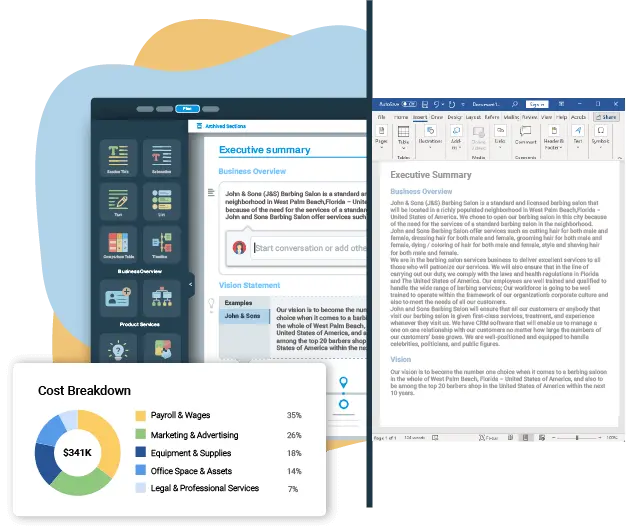
Financial planning is essential for any business to grow, thrive, and succeed.
Whether it’s a new opportunity or an impending threat—planning for different hypothetical situations strategically and financially creates a safety net that safeguards your business from hitting failure.
Well, pro forma statements, with their forward-looking nature, help you evaluate your future finances and strategize for business accordingly.
But what is it really?
In this blog post, we will learn everything about pro forma business plan statements and steps to create.
Ready to dive in? Let’s get started.
What are pro forma financial statements?
Pro forma statements are projected financial statements that predict the future financial position of a business based on current trends and assumptions. These statements offer a snapshot of financials under different scenarios, helping companies plan efficiently.
A pro forma statement serves as a financial blueprint allowing businesses to set realistic goals, anticipate risks, assess outcomes, and track their goals. When included in a business plan, these statements typically include the income statement, balance sheet, and cash flow statement.
Why integrate pro forma statements into your business plan?
Although pro forma isn’t calculated using generally accepted accounting principles, these statements offer significant value while making important strategic decisions.
That said, let’s check out more benefits of adding statements of pro forma projections to your business plan:
- Pro forma statements help secure funding from investors by offering them an insight into your expected profitability, growth rate, ROI, and the overall financial health of your company.
- A pro forma statement aids in strategic decision-making by helping you evaluate the financial impact of different situations. For instance, the impact of launching a new product or expanding into a foreign market.
- Pro forma statements nudge you to make timely adjustments to your business strategies by helping you set and track your financial metrics.
- A pro forma statement helps you prepare for different situations by identifying potential challenges and prompting you to develop efficient strategies.
Types of pro forma statements
Let’s now understand the type of pro forma statements to include in your business plan.
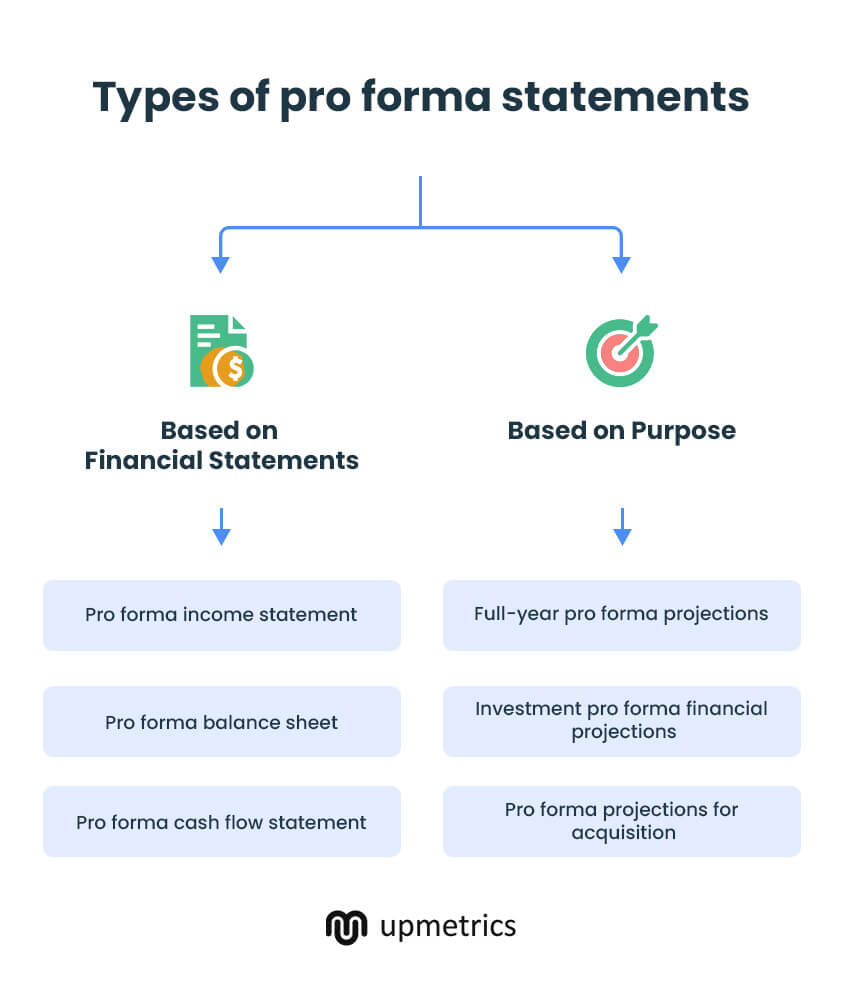
1. Pro forma statements based on financial statements
A pro forma includes three financial statements—pro forma income statement, pro forma balance sheet, and pro forma cash flow statement.
Let’s understand these three types in detail.
Pro forma income statement
The most important aspect of financial planning and management is projecting the sales, revenue, costs, and expenses of a business in the future.
Pro Forma income statements do exactly that. They offer insight into expected revenue and expenses and help you assess a business’s profits and retained earnings in a specific financial period.
Pro forma income statements are often used to evaluate the financial viability of launching new products, business expansion, mergers, acquisitions, and other strategic decisions. These statements help you assess what a business income would look like in certain situations.
Pro forma balance sheet
Pro forma balance sheets are similar to actual balance sheets in terms of formatting. However, certain or all the values in such balance sheets are projected based on certain events such as loans, acquisitions, or mergers.
You can use these balance sheets to assess the financial health of your company at a certain stipulated time in the future. It offers an expected value of assets, liabilities, and equity under different situations, thereby, helping you make informed choices.
Moreover, you can use a pro forma balance sheet to evaluate the impact of a specific loan, acquisition, merger, or financing round on a business’s financials by offering you an overall understanding of making such decisions.
Pro forma cash flow statement
Pro forma cash flow statements illustrate the cash inflow and outflow over a period. It is used to assess the financial health of your company and to ensure that the business never runs out of cash.
Pro forma cash flow projections can be for short-term, mid-term, and long-term. It is often used to evaluate if the company will have enough cash to make significant purchases and investments and to maintain day-to-day operations.
2. Pro forma Statements based on purpose
While an income statement, cash flow statement, and a balance sheet remain quintessential parts of pro forma projections, there are different types of pro forma statements based on distinct purposes.
Full-year pro forma projections
Full-year pro forma statements take into account the financials for the fiscal year till the present time and then add projected outcomes for the remaining year. This will help you illustrate the company’s financial position by the end of the year.
Such statements offer investors a comprehensive overview of the business and its expected performance.
Investment pro forma financial projections
An investment pro forma statement shows how securing a loan and making their interest payout will affect the business’s financial position in the future.
Such financial pro formas are required when you want to convince your business partners about the value of potential financing.
Pro forma projections for acquisition
Such pro forma projections merge the past financial statements of your business and the business you want to acquire to show how the financials would have looked in case of a merger. It helps you decide on acquisition and merger opportunities.
Projections for risk analysis
While preparing your startup financial plan , you need to account for various progressive and aggressive situations that may affect your company’s financial health.
These pro forma statements consider various best-case and worst-case scenarios to evaluate the company’s future financial performance in different situations. It helps you plan for risks and equips you to face them strategically.
Now that you’re aware of the different types of pro forma statements, let’s understand the process of creating pro forma statements useful for your business.
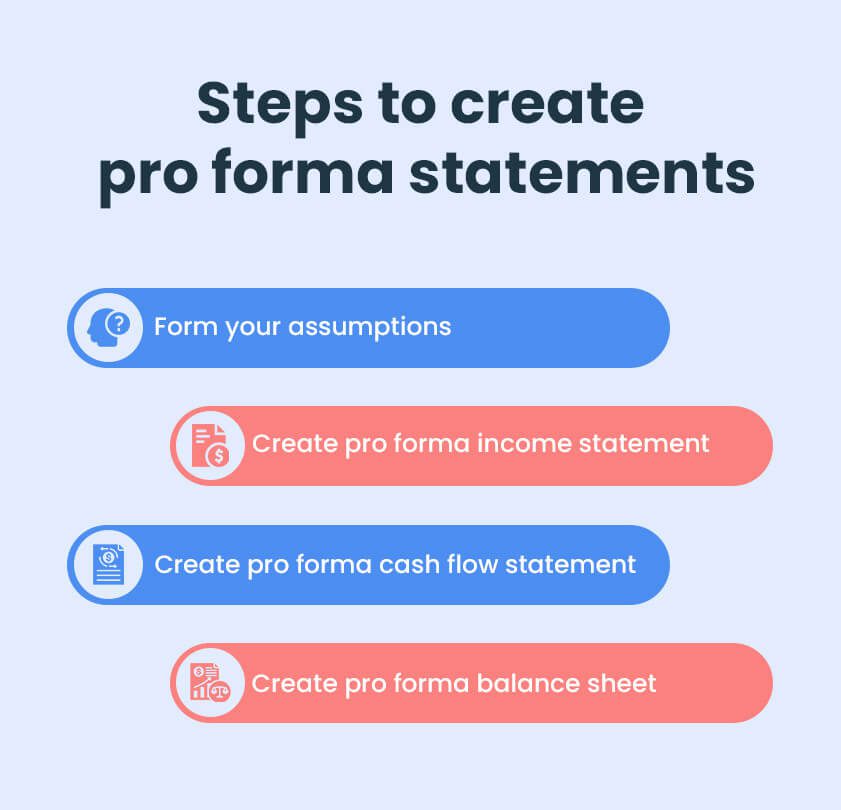
How to create pro forma statements for your business plan
Here’s a quick step-by-step guide to creating your pro forma financial statements.
1. Form your assumptions
To create your comprehensive pro forma statements, you first need to form realistic assumptions for different business components. This includes projecting your sales, expenses, revenue, and capital expenditure for different scenarios.
You should also consider the funding you will require and the investments you would make under different business circumstances.
Ensure that you carry out extensive research and study the historical data to form realistic projections. These projections will form the basis for your income statement, balance sheet, and cash flow forecast.
Say goodbye to boring templates
Build your business plan faster and easier with AI
Plans starting from $7/month

2. Create a pro forma income statement
A pro forma income statement offers an estimate of a company’s financial performance in the future. To get an insight into your expected revenue, expenses, and net profit, create your projected income statement as follows:
- Calculate your COGS (cost of goods sold) and subtract it from your revenue projections to determine your gross profit.
- Estimate your operating expenses. Take everything from rent to salaries into account and then calculate your operating income.
- Also, calculate your other income and expenses and make necessary adjustments to get your net pro forma profit.
Now, place these together in your P&L format and add them to your business plan.
3. Create a pro forma cash flow statement
Next, prepare a pro forma cash flow statement. It’s similar to preparing your actual cash flow forecast. However, here you take the values from your pro forma income statement to plot the cash inflow and outflow.
Be it a new investment, purchase of an asset, repayment of debt, or your operating activities—plot every activity that involves money.
The calculations will either give you a negative or a positive cash flow. To clarify, a negative cash flow indicates a scarcity of money and a positive cash flow indicates extra money at hand to make new purchases or investments.
Now, add your pro forma CFS to the business plan and use it to assess the future cash position of your business.
4. Create a Pro forma balance sheet
A pro forma balance sheet will offer a financial snapshot of your business at a certain point in time in the future. To prepare your pro forma balance sheet:
- List down your current and long-term assets, and calculate your total assets.
- Make note of your liabilities, both short-term and long term to calculate your total liabilities.
- Add your equities, liquidity, and retained earnings from an income statement to your balance sheet.
- Ensure that the liabilities are equal to your assets and add them to your business plan.
Following this, you will have your pro forma statements ready in no time. Ready to jump right in? Let’s take a quick look at a pro forma business plan template to place your statements together.
Pro forma business plan example
Refer to this example of a pro forma business plan and use it as a reference point to build yours.
Executive Summary
In this pro forma business plan, we forecast our company’s sales, expenses, capital expenditures, and funding needs over the next five years. Our projections show positive net income, a strong financial position with increasing equity, and healthy cash flow, underscoring our business’s viability and long-term potential.
Auto Gear, a leader in auto products and services, has been operating for 10 years across 10 countries. With a solid financial track record, we aim to expand into new markets, seeking $8 million in funding to facilitate this growth.
Business Plan Pro Forma
This section provides detailed pro forma statements for sales, expenses, capital expenditures, funding requirements, and cash flow, illustrating the viability and growth potential of Auto Gear.
Sales Forecast
Auto Gear forecasts 20% annual sales growth driven by market expansion, innovation, and enhanced customer service.
- Year 1: $12 million
- Year 2: $14.4 million
- Year 3: $17.28 million
- Year 4: $20.74 million
- Year 5: $24.89 million
Expense Forecast
Auto Gear anticipates slower expense growth due to economies of scale in the long term.
- Year 1: $8 million, 15% increase
- Year 2: $8.8 million, 10% increase
- Year 3: $9.5 million, 8% increase
- Year 4: $10.07 million, 6% increase
- Year 5: $10.58 million, 5% increase
Capital Expenditure Forecast
The capital expenditure at Auto Gear will report a 20% annual growth to accommodate research and new product launch shifts
- Year 1: $2 million
- Year 2: $2.4 million
- Year 3: $2.88 million
- Year 4: $3.46 million
- Year 5: $4.15 million
Funding requirements
Auto Gear needs $8 million in funding for research, new product launches, and marketing to support its expansion in new markets.
Cash flow forecast
Auto Gear’s pro forma cash flow statement predicts positive cash flow throughout the forecast period, ensuring liquidity and operational stability.
- Year 2: $3.2 million
- Year 3: $4.6 million
- Year 4: $5.6 million
- Year 5: $6.8 million
Before we conclude this blog post, here’s one last segment that needs clarity.
Pro forma statements vs. budgets
Pro forma and budgets are important financial statements that offer a future financial overview of your business. However, that’s the only similarity between them.
With this table, you can understand the differences between these two statements better.
| Difference | Pro Forma Statements | Budget |
|---|---|---|
| Meaning | Pro forma statements are financial projections based on hypothetical situations and assumptions. | Budgets are financial plans highlighting the expected expenses and the resource allocation for a specific time in the future. |
| Purpose | To estimate the future financial performance of a company under various scenarios. | To plan and control the financial resources by setting spending limits and monitoring the performance. |
| Uses | Pro forma statements are used to assess a business’s viability and to make strategic decisions. | Budgets are used for cost control and short-term goal achievement. |
Simply put, pro forma projections assist in long-term financial planning while a budget helps in the achievement of short-term goals.
Prepare your Pro Forma Financial Statements with Upmetrics
Accurate and forward-thinking business and financial planning is quintessential to building a successful business.
That being said, pro forma projections offer the numerical perspective of your business’s financial position and performance in the future. It’s much easier to make decisions when you have clearly outlined sales, revenue, expenses, and funding demands in sight.
Don’t worry. It’s quite easy to create your pro forma projections when you have a business planning app like Upmetrics at your disposal.
Its financial forecasting feature allows you to plan for multiple scenarios and create financial statements and projections for up to 7 years. It generates interactive visual reports and offers AI functionality to simplify financial planning.
This easy-to-use tool has everything you need to plan efficiently.
The Quickest Way to turn a Business Idea into a Business Plan
Fill-in-the-blanks and automatic financials make it easy.
Frequently Asked Questions
Is a pro forma the same as a p&l.
Pro forma income statements are based on projections. They reflect the expected revenue, expenses, and profitability of a business under specific situations in the future. Profit and loss (P&L), on the other hand, unless specified as pro forma, reflects the exact figures of revenue and expenses in the current situation.
What’s usually included in the pro forma of the business plan?
The pro forma statements in a business plan typically include an income statement, a cash flow statement, a balance sheet, and sometimes even a break-even analysis. Now, if you’re publicly publishing the pro forma, it’s essential to comply with Securities and Exchange Commission guidelines .
Can a pro forma business plan help in securing loans or investments?
Yes, pro forma when based on realistic assumptions and projections, offers a realistic overview of the company’s financial health in the future. It offers investors a thorough understanding of how their funding will be utilized and the expected profitability, growth, and financial standing of a business.
Are there tools or software that can help create a pro forma business plan?
Yes, there are many tools and resources available to help you create your pro forma business plans. Upmetrics is one of the easiest and most cost-effective business and financial planning tools that will help you create detailed pro forma statements with its automated financial forecasting features.
About the Author
Upmetrics Team
Upmetrics is the #1 business planning software that helps entrepreneurs and business owners create investment-ready business plans using AI. We regularly share business planning insights on our blog. Check out the Upmetrics blog for such interesting reads. Read more

Turn your business idea into a solid business plan
Explore Plan Builder
Plan your business in the shortest time possible
No Risk – Cancel at Any Time – 15 Day Money Back Guarantee

Create a great Business Plan with great price.
- 400+ Business plan templates & examples
- AI Assistance & step by step guidance
- 4.8 Star rating on Trustpilot
Streamline your business planning process with Upmetrics .

Pro Forma Financial Statements: A Comprehensive Guide for Businesses
- Banking & Finance
- Bookkeeping
- Business Operations
- Starting a Business

Pro forma financial statements play a crucial role in business planning and decision-making processes. These financial reports are based on hypothetical scenarios, enabling business owners and managers to evaluate potential situations that could occur in the future. By utilizing pro forma statements, companies can project the financial impact of various business decisions, such as launching new product lines, expanding to new locations, or restructuring a department.
Understanding pro forma financial statements involves various components, such as income statements, balance sheets, and statements of cash flow. Each of these elements provides a financial snapshot of a company’s hypothetical future performance. By combining these components, it is possible to create a comprehensive financial projection that can help inform strategic decisions and evaluate the potential return on investment.
Key Takeaways
- Pro forma financial statements help businesses make informed decisions by evaluating hypothetical scenarios
- Components of pro forma statements include income statements, balance sheets, and statements of cash flow
- These statements are essential tools for strategic planning and assessing the impact of various business decisions
Understanding Pro Forma Statements
Definition and purpose.
Pro forma financial statements are hypothetical financial reports that project the future financial performance of an entity, based on expected income, expenses, assets, and liabilities. They are created using assumptions about future values and conditions, which serve to forecast financial performance over a period that has not yet occurred. Their primary purpose is to aid in business planning, investment decision making, and to show the potential impact of a proposed transaction on a company’s financial health.
Significance to Investors
Investors find pro forma financial statements valuable in evaluating a business’s potential for growth and profitability. These statements help investors to:
- Identify trends: Comparing the projected numbers with historical trends can reveal areas of opportunity or concern.
- Assess risk: By reviewing pro forma statements, investors can see how the business may be affected under various hypothetical scenarios, such as changes in the economy, market, or industry.
- Make informed decisions: Investors can use pro forma statements to estimate returns on investment or potential value of a company, and to decide whether to buy or sell securities.
Differences Between GAAP and Pro Forma
Financial statements prepared using Generally Accepted Accounting Principles (GAAP) are based on a company’s historical financial performance, whereas pro forma financial statements focus on future projections. The main differences include:
- Basis of calculations : GAAP financials use historical data, while pro forma financials use forward-looking data.
- Accounting standards : GAAP financial statements follow strict accounting standards, whereas pro forma financial statements may deviate from these standards, relying on a company’s assumptions.
- Usage : GAAP statements are used to assess past performance, make comparisons across different periods, and analyze trends; pro forma statements are used for planning, forecasting, and scenario analysis.
It is crucial to note that pro forma financial statements should be used in conjunction with GAAP-compliant financials to gain a comprehensive view of a company’s health and potential growth.
Components of Pro Forma Financial Statements
Pro forma financial statements are essential tools for businesses to plan and project their future financial performance. These statements are based on assumptions and estimates, helping companies understand the impact of various scenarios on their financial position. The three primary components of pro forma financial statements are the Pro Forma Income Statement, Pro Forma Balance Sheet, and Pro Forma Cash Flow Statement.
Pro Forma Income Statement
The Pro Forma Income Statement, also known as the projected income statement, provides an estimate of the company’s future revenues and expenses. This statement helps businesses plan for growth, identify potential risks, and make informed decisions based on expected profitability. The main components of a pro forma income statement include:
- Revenue : The projected sales generated by the company during a specific period.
- Cost of Goods Sold : The estimated cost of producing or purchasing the products sold.
- Gross Profit : The difference between revenue and cost of goods sold.
- Operating Expenses : The anticipated expenses associated with running the business, including salaries, rent, and marketing.
- Net Income : The estimated profit or loss, calculated by subtracting operating expenses from gross profit.
Pro Forma Balance Sheet
The Pro Forma Balance Sheet provides an overview of the company’s projected assets, liabilities, and equity. This statement helps businesses understand their anticipated financial position and evaluate their solvency and liquidity. The main components of a pro forma balance sheet include:
- Assets : The resources a company expects to own or control, such as cash, accounts receivable, inventory, and fixed assets.
- Liabilities : The obligations a company anticipates incurring, such as accounts payable, loans, and taxes payable.
- Equity : The residual interest in the company’s assets, representing the difference between assets and liabilities. This includes retained earnings and contributed capital.
Pro Forma Cash Flow Statement
The Pro Forma Cash Flow Statement offers insight into the company’s anticipated cash inflows and outflows, enabling businesses to plan and manage their liquidity. This statement presents an estimation of cash flows from operating, investing, and financing activities. The main components of a pro forma cash flow statement include:
- Operating Activities : The cash flows generated from a company’s core business operations, such as sales and expenses.
- Investing Activities : The cash flows associated with purchases and sales of assets, such as property, equipment, or investments.
- Financing Activities : The cash flows related to borrowing, repaying loans, issuing stock, or paying dividends.
By understanding and utilizing pro forma financial statements, companies can make more informed decisions, develop strategies, and improve their overall financial planning and management.
Creating Pro Forma Statements
Forecasting and assumptions.
When creating pro forma financial statements, the first step is to forecast future revenues, expenses, and other financial data based on a company’s past performance and experience. It is important to make reasonable and educated assumptions to provide an accurate projection of the company’s future financial performance. Some common assumptions used when creating pro forma statements include:
- Expected growth rates
- Changes in market conditions
- Alterations in the company’s strategy or operations
- Expected changes in costs or pricing
Preparing Hypothetical Scenarios
In addition to using historical data and assumptions, pro forma financial statements can incorporate hypothetical scenarios. These scenarios provide a range of possible financial outcomes based on various “what-if” situations. For example, consider a software company that plans to launch a new product in six months. The company can create multiple pro forma statements based on different launch scenarios:
- Scenario 1 : The software product has a successful launch, generating significant sales and revenue.
- Scenario 2 : The software product has a moderate launch, with sales and revenue matching current market conditions.
- Scenario 3 : The software product experiences a weak launch, with sales and revenue falling below market expectations.
Creating a variety of hypothetical scenarios can help gain insight into the potential financial impacts of different decisions, risks, and opportunities.
Projecting Future Performance
Once you have established a solid foundation of assumptions and hypothetical scenarios, you can begin projecting future performance using the pro forma financial statements. This process involves utilizing the following statements:
- Pro Forma Income Statement : Estimates future revenues, expenses, and net income.
- Pro Forma Balance Sheet : Reflects the company’s projected financial position, including assets, liabilities, and equity.
- Pro Forma Cash Flow Statement : Showcases expected cash inflows and outflows, helping a company plan for liquidity needs.
The information gathered from each of these statements can help a company make business decisions, secure funding, and drive strategic planning. In summary, pro forma financial statements serve as a valuable tool for forecasting, preparing hypothetical scenarios, and projecting future performance to ensure a company’s long-term financial success.
Analyzing Pro Forma Statements
Financial ratios and metrics.
When analyzing pro forma financial statements , it is essential to use various financial ratios and metrics to evaluate a company’s performance adequately. These ratios can provide valuable insights into the company’s financial health. Key ratios include:
- Liquidity ratios , such as the current ratio and quick ratio, help assess the company’s ability to meet short-term obligations.
- Solvency ratios , such as the debt-to-equity ratio, evaluate the company’s long-term financial stability and its ability to meet long-term debts.
- Profitability ratios , including the gross margin and return on equity (ROE), gauge the company’s earnings relative to its investments and equity.
- Efficiency ratios , like inventory turnover and the accounts receivable turnover, reveal the effectiveness of the company’s assets management.
These ratios, derived from balance sheets and income statements, can be compared to industry benchmarks to understand how the business is performing against competitors.
Evaluating Business Potential
To gain a clear understanding of a company’s potential for future growth, pro forma earnings must be examined in conjunction with the anticipated financial impact of various business decisions. This analysis enables investors and management to:
- Assess the potential profitability of new projects or investment opportunities.
- Estimate the effect of price changes for products or services.
- Evaluate the implications of business expansions—that may involve mergers, acquisitions, or entry into new markets.
- Gauge the potential impact of changes in cost structures, such as modifications in labor costs.
Using tools like forecasting and scenario planning, decision-makers can estimate the organization’s future financial position and determine actionable strategies to optimize performance.
Risk Analysis
An important aspect of analyzing pro forma statements is identifying potential risks that might affect the company’s financial performance. Risk analysis involves evaluating factors that could negatively impact revenue, increase costs, or alter the overall business dynamics. These factors include:
- Market risks: Changes in consumer preferences, increased competition, or market saturation.
- Operational risks: Disruptions in the supply chain, inefficient production processes, or employee turnover.
- Financial risks: Interest rate fluctuations, exchange rate volatility, or changes in credit terms.
A comprehensive risk analysis enables management to make well-informed business decisions and devise contingency plans to minimize the company’s exposure. This, in turn, helps safeguard the organization’s bottom line and ensure a robust financial standing in the long run.
Strategic Use of Pro Forma Projections
Pro forma financial statements are used by business owners and companies for various strategic purposes. These include business planning and budgeting, funding and investment attraction, and mergers and acquisitions.
Business Planning and Budgeting
Companies use pro forma projections to create a detailed budget, forecasting revenues, expenses, and cash flow, which usually span over three to five years. This provides insights into the financial health and growth potential of the business. It helps companies to:
- Make data-driven decisions
- Identify areas for cost savings
- Determine feasible growth strategies
- Allocate resources efficiently
By leveraging pro forma projections, businesses can test hypothetical scenarios and make informed decisions, effectively planning and structuring their financial activities.
Funding and Investment Attraction
Pro forma financial statements are critical in attracting funding and investments for businesses. These projections provide potential investors with a clear understanding of the business’s:
- Future growth potential
- Risk management strategies
- Financial stability
Investment pro forma projections showcase the company’s ability to generate returns on investments, giving investors the confidence to commit their capital. Business owners can tailor these projections to highlight their business’s unique strengths, ultimately appealing to a broad range of potential investors.
Mergers and Acquisitions
In mergers and acquisitions, pro forma financial statements play an important role in revealing the financial impact of a potential transaction. Companies create historical with acquisition pro forma projections that showcase combined financial position of both organizations. This helps in assessing:
- Expected synergies
- Post-acquisition financial performance
- Integration costs
By identifying these financial outcomes, companies can better evaluate the potential benefits and risks associated with mergers and acquisitions, ensuring that the decision to pursue the transaction is well-informed and in line with their strategic goals.
Real-World Application of Pro Forma
Public reporting and the sec.
Pro forma financial statements often play a significant role in public reporting, especially when dealing with the Securities and Exchange Commission (SEC). Companies may use pro forma statements to present their financial results, adjusted for specific events such as acquisitions or divestitures. This provides stakeholders with a clearer understanding of the company’s financial position and helps them make informed decisions.
Key aspects of pro forma financial statements in public reporting:
- Financial forecast based on hypothetical scenarios
- Used for decision-making by investors, creditors, and other stakeholders
- Adjustments for specified events, such as acquisitions
Case Studies of Successful Use Cases
1. Business Expansion:
A company plans to expand its operations by opening a new manufacturing facility. They prepare pro forma financial statements to estimate the impact on future revenue, expenses, and profitability, considering various factors such as initial investment, operating costs, and expected sales. This helps them align their growth strategy and make informed decisions on whether or not to proceed with the expansion.
2. Mergers and Acquisitions:
A company is considering acquiring a smaller competitor. They create pro forma statements combining their own historical financial information with that of the acquisition target. This enables them to better understand the combined entity’s future financial performance and potential synergetic effects.
3. Restructuring:
A company facing financial challenges decides to restructure its operations to improve efficiency. They use pro forma financial statements to analyze different restructuring scenarios, such as cost reduction initiatives, refinancing options, or divestitures. This assists them in evaluating the long-term viability and profitability of their restructuring plan.
Learning from Pro Forma Mistakes
While pro forma statements can provide valuable insights, they can also be subject to misuse or misinterpretation. Fraudulent activities may involve manipulating pro forma results to present a rosier financial picture than reality, potentially misleading investors and other stakeholders.
To avoid such pitfalls and maintain a neutral and clear stance, companies should:
- Clearly disclose the basis of any adjustments or assumptions made
- Ensure the use of consistent methodologies across multiple scenarios
- Conduct thorough sensitivity analyses, incorporating a range of possible outcomes
- Seek guidance from accounting or financial experts, when necessary
By understanding the real-world application of pro forma financial statements and learning from past mistakes, businesses can use these tools effectively to drive informed decision-making and achieve better outcomes.
Limitations and Criticisms of Pro Forma
Potential for misrepresentation.
Pro forma financial statements may present an optimistic picture of a company’s financial health, intentionally or unintentionally, that differs from the reality per Generally Accepted Accounting Principles (GAAP). The adjusted nature of pro forma statements allows management to exclude certain items that they consider non-recurring or extraordinary. This level of discretion opens the door for worst-case scenarios , where pro forma statements might be utilized to paint an overly favorable picture of the company’s performance, potentially veiling fraudulent activities or significant financial issues.
A relevant example of this issue can be observed in cases when companies release pro forma earnings and provide little or no reconciling information, making comparisons with audited GAAP financial statements difficult. Thus, it is essential for decision-makers, such as investors and analysts, to be aware of the potential for misrepresentation in pro forma disclosures and to remain vigilant in their research and due diligence.
Understanding Limitations in Decision Making
While pro forma statements provide valuable insights for companies’ internal management, their usefulness is limited for external decision-making by investors or other stakeholders. These statements often focus on estimates and projections, rather than actual financial data, which can result in an unclear picture of a company’s performance. Furthermore, pro forma statements might not take into account the full range of worst-case scenarios , increasing the risk inherent in making decisions based on these projections.
In order to navigate the limitations of pro forma statements, it is crucial for decision-makers to:
- Understand the basis : Scrutinize the methods used to create pro forma statements, such as non-recurring items excluded or other adjustments made by management.
- Compare with GAAP : Cross-check the pro forma disclosures with audited financial statements, ensuring a more comprehensive and accurate understanding of the company’s financial health.
- Evaluate risks : Assess the likelihood and potential impact of worst-case scenarios not captured by the pro forma statements, incorporating this knowledge into the decision-making process.
Despite their limitations, pro forma financial statements have a place in financial planning and forecasting. However, recognizing their limitations and staying cautious in the decision-making process is key to fully leverage their value while avoiding potential pitfalls.
Legal and Ethical Considerations
Gaap compliance.
Pro forma financial statements should adhere to Generally Accepted Accounting Principles (GAAP) in order to provide accurate and reliable information to investors and other stakeholders. While pro forma statements are used to illustrate the potential impact of a significant transaction on historical financial data, they must still adhere to GAAP requirements, which are designed to ensure consistency and comparability across different financial reports.
For example, when preparing pro forma financial statements, the following GAAP principles should be considered:
- Revenue Recognition : Ensure that revenue is recognized in accordance with GAAP standards, which typically means recognizing revenue when it is earned and realizable.
- Consistency : Apply accounting policies and methods consistently across all financial reports, including pro forma statements, to ensure comparability between different periods and scenarios.
- Conservatism : Exercise caution in making assumptions and estimates when preparing pro forma statements, to avoid overstating potential revenues or understating potential costs.
It is also important to keep in mind that the SEC (Securities and Exchange Commission) requires companies to provide a thorough and compliant pro forma financial information when significant business combinations or real estate transactions occur.
Addressing Fraudulent Pro Forma Practices
As with all financial reports, there is a risk that pro forma financial information could be used for fraudulent purposes. To mitigate this risk, companies should implement certain policies and procedures to ensure the accuracy and integrity of their pro forma statements:
- Internal Controls : Implement robust internal controls over the financial reporting process, including controls related to the preparation of pro forma statements. This may involve segregating duties between those who generate the data for the pro forma statements and those responsible for reviewing them.
- Documentation : Maintain detailed records supporting the assumptions and estimates used in the preparation of pro forma statements. This documentation should be readily available for review by auditors or regulatory authorities when necessary.
- Transparency : Clearly disclose the basis for any adjustments made in pro forma statements, such as one-time charges or non-recurring items. This includes providing a detailed reconciliation between historical financial statements and the pro forma information.
- Oversight : Establish a process for independent review and approval of pro forma financial information by individuals with appropriate expertise, such as an audit committee or external auditor.
In summary, ensuring legal and ethical compliance in pro forma financial statements is crucial to maintain investor confidence and uphold the integrity of financial reports. By adhering to GAAP requirements and implementing safeguards against potential fraudulent practices, companies can produce accurate and reliable pro forma information that effectively illustrates the potential impact of significant transactions on their financial position and results of operations.
Frequently Asked Questions
What is the purpose of pro forma financial statements in assessing a company’s financial health.
Pro forma financial statements provide a hypothetical look at how a company would perform based on a set of credible assumptions about one or more transactions it is contemplating. This enables businesses to evaluate the potential impact of new product launches, expansions, or other strategic decisions, making them essential tools for planning and decision-making.
How do pro forma and traditional profit and loss statements differ?
Traditional profit and loss statements are based on actual financial results, providing an accurate representation of a company’s past performance. Pro forma statements, on the other hand, are based on hypothetical scenarios, such as the impact of a specific business decision or a future event. In essence, pro forma statements are projections, while traditional statements are historical records.
What distinguishes pro forma financial statements from prospective financial statements?
Pro forma financial statements are projections that consider hypothetical situations, such as a proposed transaction or a new product launch. Prospective financial statements, on the other hand, provide a forecast of a company’s future financial position based on current business conditions and expected trends. While both types of statements involve predictions, pro forma statements focus on specific scenarios, whereas prospective statements provide a broader outlook on the company’s potential performance.
Are there specific instances where pro forma financial statements should not be utilized?
Pro forma financial statements are most useful when analyzing potential business decisions or anticipating the impact of future events. However, they should not be used as a substitute for traditional financial statements when assessing a company’s overall financial health or stability. Additionally, pro forma statements can be misleading if based on unrealistic or overly optimistic assumptions, and users need to scrutinize their underlying premises carefully.
Is adherence to GAAP required for pro forma financial statements?
While pro forma financial statements are not subject to the same strict adherence to Generally Accepted Accounting Principles (GAAP) as traditional financial statements, it is essential to maintain transparency and consistency in the presentation and preparation of these projections. Misleading or inaccurate pro forma statements can result in a loss of credibility and trust with stakeholders, making it crucial to approach them with integrity and objectivity.
How do pro forma financials assist in cash flow forecasting and management?
Pro forma financial statements, including cash flow statements, provide insights into a company’s anticipated cash inflows and outflows based on specific business scenarios. This allows management to anticipate potential liquidity issues, evaluate financing options, and make informed decisions regarding cash flow management. In essence, pro forma cash flow statements contribute to strategic planning and help minimize financial risks.
- 1-800-711-3307
- Expense management
- Corporate card
- Tax returns & preparation
- Payment processing
- Tax compliance
- Vision & clarity
- Accounting mobile app
- Reduce your accounting expenses
- What does a bookkeeper do
- Why outsource
- Cash vs. Accrual Accounting
- Guides & ebooks
- How Finally works
- Privacy policy
- Terms of service
*Finally is not a CPA firm © 2024 Finally, Backoffice.co , Inc. All rights reserved.

This device is too small
If you're on a Galaxy Fold, consider unfolding your phone or viewing it in full screen to best optimize your experience.
- Small Business
- The Top 10 Accounting Software for Small Businesses
What Are Pro Forma Financial Statements?
See Full Bio
Our Small Business Expert
In accounting, pro forma refers to financial reports based on assumptions and hypothetical situations, not reality. Businesses use pro forma financial documents internally to aid in decision-making and externally to showcase the effect of business decisions.
Before acquiring another business, investing in new equipment, or taking on new debt, businesses draft forward-looking pro forma financial statements to understand the effect. Unlike traditional financial statements that explain the past, pro forma documents usually look forward and rely on financial modeling and speculation.
Pro forma statements take on a slightly new meaning with public companies. After a major acquisition, a public company must prepare a secondary balance sheet and income statement as if the purchase occurred at the beginning of the year. We put the “pro forma” label on these financial documents because there’s a lot of “what if” involved in their making.
“What if” doesn’t jibe with Generally Accepted Accounting Principles (GAAP). Straying even further from GAAP, pro forma financials exclude unusual one-time expenses, such as restructuring costs. Critics say pro forma financial statements are ploys to excite investors about the benefits of a business combination, what finance nerds call “synergies.”
The Securities and Exchange Commission (SEC) consistently updates its stringent rules on preparing pro forma statements for the public. Still, pro forma financials are not regulated to the same extent as historical financial statements.
3 types of pro forma statements
Small business owners can use pro forma statements to draft forecasted financial statements, budgets, and quotes.
1. Forecasted financial statements
Small business owners draft pro forma financial statements to quantify the impact of potential business decisions, such as taking out a loan to grow your business. Pro forma financial statements give you and your team something to consider before signing on the dotted line.
The most common pro forma financial statements are projected balance sheets, income statements, and cash flow statements. Together, the documents help you assess whether your business’s financial health improves, declines, or remains the same following the decision.
Say you’re a business owner contemplating a loan to invest in more efficient equipment. Your current equipment still works, but the cutting edge technology in newer machines can speed up production by 20%. You’re not sure what to do.
Guide your decision-making by creating two sets of forecasted financial statements: the first to project next year’s net income if you take out the loan, the second if you don’t.
If you take out the loan, you might share the pro forma financial statements with the lender to demonstrate your ability to repay the loan. Businesses also use pro forma financial statements to prod investors to provide capital.
Since we can’t predict the future, don’t rely solely on pro forma financial statements. Your assumptions could wind up wrong, throwing off your financial projections.
Businesses create annual budgets that fall in line with a company’s profitability and production goals.
Budgets and projected financials are similar in that they both factor in assumptions and scenarios that remain to be seen. Where they differ: Budgets are managerial accounting documents, meaning they’re meant to guide business decisions and aren’t to be shared publicly. Budgets provide more detail than you’d care to share with a lender, and they’re more nearsighted, usually focusing one year ahead.
3. Pro forma invoices
The best way to package a quote for your goods and services is by using a pro forma invoice, also called a draft invoice.
Before delivering an actual invoice, send a client a pro forma invoice that lists the cost of the goods and services you’re planning to provide. A pro forma invoice isn’t binding; it’s a way to make sure you and the client are on the same page before agreeing to the transaction. The transparency could score you points for customer satisfaction.
Your accounting software can make pro forma invoices.
An example of pro forma
Russell operates a life coaching business. Word has gotten around that Russell is the absolute best, and he has more prospective clients lined up than he has time to take on. Russell is considering hiring an assistant to lighten his administrative workload, but he’s unsure whether he can afford to pay someone full time. His options are:
- Not hiring an assistant
- Hiring a part-time assistant
- Hiring a full-time assistant
Russell creates a pro forma income statement for next year to inform his decision. He dedicates a column for each scenario he’s considering. Russell follows The Ascent’s guide to forecasted financial statements to generate the document.

Create multiple pro forma documents to play out different scenarios. Image source: Author
According to Russell’s projections, he reaches the highest earnings when he hires a full-time administrative assistant. More significantly, the pro forma income statement reveals that hiring a part-time assistant is nearly as lucrative as bringing someone on full-time.
I’d advise Russel to hire a part-time assistant to reduce the risk of sinking nearly $60,000 into a new position when he’s not sure he’ll see the increased revenue he’s expecting. He can always offer the person a full-time job after his projection actualizes.
Not all pro forma documents are made equal. Pro forma financials have their place, but some public companies have taken advantage of loose rules to mislead potential investors.
For small, private companies, pro forma financials can help you see the long-term impact of decisions you’re considering today. Nobody is dissing the use of pro forma reports here.
The dot-com bubble, where tech companies enjoyed bloated market valuations before losing it all, proved the harm of pro forma financials. In the early 2000s, Yahoo caught heat after years of releasing pro forma financial statements that downplayed hefty one-time costs from business acquisitions.
Public companies release pro forma financials under the guise of clarifying their financial position after a business acquisition. They take out one-time or unusual costs to offer a fuller picture of the business’s operating profit. To some, pro forma financials feel like companies are creating their own financial accounting rules to engineer appealing financial results.
Since the dot-com bubble burst, the SEC has cracked down on using pro forma financials to protect the public from being misled.
Before extending capital or credit, investors and lenders might ask for pro forma statements to understand your outlook on company performance. For new businesses with no historical financial statements , lenders look at pro forma statements for a realistic vision of your company’s future.
After you create pro forma financial statements to inform a business decision, run a pro forma analysis to assess your company’s profitability.
Say you own a small restaurant, and you’re considering extending your business hours and hiring a new waiter. You drafted a balance sheet, income statement, and cash flow statement for next year, assuming increased utility, wages, and food expenses.
Analyze the results using profitability metrics. If the measures point to increased profitability, you might have hit on a winning opportunity for your restaurant.
It’s not called “amateur forma” for a reason
Building accurate pro forma financials requires an in-depth financial analysis of your present business. When creating pro forma financial statements, ask an accountant to provide additional guidance.
We're firm believers in the Golden Rule, which is why editorial opinions are ours alone and have not been previously reviewed, approved, or endorsed by included advertisers. The Ascent, a Motley Fool service, does not cover all offers on the market. The Ascent has a dedicated team of editors and analysts focused on personal finance, and they follow the same set of publishing standards and editorial integrity while maintaining professional separation from the analysts and editors on other Motley Fool brands.
The Ascent is a Motley Fool service that rates and reviews essential products for your everyday money matters.
Copyright © 2018 - 2024 The Ascent. All rights reserved.
Mastering Pro Forma Financial Statements: The Three You Need
By Andy Marker | November 26, 2018
- Share on Facebook
- Share on LinkedIn
Link copied
Using pro forma templates can save you valuable time when creating your own pro forma income statements. However, like any template, you need to adjust it to suit your needs.
In this guide, you will learn everything you need to know about pro forma financial statements: what they are, how they’re regulated, how they work with financial modeling, how to create them, and the problems with pro forma projections, statements, and sheets. We’ll show you what variables link the three sheets, along with equations, examples, and a sampling of free, downloadable pro forma templates.
What Are Pro Forma Financial Statements?
Pro forma financial statements present the complete future economic projection of a company or person. Often used to back up a lending or investment proposal, they are issued in a standardized format that includes balance sheets , income statements, and statements of cash flow. “Pro forma” literally means “as a matter of form.” In finance, this matter of form forecasts the future based on the present, using hypothetical budgeting. Pro forma data estimates are built in to show the company’s profits if certain, one-time items are taken out. Anything the company sees as a one-time only expense — or that does not show the company’s representative value — is removed. Instead of tracking the past exactly, such as would be reported in historical income statements, pro forma statements are used to guide big financial decisions, such as the following:
Debt Refinancing : How the short term is affected by refinance options.
One-Time Large Purchases : Purchases such as land or services, and how they affect the budget.
Company Mergers or Acquisitions : Complete as a part of due diligence to assess future business operating prospects and valuation. In startups, this is often a way to find venture capital.
Leases : How big leases, such as buildings or vehicles, will affect the budget with new accounting standards.
You can also use pro forma statements to do the following:
Develop various sales and budget projections.
Assemble results in profit/loss projections.
Translate data into cash flow projections.
Identify the company assumptions about their financial and operating characteristics.
Compare balance sheets.
Perform financial ratio analysis.
Make decisions about marketing, production, research, development, and projects.
Show the financial picture of a company sans a specific program or department may be floundering.
Show a more accurate picture of the company’s finance, as compared to GAAP or IFRS accounting frameworks.
Act as a benchmark.
Motivate your staff.
Used to show company results to investors, pro forma financial statements are often combined with generally accepted accounting principles (GAAP) adjusted statements. Pro forma financial statements are not computed using GAAP and are often called non-GAAP. GAAP-adjusted statements are uniform financial statements guided by rules of the Financial Accounting Standard Board (FASB). They differ from pro forma statements in that they are not projections, but rather historical reports — therefore, they do not consider things like litigation costs, restructuring charges, and other one-time items.
Pro forma analyses are meant to paint a better picture of what is happening with the company, irrespective of one-time events, but considering the specific industry’s standards. In some respects, this type of analysis is a more accurate depiction of the company’s financial health and outlook. Further, organizations may want to develop their pro forma financial statements while they are doing an annual review of their business plan.
Pro Forma Financial Statements and Regulation
The Securities and Exchange Commission (SEC), the United States’ regulator of its stock market, requires pro forma statements with any filing, registration, or proxy statement. They have articles governing the preparation of pro forma financial statements for public companies. These are Regulation S-X Article 11 , and Regulation S-X 8-05 for smaller companies from 17 CFR 210. According to the SEC, pro forma financial statements will be prepared for public companies when something happens that the investors should know, such as in the case of an acquisition, jettison of a business, real estate transactions, roll-ups, spin-offs, changes in accounting principles, changes in accounting estimates, or corrections of previously made errors. Additionally, the SEC may require that pro forma financial statements be submitted when a company is filing for an initial public offering (IPO). This is also true of companies that change tax status from a private, nontaxable company to a taxable C-corporation to file for an IPO. The pro forma financial statements, including pro forma earnings per share calculated, must be submitted. Finally, if substantial changes to the firm’s capitalization (the sum of their stock, debt, and retained earnings) are assumed to change substantially after the offering’s close date, pro forma documents must reflect that.
A financial forecast may be used in lieu of pro forma financial statements. According to the SEC, this does not take the place of the pro forma balance sheet, but the pro forma income statement may be withheld. The difference is that the financial forecast details the company’s expected results of operations as a single-point estimate or a range. The legal liability of the company may increase upon submitting forecasts instead of pro forma income statements, but the practice may be more relevant for certain businesses.
Not only does the SEC regulate pro forma statements, but the FASB and the AICPA provide directives, especially when there are major changes in the business structure. To evaluate a new or proposed business structure in pro forma documents, these agencies say that the statements must conform with those of the predecessor business. For businesses that are going public and have to transform into a corporation, the predecessor business may not contain items relevant to a corporation, so the following adjustments must be made:
State the owners’ salaries as officers’ salaries.
Recalculate the federal taxes of the predecessor business as though it were a corporation.
Include corporate state franchise taxes.
Add the partner capital balance to the contributed capital instead of to retained earnings through pooling of interests.
Consider making pro forma provision for taxes that would have been paid if the company was a corporation in the past.
For businesses that previously acted as a partnership or sole proprietorship that are being acquired into a corporation, the statements must reflect that of the acquiring business. This includes that business’ net sales, cost of sales, gross profit on sales, expenses, other income and deductions, and income before taxes.
If a business is acquiring a new business or disposing part of its business, the pro forma statements need to adjust the historical figures to reflect this, and to show, in the case of an acquisition, what a corporation would have looked like separately, but added together. If possible, show a five year projection of the businesses together. There’s no need to include overhead costs. For the effects of the business combination, only show the current and immediately preceding periods.
Financial Modeling Based on Pro Forma Projections
Since pro forma financial statements and financial projections are quite similar, they may be considered synonymous. However, financial projections can be built from nothing for a startup company, using specific industry-specific assumptions. By contrast, pro forma financial statements are based on current financial statements and change based on events and assumptions. In other words, pro forma financial statements start from real financial data.
Compiled pro forma financial statements can form the basis for calculating financial ratios and financial models, which test assumptions and relationships of your company’s plan. You can use them to study how changes in the price of labor, materials, overhead, and the cost of goods affect the bottom line. Use these models to test the goals of a company’s plan, provide findings that may be understood, and offer better, more accurate data than other methods. New financial models use computer programs that has made this testing better, which enables quick calculation for real-time decision making.
Industries That Use Pro Forma
Industries that use pro forma as a concept, whether for financial statements or not, include the following:
Accounting : Pro forma financial statements are compiled for other companies to show the health or true picture of an organization when the GAAP statements are insufficient. Companies are cautioned against using pro forma to obscure GAAP statements.
Business : There are many uses in business for pro forma financial statements. Anytime a transaction is scheduled, such as a merger, acquisition, capital investment, or change in capital structure, pro forma is used as a projection. The pro forma shows the projected cash flow, net revenues, or taxes expected. The business plan will include pro forma financial statements that show the effect of the proposed change, project, or new business. Some banks require pro forma statements to verify cash flow prior to issuing a line of credit.
International Trade : When used in international trade, pro forma invoices are a declaration to customs authorities about the details of the transaction. A pro forma invoice is a precursory bill of sale for buyers that is sent before the delivery of goods or services. The statement is a binding agreement, not just a quote, although the terms may be subject to change. The sale price is often precise and includes commissions, fees, taxes, and shipping costs, and benefits the buyer, so that they are not exposed to major changes during the final transaction. The invoice is not a demand for payment or a bill. In the U.S., a commercial invoice must follow a pro forma invoice for customers within 120 days. Sometimes the use of these pro forma invoices is referred to as “on a pro forma basis.”
Use this Excel pro forma invoice template to create your own pro forma invoices.
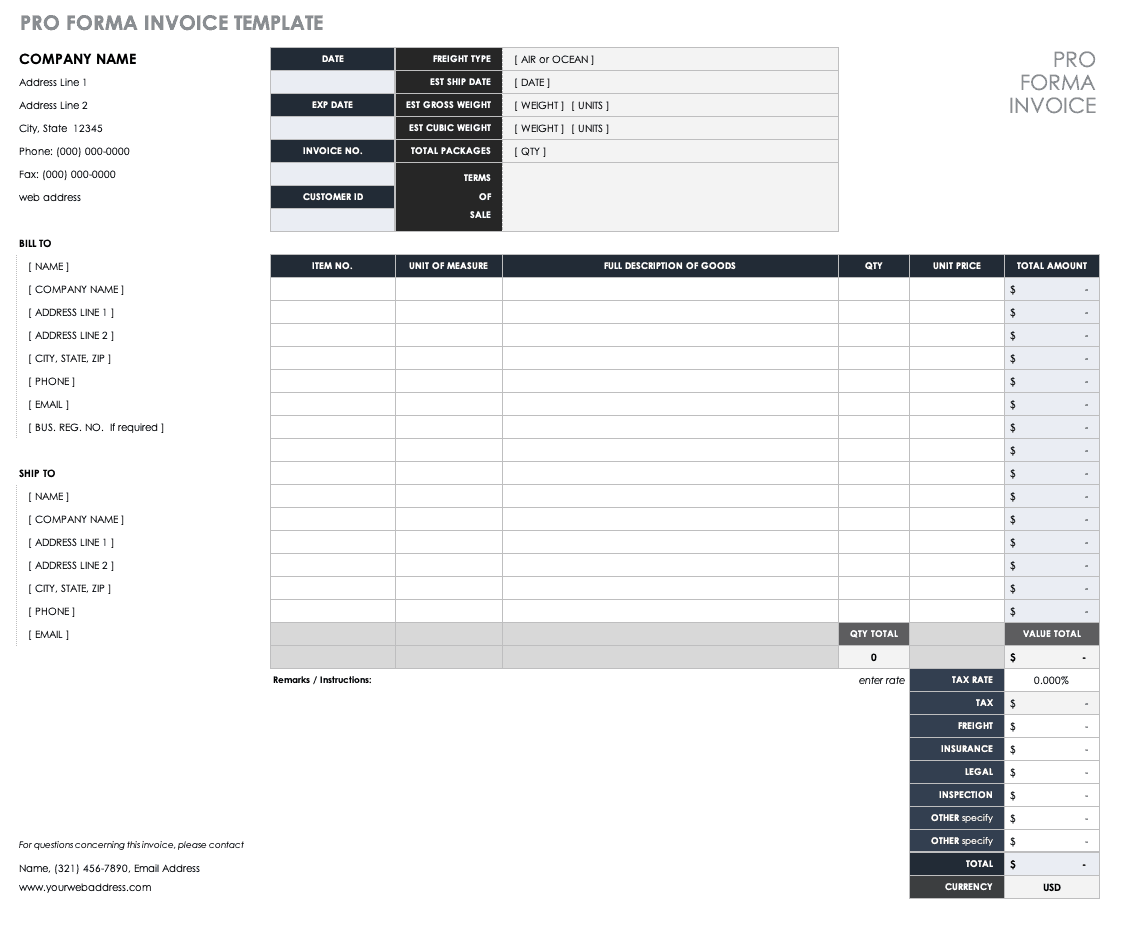
Download Pro Forma Invoice Template
Excel | Smartsheet
Law : In legal terms, pro forma means something that satisfies minimum requirements. Pro forma court rulings are made as formalities to facilitate the legal process.
Engineering : Pro forma drawings and templates are used to make agreements with customers and to project the financial basis of projects
Government : In Commonwealth systems, pro forma bills are first drafts of legislation that go through the reading stage. They are symbolic of the parliament’s right to discuss matters aside from those mandated by the head of state. They do not go further than the first reading. Pro forma bills are found in the United Kingdom, Canada, and Australia. In the United States, pro forma sessions are brief meetings of the Senate or House of Representatives. No votes are taken, and no legislative business is generally conducted during a pro forma session. Often, these sessions are held to ensure that both chambers of Congress uphold their requirement to meet every three days during a congressional session. Another reason these may be held is to ensure that the president does not make any recess appointments.
Problems with Pro Forma Analysis
Even though pro forma statements are meant to show a more accurate picture of the business’ profitability, there are many ways to manipulate the documents to give a more favorable representation, as there are no universal guidelines for their compilation. The following details are often left out of the pro forma:
Depreciation
Amortization
Restructuring and merger costs
Interest and taxes
Stock-based employee pay
Losses at affiliates
One-time expenses
Many of the items listed above are part of the GAAP, but not included in pro forma reporting, making it rife for possible deception. This discrepancy is part of the reason the distinction between pro forma and GAAP financial statements is important. Sometimes, in pro forma documents, unsold inventory is even excluded. Not all these things should be left off, but the decisions of what is left off should be well thought out and explained to potential investors, so they have a clear indication of what they are viewing. Knowing how the pro forma documents are compiled and what is left out is also critical when comparing different pro forma statements. Understanding this methodology and the decisions behind it will enable accurate comparisons and information to investors.
Be advised that issuing pro forma financial statements to the public can be problematic, especially since the pro forma statements and the GAAP statements can vary so widely. Investors should be cautious when evaluating these types of statements because they present a considerably more favorable picture of the business.
Documents in Pro Forma Financial Statements
There are three main documents in pro forma financial statements: balance sheets, income statements, and statements of cash flow. Of the four main financial statements, only the statement of changes in equity is not used in pro forma. Further, the other three main financial statements are amended to project for the specific scenario, making them pro forma.
For publicly-held companies, the SEC requires an introductory paragraph showing the proposed transactions, the company, the period covered, and what the pro forma information describes. The SEC also requires the pro forma balance sheet, pro forma income statement(s), and explanatory notes that provide adjustment justifications and pertinent detail. The statement of cash flow is not required. The pro forma financial information should be presented in columns and show the condensed historical amounts, the pro forma adjustments, and the pro forma amounts. GAAP-conforming financial statements must be included with pro forma submissions.
Pro Forma Income Statement
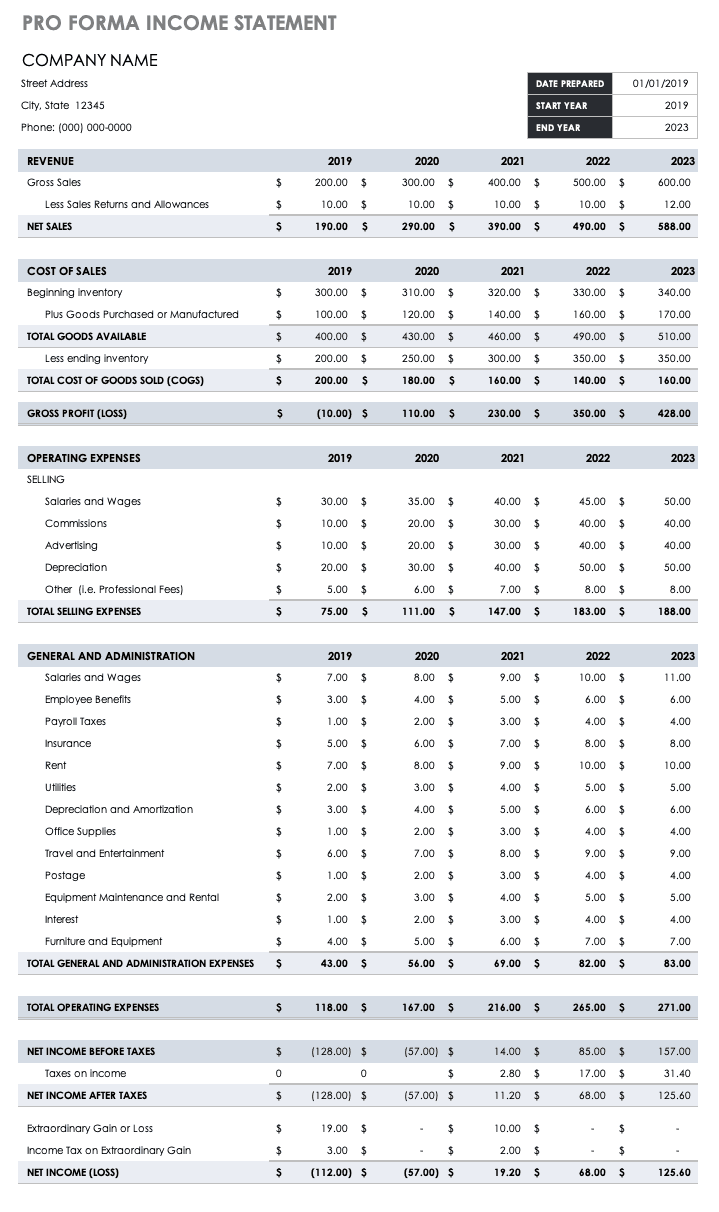
Pro forma income statements , also called pro forma profit and loss (pro forma P&L), are projections based on your past income statements. Regular income statements, sometimes called statement of financial performance , are exacting, in that they reflect the exact income figures your company had in past years. The pro forma income statements considers past data, but its projections reflect the addition or subtraction of events or things. These statements are vulnerable to inaccuracies and changes.
Pro forma income statements usually project a minimum of three years, whereas regular income statements may just be the year prior or based upon a lender’s request. According to the SEC, when required for public companies, pro forma income statements are required for the fiscal year, but not for interim periods. However, for all regular income statements presented in a filing, there must also be a pro forma statement. Use this pro forma income statement template to create your own. This form may also be used for corporate retail or wholesale companies.
Download Pro Forma Income Statement Template
Pro Forma Balance Sheet
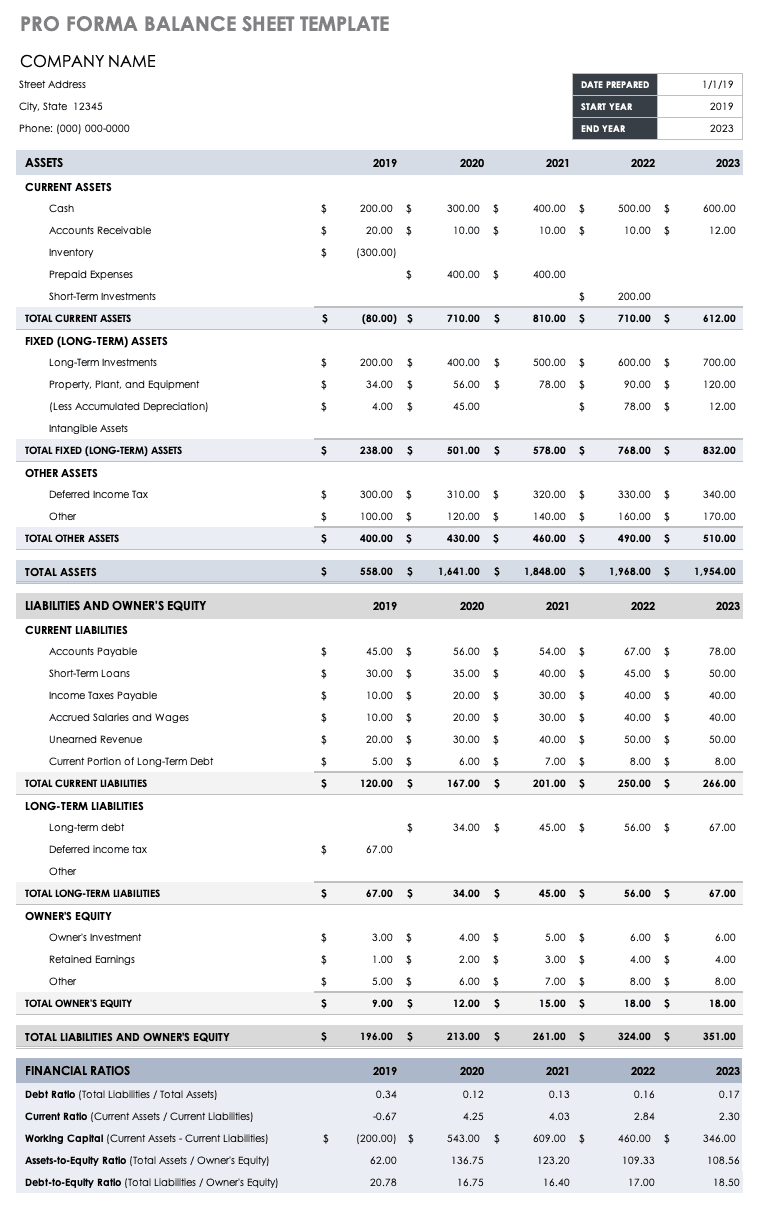
A pro forma balance sheet is a comparison of a business’ assets and liabilities. It provides a snapshot in time of the company’s finances. The pro forma part of the balance sheet is a projection that looks ahead, assuming certain things will occur. Pro forma balance sheets are difficult to compile, but banks generally ask for them and they are important for showing your potential financial picture. They can show the projection of what money will be tied up in receivables, equipment, and inventory. Further, they can represent if your company could run out of money, and how much is necessary to keep it afloat. If your company has a high debt-to-equity ratio, it will show on the balance sheet. Use the balance sheet template below to create your own balance sheet. This pro forma balance sheet can also be used for corporate retail or wholesale businesses.
Download Pro Forma Balance Sheet
According to the SEC, for public companies, a pro forma balance sheet should have the same dates, plus one year from the last submitted balance sheet. If interim period balance sheets were submitted, the company should pick up from where they left off. If it is an annual period, the document should also align with the company’s filed GAAP-approved financial statements.
Often, the difference between a past balance sheet and a pro forma balance sheet is that the pro forma balance sheet reports additional periods, sometimes even interim figures. Public companies that prefer to use a condensed combined balance sheet can use this template to create their own condensed balance sheet. A normal balance sheet covers two years, but it is reasonable for a pro forma balance sheet to cover four years of operations.
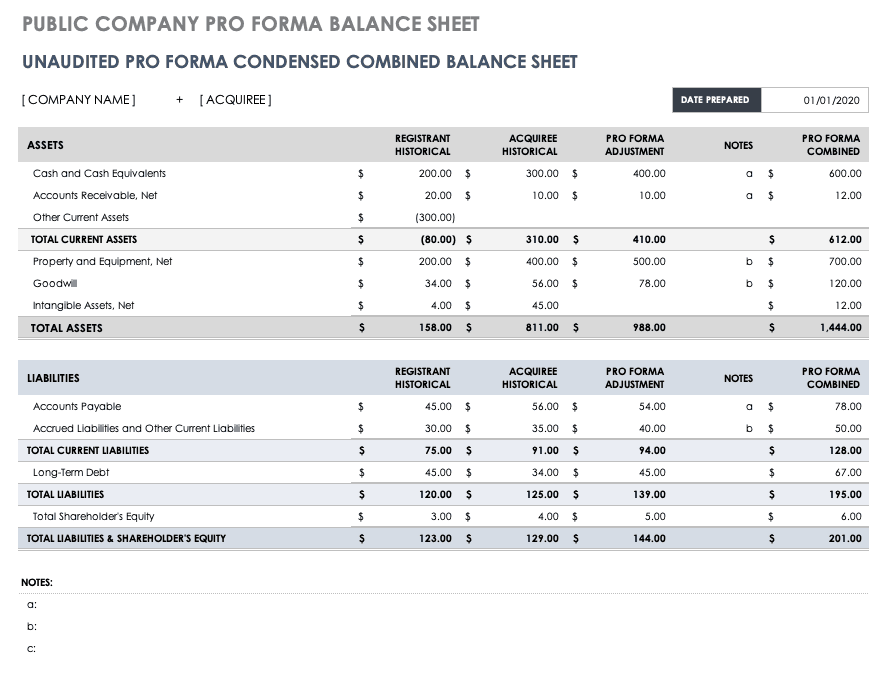
Download Public Company Pro Forma Balance Sheet Template
Pro Forma Statements of Cash Flow
Statements of cash flow , or cash flow statements , measure the sources of a company’s cash and how it uses that cash over the stated period. Pro forma statements of cash flow estimate how much cash inflow and outflow is expected in one or more future periods. Often requested by banks, they may also be prepared as a part of the annual budgeting or forecast and estimate where cash shortages may occur in order to obtain additional funding. In the case of estimated cash overages, the company can produce a plan for investment. Arguably, the statement of cash flow is the most important of the pro forma documents. If the pro forma balance sheet and income statements lead to a statement of cash flow that shows inadequate funds for what management has planned, the other documents will be invalid and may need to be reworked.
There are several methods to prepare a pro forma cash flow document, relative to the forecasting periods:
Short Term : A cash flow statement that represents a period of weeks, based on outstanding invoices and cash payments for existing accounts payable. This is considered the most accurate forecast.
Medium Term : Estimate the revenue from things that have not been billed yet by using the order backlog and the cash receipts for the next few months. The expenses from this time are also translated into cash payments.
Long Term : Budgeted revenue and expenses are translated to payments, costs, and cash receipts. This is the least accurate projection.
In the annual averages, the figures should not vary significantly. However, the information is affected by outstanding estimated days of sales, or the average number of days that payment has not been made by the customers. The closer the projection is to the actual numbers reported, the more accurate it is. Further, if a company has a stable order backlog, the pro forma statement of cash flow is more accurate. Having knowledge of short-term sales sources help as well. Finally, and regardless of its relative accuracy, a pro forma statement of cash flow forces management to think about the future expected cash flow and whether it is enough.
Use the templates found here to create your own cash flow statement forecast. Change the dates and time periods to reflect the projection you need to create. This form may also be used for corporate retail or wholesale companies.
The Introductory Paragraph
If your company must produce an introductory paragraph with its pro forma documents, it should describe the content of your pro forma documents. This means that it should define the transaction, the entities involved, and the periods of time. In this paragraph, you should offer a high-level explanation of the limitations and assumptions the pro forma documents were produced under. For example, if your company recently acquired or dispensed with another company, the assumptions would be the changes in finance expected. The limitations should discuss the challenges of predicting the financial future of a company.
Explanatory Notes
The assumptions behind these adjustments should be explained in the explanatory notes, and the explanatory notes should be referenced in the column the adjustment is made. Explanatory notes are used to add explanations or more information in financial documents that explain the content. (These are put into the explanatory notes, or sometimes listed as references, because they would make the main content too long or awkward to read.)
Pro Forma Earnings Per Share
Pro forma earnings per share (EPS) are calculated by dividing a firm’s net income (and any adjustments) by its weighted shares outstanding, plus any new shares issued due to an acquisition. These are changes to the expected results of operations. This metric determines the financial outcomes of any acquisition or merger and tells the parent company whether the transaction will be accretive (good) or dilutive (bad) to the financial state of the company. Pro forma EPS are calculated in the pro forma income statement, but the figure is also used in the pro forma balance sheet and the pro forma cash flow statement, when necessary. According to the SEC, when the dividends from stock exceed or are planned to exceed the current earnings, the EPS must be calculated. The SEC assumes that that proceeds from any additional shares will be used to fund dividends.
Pro Forma Adjustments
When your financial statements are put into pro forma financial statements, you adjust material charges, credits, and tax effects to the transactions. In other words, you get an idea of what your financial results would have been if the event had already occurred. These are factually supported by the data from the original financial statements.
It is important to disclose how the adjustments are made on pro forma financial statements. Below is the guidance that the SEC offers about making the adjustments:
Directly Attributable : Each adjustment on the financial statements must precisely correlate to the transaction or event from the original financial statements, and then describe how it is changed.
Continuing Impact on the Registrant : The SEC assumes that any adjustments to the financial statements reflect changes that are not temporary. The goal is to find the stream of earnings from core operations, which can be used to forecast. The adjustments you make for forecasting must impact your company for a minimum of one year. Non-recurring events, such as a one-time, big order for goods should be placed in the pro forma balance sheet as an adjustment to the retained earnings, but would be inappropriate in the pro forma income statement. In other words, you need to point out that the event or purchase is not a trend and therefore, that you cannot forecast based on it.
Factually Supportable : In order to consider adjustments, you must provide existing, factual documentation, such as contracts, letters of intent, or completed transactions. For example, management’s plans to revamp the business section and their estimated costs may not be considered factual support. Letters of intent from vendors for this project may be considered factual evidence.
Getting Auditors Involved
Even public companies are not required to get their pro forma document audited by an independent auditor, according to the SEC. However, to comply with professional auditing standards, the documents can be audited at the request of the company or a third party. The SEC guides auditors to ensure that they do not take on too much responsibility for the company’s claims. Whether in an assurance that the company is financially sound, also known as a comfort letter , or through a compilation letter, the auditor is only responsible for ensuring the financial statements are prepared correctly. The auditor is not responsible for whether the statements are accurate and honestly prepared, but rather to ensure that there are no material errors, such as mathematical errors, oversights, inadequate disclosures, and clerical mistakes. The company’s management is responsible for the documents’ overall validity.
Accountants who prepare companies’ pro forma financial statements are bound by certain requirements, as per the American Institute of Certified Public Accountants (AICPA)’s Statements on Standards for Accounting and Review Services (SSARSs). The SSARSs say that the auditor promises no material modification to the historical financial documents and understands that they are simply showing changes to the company’s financial picture based on a transaction or event using adjustments. They must also ensure they label all pro forma information as such, to avoid confusion with historical information, and list the specific assumptions and uncertainties about them they are making.
The conditions accountants take on include the notation that they may be associated with the statements’ outcomes (so they should consider how the information may be used) and to also submit a compilation report alongside the prepared documents. They are warned that they must have the historical financial information (not just condensed information) alongside their preparation, and that those statements should have been compiled, reviewed, or audited.
To ensure everyone is on the same page, the auditor and the organization’s management should write an understanding of the services being provided. These may include the following:
The objective of pro forma documents is to help management present their information.
The auditor is not responsible if the company made material modifications to the finance information.
Management is ultimately responsible for the pro forma information presentation.
Management is responsible for the internal processes used to garner information.
Management is responsible for any fraud.
Management is responsible for the company to obey the law.
Management is responsible for providing all the pertinent information to the auditor.
Management is responsible to ensure that the preparation rules by AICPA are followed.
A compilation is different from a review or audit of pro forma information. The auditor doing the compilation will not render an opinion.
The compilation will not be relied upon to figure out if there has been fraud, errors, or illegal activities.
If any fraud, material errors, or illegal activities are discovered, they may notify management, but are not required to do so if they are not relevant or if the management has already communicated their awareness.
The auditor must report if they are not independent, and the effect that relationship has on their reporting.
Use this Word template to create your own compilation report, as per the AICPA’s guidance.
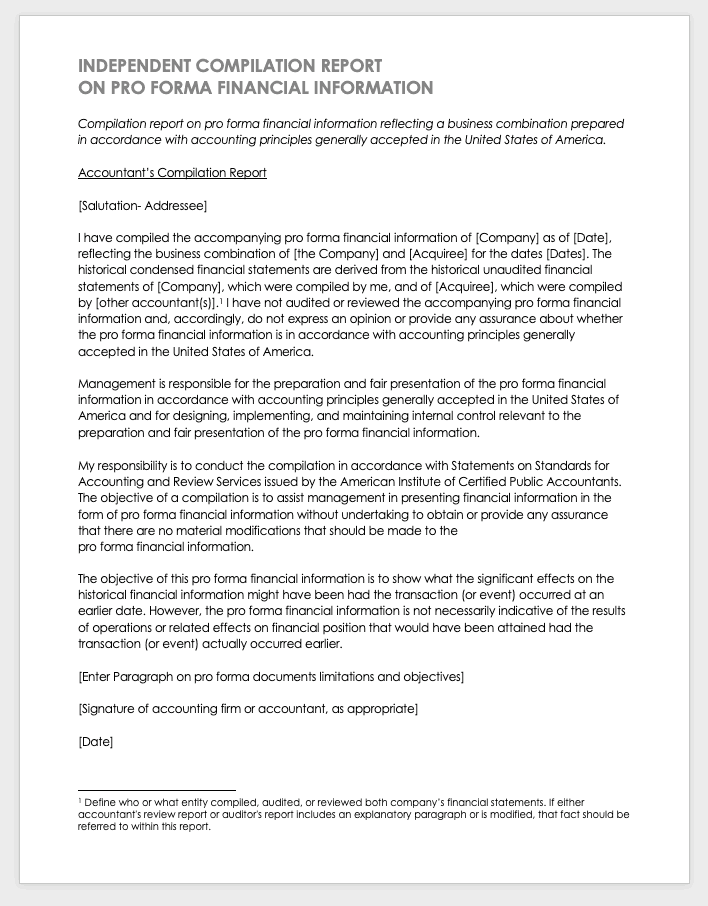
Download Compilation Report Template — Word
Before an auditor completes a company’s pro forma preparation, they must review the compilation report and consider any material errors and the appropriateness of the reports. Auditors are required to write a compilation report to protect themselves from liability. This report includes the following:
Title : The title should clearly indicate whether the report is a compilation or if the auditor is independent.
Addressee : As appropriate for the company.
Introductory Paragraph : This must include the company identity, that the pro forma information has been compiled, identify the information, specify the date covered, reference the historical financial documents, state that the auditor does not have an opinion of the finance, as well as note the dates of the historical documents (if applicable), and any departures from those statements.
Statement of Management’s Responsibilities : Management, not the auditor, must state that they are ultimately responsible for the outcomes of the pro forma financial statements.
Statement of Accountant’s Responsibilities : The accountant auditor must state that they will conduct the compilation based upon best practices in their industry.
Statement on Compilation Report Objective : This states that there will be no material modifications made to the pro forma statements.
Paragraph on Pro Forma Documents Limitations and Objectives : This is an explanation of the statements’ intent and why they are projections with limits.
Accountant signature : As appropriate.
Report date : As appropriate.
If the accountant is not independent, the report should reflect this. You can address this fact simply with a final paragraph in the compilation reports, and the author may elect to include the reason for the lack of independence. Finally, in each page of the pro forma information, there must be a reference to the compilation report.
How to Create A Pro Forma Income Statement
To start producing your pro forma financial statements, begin with the pro forma income statement. There is a standard approach called “percent of sales forecasting” that gives you the sales or its growth forecast. From there, project the variables with a stable sales relationship using the forecasted sales and the estimated relations. Generically, the income statement includes the following variables:
Sales (or Revenue) - Cost of Goods Sold = Gross Income (or Gross Earnings)
Gross Income (or Gross Sales/Earnings) - Operating Expenses = Operating Income
Operating Income - Depreciation = EBIT
EBIT - Interest Expense = EBT
EBT – Taxes = Net Income (Net Earnings, EAT, Profits)
Whether you start here or elsewhere, sit down with an income statement from the most recent year. Prior to the end of the year, decide how each item on that statement can or should be changed going forward. The final sales and expenses for the current year should be estimated to get ready a pro forma income statement for the following year. Then, do the following:
Calculate pro forma gross profit . You need to consider all the changes that will be coming next year, including new products, promotions, price changes, and new customers. As a simple example, estimate the percent increase you expect for next year’s sales. For example, if you expect a 5% increase in your current sales of $50,000, you calculate $50,000 * 105% = $52,500. Assuming the cost of the item you sell is not increasing, you still need 5% more of the item you sell to meet your goal. Assuming this year’s cost of goods sold (COGS) was $10,000, you will also multiply it by the 105%, so $10,000 * 105% = $10,500. To get the pro forma gross profit: $52,500 - $10,500 = $42,000 (your projected gross profit).
Calculate pro forma total operating expenses . For pro forma expenses, you should consider every line item and whether it can be cut, and then determine the cost projection increase rate for salaries and expenses. If, for example, your salaries and expenses will increase 3% next year, start by adding both the historical salaries and expenses together and then multiplying that sum 103%, or as an example: ($25,000 + $5,000) *103% = $30,900. Your pro forma salaries next year will be $25,750 and your expenses will be $5,150 for a total of $30,900 in pro forma expenses.
Calculate pro forma net income before taxes . Calculate your pro forma profit before taxes by finding the difference between the pro forma gross profit and the pro forma total expenses. Continuing the example: $42,500 - $30,900 = $11,600 (pro forma profit before taxes).
Calculate pro forma taxes . Take your estimated tax rate, such as 20%, and multiply it by the pro forma profit before taxes. This would be $11,600 * 20% = $2,320 is the tax bill.
Calculate pro forma net income after taxe s. In this example, subtract the $2,320 tax bill from the pro forma before taxes profit of $11,600 to give you the pro forma after taxes. This is $11,600 - $2,320 = $9,280 (pro forma profit after taxes).
There are other stable variables that aren’t influenced by sales on the income statement, including operating expenses, depreciation and amortization, and interest expense. The COGS figure does directly vary with sales; if it does not, something is wrong with your numbers. The COGS forecast is the COGS/Sales ratio from several years multiplied by the sales forecast.
Below is a sample of a filled out pro forma income statement:
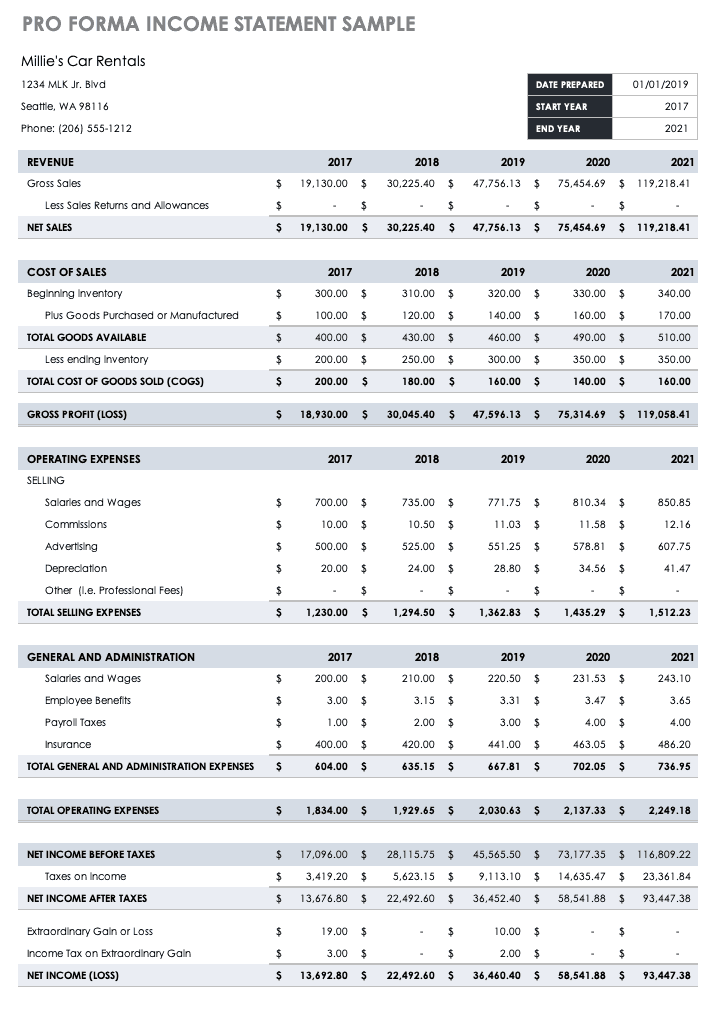
Download Pro Forma Income Statement Sample - Excel
How to Create a Pro Forma Balance Sheet
Once your pro forma income statement is completed and you have determined the change in retained earnings, transfer it to the pro forma balance sheet. Expect that the current assets and liabilities will vary directly with the sales variance. For the pro forma balance sheet, the variables include the following:
Accounts receivable
Prepaid taxes
Marketable securities - total current assets
Gross PP&E (property, plant, and equipment)
Accumulated depreciation
Net PP&E
Land - total assets
Liabilities + Owner’s Equity (Assets – all other liabilities) :
Accounts payable
Wages payable
Taxes payable
Current portion – long term debt - total current liabilities
Long-term debt
Preferred stock
Common stock
Retained earnings - total liabilities + equity
Ideally, the pro forma balance sheet is composed in columns. Here are some notes about the pro forma balance sheet variables:
The cash balance is usually calculated using a model and policy decisions.
The changes for Gross PP&E are also made using policy decisions.
The required new financing is often decided upon by the short-term or long-term debt residuals.
The interest expense comes from the interest-bearing debt.
Net income is affected by the interest expense, which also changes retained earnings, which also affects the amount of interest-bearing debt necessary.
How to Create A Pro Forma Statement of Cash Flow
Once you have completed forecasting both your pro forma income statement and your pro forma balance sheet, you can move on to the pro forma statement of cash flow. Start with the beginning balance, or the cash on hand. From there, add total all the cash receipts you have, including the following:
- Customer account collections
- Loan/cash injection
- Interest income
- Other cash receipts
Now, list all the outgoing cash payments. These include adding up all the following, as applicable:
Cost of goods sold (COGS)
Direct product/service costs
Payroll taxes/benefits (direct)
Salaries (direct)
Other variables as they pertain to your business
From here, add up all the operating expenses, including the following:
Account fees
Advertising
Continuing education
Dues/subscriptions
Licenses/permits
Meals/entertainment
Office supplies
Payroll processing
Payroll taxes/benefits (indirect)
Postage/shipping
Professional services
Rental fees
Salaries (indirect)
Subcontractors
Transportation
Web development
Web domain and hosting
Add any additional expenses together, as applicable:
Cash disbursements to owners
Charitable contributions
Interest expense
Income tax expense
Finally, calculate your formulas at the bottom of the sheet to get the sums of the analysis. These include Total Cash Payments, Net Cash Change, and Month Ending Cash Position. To calculate each:
Total Cash Payments = Total COGS + Total Operating Expenses + Total Additional Expenses
Net Cash Change = Cash Receipts – Cash Payments
Month Ending Cash Position = Cash on Hand + Cash Receipts – Cash Payments
Linking the Three Pro Forma Financial Statements
The pro forma income statement and the pro forma balance sheet are intimately linked. The pro forma balance sheet and the pro forma income statement must be forecasted together, not separately. The pro forma income statement displays the effect of a given year, while the pro forma balance sheet shows the situation at both the beginning of and time after that year. Between these two forms, the sheet must balance out. Some of the formulas between the two sheets bridge. These include the following:
Change in retained earnings (from balance sheet) = Net income (from income statement) – Dividends
Interest Expense (from income statement) = Interest Rate (from the balance sheet) * Interest-bearing debt
Some other criteria that cross sheets include the following:
Bank Loans (from balance sheet) goes into the Less interest expense (on the income statement).
Long-term debt (from balance sheet) goes to the Less interest expense (on the income statement).
Change in retained earnings (from income statement) goes to Retained earnings (on balance sheet).
The pro forma income statement equation is:
Change in retained earnings = [Revenue – Operating expenses – Depreciation & Amortization – (interest bearing debt * interest rate)] * (1- Tax rate) – Dividends
The pro forma balance sheet equation is:
Total assets = accounts payable + wages pay + taxes pay + interest bearing debt + common stock + change in retained earnings
For each of the above equations, the interest-bearing debt is the unknown variable.
Finally, you should link each of your three worksheets together. To do so, make sure you do the following:
Add net income from the income statement to the balance sheet and cash flow statement.
Add back depreciation to capital expenditure, which is arrived at on the cash flow statement. This determines property, plant, and equipment on the balance sheet.
The balance sheet and the cash from finalizing are usually affected by financing activities. Interest from financing is shown on the income statement.
The closing cash balance on the balance sheet is the sum of the last period’s closing cash and the current period’s cash from operations, investing, and financing.
Risk Analysis
In creating your pro forma documents, it is advisable to create multiple sets with different scenarios, especially when their purpose is to help make decisions. In this way, your management team (or C-suite) has all the information they need to make informed decisions. If you enable them, they have the best and worst-case scenarios that review the fiscal impact of their decisions and possible ways to mitigate risk. For more information on conducting risk analyses and the free templates to do so, see “ All the Risk Assessment Matrix Templates You Need .” As an example, your team might need to decide between the acquisition of two separate businesses. You could deliver to them two sets of pro forma financial statements, and two risk assessment templates to use to discover their best option.
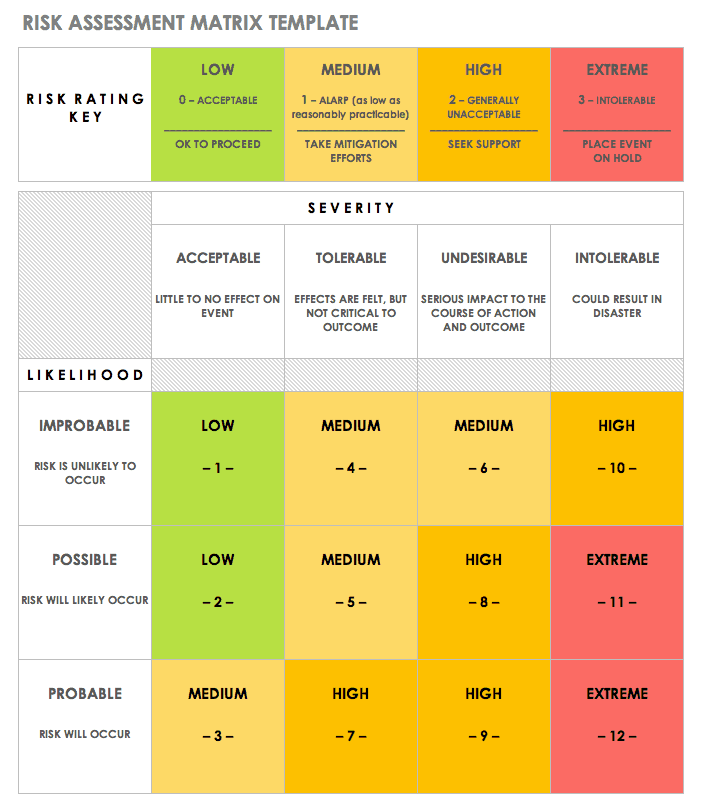
Download Risk Assessment Matrix Template
Excel | Word | PDF | Smartsheet
Other Types of Pro Forma Financial Statement Templates
There are several other types of templates that could be helpful for a business other than the ones already presented here. There are many different periods that could be covered, as well as the different purposes for the pro forma financial statements.
Historical with Acquisition Pro Forma Template
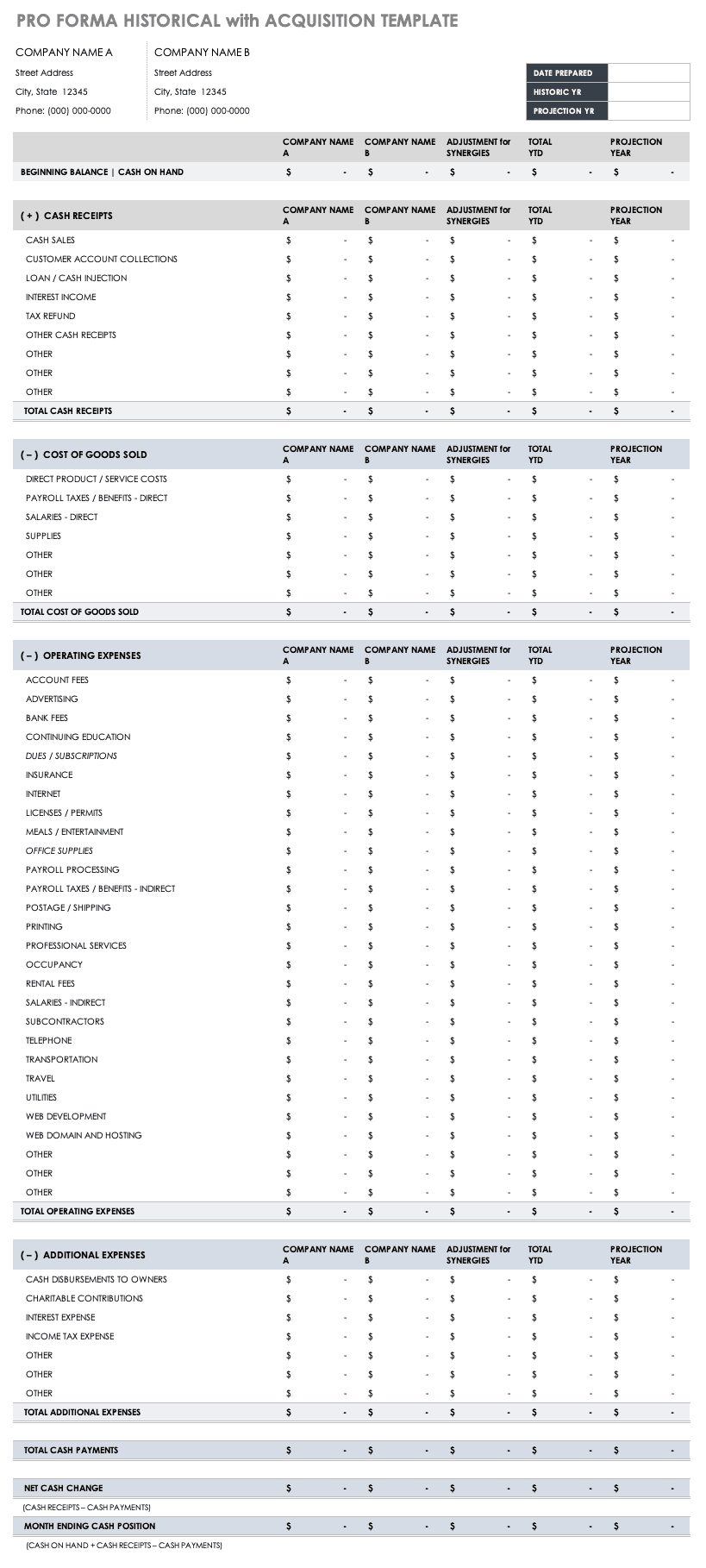
This projection looks backward (at one or more years) at another company’s financial statements. For the same period(s), it also looks at the business they are acquiring. Using this combination, the projections shows how they would have done together. This calculation gives you the the net acquisition costs. This type of projection could be shorter term (from the beginning of the current fiscal year). Use this free template to create your own historical with acquisition pro forma documents.
Download Historical with Acquisition Pro Forma Template — Excel
Investment Pro Forma Projection
For cases in which your company is specifically seeking funding, you want to show your potential investors how the company’s financial results will change with their investment. There may be several sets of these pro forma documents, each based on different potential investment amounts, or just one based on what you think you need. For this projection, you need to determine where in your company the investments would be parlayed. This can be either a fairly simple or complex process. For example, you may be able to add the investment onto the balance sheet under the cash row in the historical with acquisition pro forma template, or you may have to divide the investment under multiple rows. Check the templates in this guide to determine which is right for you to create your own.
Additional Terms Related to Pro Forma:
There are several terms to relate to pro forma and the finance concepts around it. These include the following:
Financial or Accounting Ratios : These figures are calculated from financial document figures, and they give a snapshot of a firm’s financial status and enable comparisons to other firms. Below are five frequently used financial ratios:
Debt-to-Equity Ratio : Total liabilities / stockholder’s equity
Current Ratio : Current assets / current liabilities
Quick Ratio : (Current assets – Inventories) / current liabilities
Return on Equity (ROE) Ratio : Net income / shareholder’s equity
Net Profit Margin : Net profit / net sales
- Pro-rata : This term describes a proportionate allocation. Used for dividend payments, insurance premiums, and interest rates, pro rata calculations determine the fractional payment from the whole. For example, in dividend payments each investor is paid according to their number of shares and based on the company’s number of shares outstanding. If the company has 400 shares outstanding at $2 per share, the maximum amount of dividends paid will be $800. The whole is $800. If one shareholder has 201 shares, their dividend will be: (the number of shares / the number of shares outstanding) * the total dividend payment In this case: (201/400) * $800 = $402
Pro bono : This comes from the latin term “pro bono publico,” meaning to work for the public good. It is voluntary work of no cost to the recipient. It often refers to free services from a professional to clients without the financial means to pay for them.
Quid pro quo : This term is a Latin phrase that means “something for something.” It occurs when two participants mutually agree to exchange something for something else. In business, this can take the form of goods, services, or tradable assets. These have also been called “favor for favor” arrangements, and the term can be used to describe unethical behavior such as the exchange of financial backing for political favors.
A quid pro quo contribution : This is a charitable contribution, but with one major difference. In a regular charitable contribution, the donor does not receive anything in return for their donation. In this type of donation, the Internal Revenue Service (IRS) allows the donor to deduct the entirety of their donation that is eligible. In a quid pro quo contribution, the donor receives something for their gift from the charity. The difference between what they have donated and the value of what they receive is the deductible amount. For example, a parent donates $500 at the school charity event to help them start a garden. In return, she receives a $50 gift card to the local grocery store. This is a quid pro quo contribution of which she may only claim $450 of as contributions for the tax year.
Budgeting : The plan created to balance expenses with revenue. The creation of this plan enables people and businesses to know whether they can afford to do the things they need to do and purchase the things they need. Following a budget ensures that people stay out of debt, can save, and pay their bills. Traditional budgets track expenses, payments to eliminate debt, and building an emergency fund as a buffer. Budgets should be compiled and reevaluated regularly.
Interim financial statements : These cover a period of less than one-year, interim financial statements may be issued for quarterly periods or any period. They usually contain the same documents that would be found in an annual statement, such as income statements, balance sheets, and statement of cash follows, and should match by line items. Some interim financial statements may be reviewed, such as in publicly-held companies, but they are not generally audited. Differences between interim and annual financial statements are in the following:
- Disclosures : Some disclosures are not required in interim financial statements, or may be presented as summaries.
Accrual basis : Accrued expenses may be reported within one reporting period or spread over multiple reporting periods. This variance can cause inconsistencies when interim reports are compared and should be defined for reviewers.
Seasonality : Season trends not seen in annual statements may be revealed by interim statements. These may be helpful in seeing seasons of major profit and loss.
Compilation : When financial statements are prepared or compiled by an outside agent, they are referred to as a compilation . The outside agent does not provide auditing or assurance services, just puts the data into financial statements. This type of service is less expensive than review or auditing services.
Notes to the financial statements : Also called the footnotes , and sometimes in the explanatory notes, notes to the financial statements explain how a company arrives at its numbers and any possible irregularities or inconsistencies. These are the details that explain the methodology, what decisions were made, and why to clarify the reports.
External financial statements : When financial statements are distributed to people or organizations not involved in the company’s operations, they are considered external financial statements . They are often compared to other companies or to previously released external financial statements and follow GAAP. A complete set includes the following:
Income statement
Balance sheet
Statement of cash flows
Statement of comprehensive income
Statement of stockholder equity
Common-size financial statements : Common size financial statements display all the items as percentages of the common base figure instead of as numerical figures, enabling comparisons between different companies or periods. Though most companies do not report in this way as it is not required, this type of reporting decreases bias.
Free Cash Flow Analysis : A free cash flow (FCF) analysis calculates the amount of cash a company can put aside after it has paid its expenses at the end of an accounting period. Free cash flow shows a company’s ability to grow internally give profit back to its shareholders. The formula for assessing free cash flow is: Net cash flow – capital expenditures - dividends OR (Net income + amortization + depreciation + deferred taxes) – capital expenditures - dividends
Variance Analysis : A variance analysis clarifies the difference between expected and actual results. Analyzing variances can improve operational efficiency. Using budgets as estimates and actual costs, the differences (called variances ) are calculated. The point of variance analysis is to determine if the project or business forecasts were accurate and to adjust based on this knowledge. For more information on cost variance and how to calculate it specifically for projects, see “ Hacking the PMP: Studying Cost Variance .”
Discover a Better Way to Manage Pro Forma Statements and Finance Operations
Empower your people to go above and beyond with a flexible platform designed to match the needs of your team — and adapt as those needs change.
The Smartsheet platform makes it easy to plan, capture, manage, and report on work from anywhere, helping your team be more effective and get more done. Report on key metrics and get real-time visibility into work as it happens with roll-up reports, dashboards, and automated workflows built to keep your team connected and informed.
When teams have clarity into the work getting done, there’s no telling how much more they can accomplish in the same amount of time. Try Smartsheet for free, today.
Discover why over 90% of Fortune 100 companies trust Smartsheet to get work done.
.png)
Pro Forma Financial Statements (with Templates and Examples)
Bryce Warnes
Reviewed by
Janet Berry-Johnson, CPA
April 21, 2022
This article is Tax Professional approved
Pro forma definition
According to Merriam-Webster , “pro forma” means:
- Made or carried out in a perfunctory manner or as a formality
- Based on financial assumptions or projections
I am the text that will be copied.
Pro forma is actually a Latin term meaning “for form” (or today we might say “for the sake of form, as a matter of form”).
When it comes to accounting, pro forma statements are financial reports for your business based on hypothetical scenarios. They’re a way for you to test out situations you think may happen in the future to help you make business decisions.
There are three major pro forma statements:
- Pro forma income statements
- Pro forma balance sheets
- Pro forma cash flow statements
Pro forma statements look like regular statements, except they’re based on what ifs, not real financial results. As in, “What if my business got a $50,000 loan next year?” Your pro forma statements for that scenario would show what your income, account balances, and cash flow would look like with a $50,000 loan.
Since pro forma statements deal with potential outcomes, they’re not considered GAAP compliant . This is because GAAP compliant reports must be based on historical information.
Pro forma statements don’t need to meet the strictest accounting standards , but must be clearly marked as “pro forma” and can’t be used for things like filing taxes. Using pro forma statements that aren’t marked as such to misrepresent your business to investors, the IRS, or financial institutions can be penalized by the Securities and Exchange Commission).
However, pro forma statements are still extremely useful. They can help you make a business plan, create a financial forecast, and even get funding from potential investors or lenders.
Different but related: you can send clients pro forma invoices to let them know how much their order would be if they placed it today.
Why create pro forma statements?
Creating pro forma statements for future scenarios can help you:
- Get financed, by showing lenders or investors how you would use their money to sustainably grow your business.
- Plan for the future, by considering best, worst, and most likely case scenarios in detail.
- Anticipate changes that may affect your business as it grows, such as entering a new tax bracket.
For these purposes, pro forma statements are typically created as a part of a financial forecast in financial accounting. Big corporations who have in-house accountants use pro forma statements for financial modeling and forecasting different scenarios.
Pro forma statements vs. budgets
It may be tempting to think of a pro forma statement as the same as a business budget . After all, you create both in anticipation of the future. And both help you plan how you’ll use your money. But budgets and pro forma statements are two distinct financial tools.
Think of it this way: A pro forma statement is a prediction, and a budget is a plan. Your budget may be based on the financial information of your pro forma statements—after all, it makes sense to make plans based on your predictions.
For example: Your income this year is $37,000. According to your pro forma annual income statement, your financial projections show it will be $44,000 next year. So, when you create next year’s budget, you can include that extra $7,000—maybe spending $4,000 over the course of the year to pay down the principal on a loan , while adding $3,000 to savings.
Types of pro forma statement
There are four main types of pro forma statements. While they all fall into the same categories—income statement, balance sheet, and cash flow statement—they differ based on the purpose of the financial forecast.
1. Full-year pro forma projection
This type of pro forma projection takes into account all of your financials for the fiscal year up until the present time, then adds projected outcomes for the remainder of the year. That can help you show investors or partners what business finances could look like by the end of the fiscal year.
2. Financing or investment pro forma projection
You may be courting investors or trying to convince your business partners of the value of a capital investment or additional financing. In that case, you can use a financing pro forma projection to make your case. It takes into account an injection of cash from an outside source—plus any interest payments you may need to make—and shows how it will affect your business’s financial position.
3. Historical with acquisition pro forma projection
This type of pro forma projection looks at the past financial statements of your business, plus the past financial statements of a business you want to buy . Then it merges them to show what your financials would have looked like if you made a business combination (or merger) earlier. You can use this scenario as a model of what may happen in the future if you buy the other business and restructure now.
4. Risk analysis pro forma projection
Looking at both best case and worst case scenarios helps you make financial decisions based on challenges you may face in the future. For instance, what happens if your main vendor raises their prices like they did last year? Or how will that proposed transaction of buying new equipment impact you long term? Risk analysis lets you take the future for a test ride, and try out different outcomes.
Pro forma templates
To create a pro forma statement, you can use the same template you’d use for a normal financial statement. You may want to use Bench’s free templates:
- Income statement
- Balance sheet
- Cash flow statement
How to create pro forma statements
The sample pro forma statements below may look different from the statements you create, depending on what your template looks like. But generally, these are the steps you need to take to create them—and the info your pro forma statements should include.
Creating a pro forma income statement
There are five steps to creating a pro forma income statement:
- Set a goal for sales in the period you’re looking at. Let’s say you want to increase your income by $18,000 over the course of one year.
- Set a production schedule that will let you reach your goal, and map it out over the time period you’re covering. In this case, you’ll want to earn an additional $1,500 income every month, for 12 months.
- Plan how you’ll match your production schedule. You could do this by growing your number of sales a fixed amount every month, or gradually increasing the amount of sales you make per month. It’s up to you—trust your experience as a business owner.
- It’s time for the “loss” part of “ Profit and Loss .” Calculate the cost of goods sold for each month in your projection. Then, deduct it from your sales. Deduct any other operating expenses you have, as well.
- Prepare your pro forma income statement using data you’ve compiled in the prior four steps.
One note: your pro forma statements will be much more accurate if your bookkeeping is up to date. That way, when you project future periods, you’re basing it off the reality of your business today.
How Bench can help
To predict the future, you first need to understand the past. With Bench, you get a crystal clear image of your financial history so you can focus on planning your future. We’re America’s largest bookkeeping service helping thousands of business owners better understand the financial health of their operations so they can keep focused on growth and planning. When it comes time to create a pro forma statement, you have reliable numbers and reports to get started. We may not be a crystal ball, but we’re the next best thing. Learn more .
Example pro forma income statement:
Rosalia’s Reliable Recordings
| 2021 (current) $ | 2022 $ | 2023 $ | |
|---|---|---|---|
| Sales Revenue | 20,000 | 38,000 | 48,000 |
| Cost of Sales | (10,000) | (19,000) | (24,000) |
| Gross Profit | 10,000 | 19,000 | 24,000 |
| Operating Expenses | |||
| Rent | 1,000 | 1,000 | 1,000 |
| Web hosting | 600 | 600 | 600 |
| Advertising | 3,000 | 4,000 | 5,000 |
| Total Operating Expenses | (4,600) | (5,600) | (6,600) |
| Operating Income | 5,400 | 13,400 | 17,400 |
| Net Income | 5,400 | 13,400 | 17,400 |
Creating a pro forma cash flow statement
You create a pro forma cash flow statement much the same way you’d create a normal cash flow statement. That means taking info from the income statement, then using the cash flow statement format to plot out where your money is going, and what you’ll have on hand at any one time. This pro forma statement can be part of a larger cash flow forecast used for decision making.
Your projected cash flow can give you a few different insights. If it’s negative, it means you won’t have enough cash on-hand to run your business, according to your current trajectory. You’ll have to make plans to borrow money and pay it off.
On the other hand, if net cash flow is positive, you can plan on having enough extra cash on hand to pay off loans, or save for a big investment.
Example pro forma cash flow statement
Mickie’s Murakami Museum
| 2021 (current) $ | 2022 $ | 2023 $ | |
|---|---|---|---|
| OPENING BALANCE | 16,000 | 17,000 | 19,000 |
| CASH RECEIVED FROM | |||
| Donors | 85,000 | 87,000 | 92,000 |
| Souvenir Shop | 1,000 | 900 | 800 |
| Total Cash Received | 86,000 | 87,900 | 92,800 |
| CASH PAID FOR | |||
| Supplies | 34,000 | 36,000 | 37,000 |
| Rent | 24,000 | 24,000 | 24,000 |
| Income Tax | 8,000 | 8,600 | 8,800 |
| Total Cash Paid | 66,000 | 68,600 | 69,800 |
| Net Cash Flow Operations | 20,000 | 19,300 | 23,000 |
Creating a pro forma balance sheet
By drawing on info from the income statement and the cash flow statement, you can create pro forma balance sheets. However, you’ll also need previous balance sheets to make this useful—so you can see how your business got from “Balance A” to “Balance B.”
The balance sheet will project changes in your business accounts over time. So you can plan where to move money, when.
Example pro forma balance sheet
Daily Dumpling Deliveries
| 2021 (current) $ | 2022 $ | 2023 $ | |
|---|---|---|---|
| ASSETS | |||
| Current Assets | |||
| Checking Acct. | 13,000 | 16,000 | 19,000 |
| Savings Acct. | 35,000 | 41,000 | 45,000 |
| Accounts Receivable | 4,000 | 2,000 | 2,000 |
| Inventory | 14,000 | 17,000 | 21,000 |
| Total Current Assets | 66,000 | 76,000 | 87,000 |
| NON-CURRENT ASSETS | |||
| Production Equipment | 14,000 | 14,000 | 14,000 |
| Car | 9,000 | 9,000 | 9,000 |
| Total Non-Current Assets | 23,000 | 23,000 | 23,000 |
| Total Assets | 89,000 | 99,000 | 110,000 |
| LIABILITIES & EQUITY | |||
| Current Liabilities | |||
| Accounts Payable | 10,000 | 9,000 | 11,000 |
| Line of Credit | 21,000 | 19,000 | 18,000 |
| Total Current Liabilities | 31,000 | 28,000 | 29,000 |
| Non-current Liabilities | |||
| Loan | 40,000 | 36,000 | 32,000 |
| Total Liabilities | 71,000 | 64,000 | 61,000 |
| EQUITY | |||
| Owner’s Capital | 35,000 | 35,000 | 35,000 |
| Retained Earnings | 45,000 | 56,000 | 65,000 |
| Total Equity | 80,000 | 91,000 | 100,000 |
| Total Liabilities & Equity | 151,000 | 155,000 | 161,000 |
Once you’ve created your pro forma income statements, and cast your eyes forward to the future of your business, you can start planning how you’ll spend your money. It’s time to create a small business budget .
Related Posts

Property Management Accounting: A Simple Guide
A simple guide to accounting, recordkeeping, and taxes for property management businesses.

Hiring an Accountant: Before and After
What are the signs that your small business needs an accountant, and how do you recruit one who's a good fit?
.png)
What Is Equity, and How Do You Calculate It?
How much of your business do you actually own? If you understand equity, you can answer that question.
Join over 140,000 fellow entrepreneurs who receive expert advice for their small business finances
Get a regular dose of educational guides and resources curated from the experts at Bench to help you confidently make the right decisions to grow your business. No spam. Unsubscribe at any time.

How to Create Pro Forma Financial Statements
March 14, 2023
14 min read
by Casey Clark

Senior Business Advisor
Vancouver, British Columbia, Canada
As a business partner, he helps his clients get a holistic view of their financial health by slowing down to talk about numbers. Then, he breaks down even complex problems into one or two elements to help them break through their barriers of growth.
July 27, 2022
It’s impossible to predict the future performance of your company, but a pro forma income statement is an asset that can help. In Latin, “pro format” means “for the sake of the form”. A pro forma financial statement is a way to forecast your future earnings over a particular period. By using historical financial statements and your projected cash flow, you can help determine how your business will perform in various scenarios.
At Cultivate Advisors, our revenue management consultants can help you put together a pro forma income statement to give you confidence and insight into how your company will perform in various scenarios.
What Is a Pro Forma Financial Statement?
Pro forma statements utilize hypothetical data or assumptions about the future values of your company to project performance. A pro forma statement doesn’t use generally accepted accounting principles (GAAP) and typically excludes one-time expenses that aren’t part of standard operating expenses, such as any restructuring costs following a merger. If a company believes an expense obscures the accuracy of its financial outlook, it can be excluded when factoring in financial projections.
Why Does Your Business Need a Pro Forma Financial Statement?

In addition to understanding how to make a pro forma income statement, companies also need to know the reasoning behind creating pro forma statements. There are many benefits to doing so in predicting the accuracy of future periods, including:
- Allows you to better plan for the future by factoring in the best, worst, and most likely scenarios in greater detail;
- Shows investors or lenders how you would leverage their money to help grow your business in a sustainable way;
- Helps you anticipate changes to your cash flow statements as your business grows, such as financial documents that revolve around entering a new tax bracket;
- Pinpoints financial limitations of which you should be aware.
In accounting, pro forma total expenses are usually used in a financial forecast that can help with financial modeling.
Pro Forma Statements vs. Budget: What Is the Difference?
You might be wondering how a pro forma balance sheet differs from a budget, as it’s likely tempting to think about the two as the same thing. Although the two documents share commonalities, they are two distinct financial tools that you can use to benefit your business.
Another simplistic way to think about a budget versus a pro forma is that a budget is a set plan while a pro forma is more of a prediction. It’s possible that your budget is based on the financial information that’s found in your pro forma statement. This makes sense, as you’ll want to make plans based on your predictions.
For example, let’s say your business has an income this year of $100,000. Based on your pro forma annual income statement, next year’s income will be $107,000. When you are putting together the budget for next year, you can factor in that $7,000 difference.
Pro Forma and GAAP Financials: What Is the Difference?

As there are no official rules when it comes to putting together pro forma income statements, investors must distinguish the difference between those and statements using generally accepted accounting principles (GAAP) or standard accounting practices. There are strict guidelines when using GAAP while pro forma income statement figures are seen as hypothetical.
4 Main Types of Pro Forma Statements
There are four main types of pro forma statements that you can use to manage your cash flows and the financial health of your business.
- Pro forma balance sheets : This is similar to a traditional balance sheet as it shows the accounts receivable, your cash flow statements, and other pertinent financial information. Business decisions and a business plan can be made based on this information.
- Pro forma cash flow : Another type of pro forma document is a pro forma cash flow that shows both you and potential investors the outflows and inflows of your company’s financial results within a set period that you determine. For example, it might cover a quarter or a fiscal year.
- Pro forma earnings : Using a pro forma earnings report can help you predict how your revenue will change in the upcoming year. It’s the inverse of a total expenses projection and allows you and key decision-makers to plan for various changes in your net income.
- Pro forma total expenses : This allows you to predict how your operating expenses will change in the year ahead.
Purposes of Pro Forma Statements
As we discussed, there are four essential types of pro forma statements, but there are slightly different scenarios for each. The purpose of the financial forecast will impact which one you choose.
1. Full-year Pro Forma Projections
A full-year projection factors in all of your financials for the fiscal year up until the present time. It then adds your projected cash flow outcomes for the remainder of the year. This allows you to showcase to partners or investors the potential of the business finances by the end of the fiscal year.
2. Financing or Investment Pro Forma Projections
If you’re talking to multiple investors to get their capital investment or you’re striving to convince your business partners that there’s value in additional financing, you should use a financing pro forma projection to help establish your case and outline the risk analysis. This factors in an additional cash flow from an outside source in addition to any interest payments that are factored in. It displays how this will impact your business’s overall financial position.
3. Historical with Acquisition Pro Forma Projections
As the name suggests, this pro forma projection considers the previous financial statements of your company in addition to the past financial statements of a company that you are hoping to purchase. It combines these numbers to showcase what your financials would have looked like in the case that you combined businesses earlier. You can use this data from the proposed transaction as a guide to what your projected income statement would be in the future and restructure from there.
4. Risk Analysis Pro Forma Projection
Examining both the best-case scenario and the worst-case scenario of your financial decisions, it helps you better prepare for the potential challenges that you might see in the future. For example, what if the estimated tax rate changes or you purchase new equipment that impacts you in the long run?
How to Make a Pro Forma Income Statement
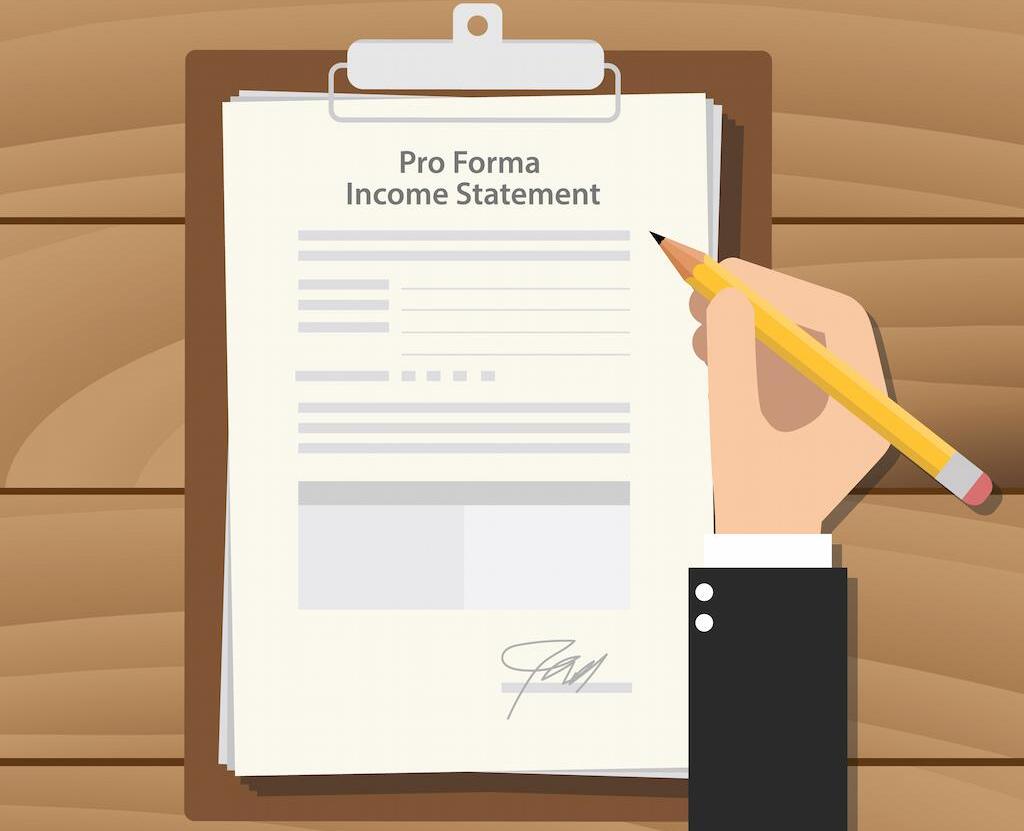
Generally speaking, to create a pro forma income statement, you’ll want to follow the below five steps.
- Start by setting a sales goal for the particular time period at which you’re looking. In our example, let’s say you want to increase your income by $12,000 over the course of one year.
- Set a production schedule that allows you to reach your goal and map it out over the covered time period. In this case, you’ll need to make an extra $1,000 every month to meet your goal.
- Then you’ll want to map out how you’ll match your production schedule to achieve your goals. There’s more than one way to do this; you can achieve this by increasing your number of sales by a fixed amount each month, or you can do so in a gradual way. Your experience as a business owner can guide you in the right direction.
- At this point, you’ll want to factor in the loss by determining the cost of goods sold for every month within your projection. From there, deduct that number, as well as any other operating costs, from your overall sales.
- Finally, prepare your pro forma income statement using the above data that you’ve compiled.
As a pro tip, you’ll always want to ensure that your bookkeeping is up to date, including your gross profit and your net cash flow, as it allows you to come up with more accurate data. You can also use a cash flow projection tool for guidance.
How to Create a Pro Forma Cash Flow Statement
In order to create a pro forma cash statement, there are five general steps that you can follow:
- Start by setting a sales goal for the particular period that you’re considering. For example, maybe you are looking at a year, and you want to increase your income by $12,000 during this time.
- Next, set a production schedule that allows you to reach your goal and project it over that same time period. In the case of our example, you would need to earn an additional $1,000 every month for the next 12 months.
- Then, determine how you can match your production schedule. For example, you can do so by increasing your sales amount by a set amount monthly, or you can do so gradually. Utilize your expertise as a business owner.
- Make sure to calculate the “loss” portion of your “profit and loss.” To do so, calculate the cost of goods sold every month and deduct this number from your sales. If there are other expenses, these should be deducted.
- You’ll be able to prepare your pro forma income statement using the above information.
You can also use a cash flow projection tool to guide you through this process.
How to Create a Pro Forma Balance Sheet
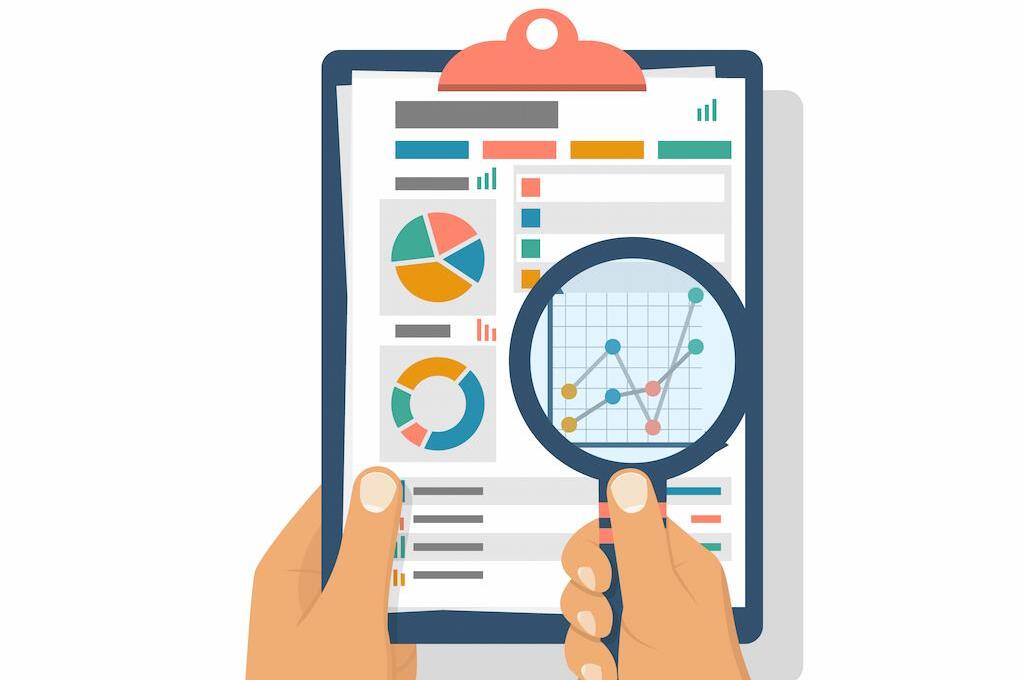
Start by taking the information from your income statement and using the cash flow statement to determine where your money is going. This statement can be part of a larger cash flow that’s used for financial accounting and decision-making.
This projected cash flow allows you to see whether you’ll have excess money to spend on things such as paying off loans or saving for an upcoming investment.
How Cultivate Advisors Can Help
With Cultivate Advisors , we can help you navigate your pro forma expenses and leverage them to benefit your business. Whether you need help with your pro forma gross profit or you’re looking for information on an investment pro forma projection, we are here to help! Reach out to our revenue management consultants to get started.
Related posts

Entrepreneurship
Productivity
Calculating and Improving Employee Attrition Rate: a Guide
April 14, 2023
15 min Read

Cultivate Clients Named to Inc. ‘5000 Fastest-Growing Companies’
October 26, 2023
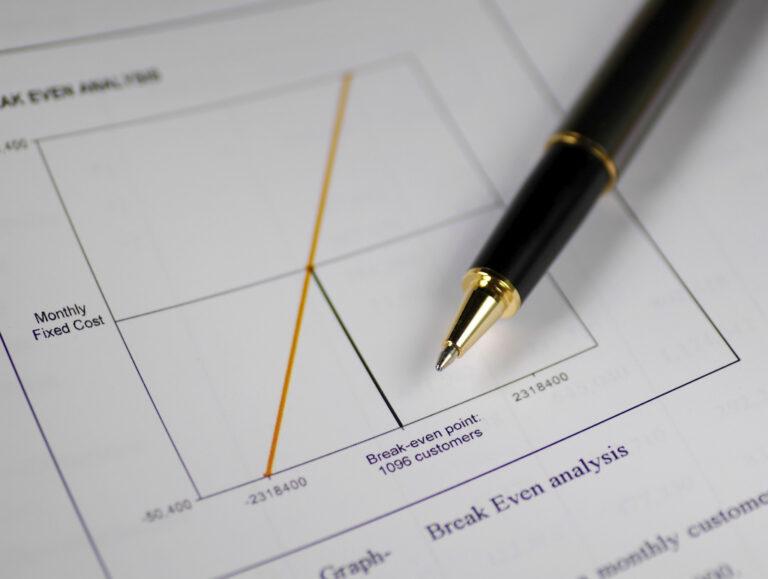
Break-Even Analysis for Small Business: What It Is and How to Do It
April 06, 2023
17 min Read
Get the Plan, Partner, and Process to Confidently Grow Your Business
Set up a quick call to learn more about the Cultivate Advising process and how it applies to your business.
Financial modeling spreadsheets and templates in Excel & Google Sheets
- Your cart is empty.

Mastering Pro Forma Business Plan: Tips And Tricks

Mastering a pro forma business plan involves strategic forecasting and attention to detail. It’s key for projecting future financial results and guiding business decisions.
Creating a pro forma business plan can be a daunting task, but with the right approach, it becomes an invaluable tool for any entrepreneur. This plan helps you anticipate necessary investments, potential risks, and expected profits, laying a foundation for sustainable growth.
By aligning your business objectives with financial expectations, a well-crafted pro forma plan will facilitate communication with investors and guide your company towards achieving its targets. Understanding the components of this document—such as projected revenue, cost of goods sold, and operating expenses—and incorporating industry benchmarks will sharpen its accuracy. Dive into this financial blueprint with clarity and precision, and you’ll set your enterprise on a path to success.
The Essentials Of A Pro Forma Business Plan
The Essentials of a Pro Forma Business Plan serve as a financial blueprint. They guide startups and established businesses alike. This plan showcases future economic activities. It is critical for making informed decisions. Stakeholders and investors often rely on these documents.
Key Components Of A Robust Plan
A solid Pro Forma Business Plan breaks down into several parts. Each part tells a different part of the business story. All parts work together for a full financial picture.
- Revenue Projections: Estimate future sales over a specific period.
- Costs and Expenses: Outline both fixed and variable costs the business will incur.
- Assets and Liabilities: Detail what the company owns and owes.
- Cash Flow Statements : Track the cash coming in and out of the business.
- Break-even Analysis: Identify when the business will start to generate profit.
Projecting Future Financial Performance
Estimating future finances is a core part of the Pro Forma Plan. Business leaders use this to prepare for what lies ahead. They can see potential profits and risks. This aids in planning investment and growth strategies.
Use historical data to predict future earnings. Consider market trends. Estimate sales growth. Factor in new products or services. Document everything in easy-to-read tables .
Add more rows as needed
| Year | Revenue | Expenses | Net Income |
|---|---|---|---|
| Year 1 | $500,000 | $300,000 | $200,000 |
Analyze different scenarios. Look at the best and worst cases. Adjust the plan as new information comes in. This keeps the business ready for any situation.
Delineating Revenue Assumptions
Master your pro forma business plan by articulating revenue assumptions with precision. Grasping these projections sharpens your financial foresight, pivotal for any robust business strategy.
Understanding your potential earnings forms the backbone of a business plan.
A precise forecast of revenue allows stakeholders to gauge a business’s sustainability.
Pricing Strategies
The right price can make or break a product’s success .
Conduct market research to set competitive prices.
Consider offering tiered pricing for wider appeal.
Sales Volume
Sales estimates should link to current market data.
- Forecast based on historical sales figures .
- Adjust for seasonal fluctuations and industry cycles.
Market Trends And Revenue Streams
Maintain agility to adapt to shifting market forces .
Identify multiple revenue streams, such as:
- Direct sales
- Subscriptions
Integrate these insights into your pro forma plan for reliable revenue predictions .
Defining Cost Structures
Understanding cost structures is crucial in crafting a robust pro forma business plan. It is about pinpointing where money flows. This knowledge guides financial predictions and strategies. Let’s dive into the dual nature of business expenses: fixed and variable costs.
Fixed Vs Variable Costs
Fixed and variable costs shape the financial backbone of any business. Recognizing which costs fall into each category impacts budgeting and forecasting accuracy.
- Fixed costs do not change with production volume. These include rent, salaries, and insurance.
- Variable costs fluctuate with business activity. Raw materials, manufacturing costs, and sales commissions are typical examples.
Sorting expenses into these types helps in managing cash flow and planning for growth.
Breakeven Analysis For New Ventures
A breakeven analysis reveals when a business can expect to start making a profit. It is a target for new ventures. Calculating the breakeven point demands clarity on both fixed and variable costs.
| Element | Description |
|---|---|
| Fixed Costs | Total fixed expenses |
| Variable Costs per Unit | Variable cost for one unit of product or service |
| Price per Unit | Selling price for one unit |
| Breakeven Quantity | Units to be sold to cover all costs |
To compute the breakeven point, subtract variable costs per unit from the price per unit. Divide fixed costs by this difference. The result tells how many units need selling to pay for all costs.
Effective cost analysis and breakeven calculations lead to smarter financial planning and a successful pro forma business plan.
Crafting Realistic Financial Projections
A pro forma business plan sets the stage for success. It is a powerful tool for predicting business health. Financial forecasts can make or break stakeholder confidence. It’s critical to stitch together realistic financial predictions with care.
Crafting Income Statements Predictions
Income statement forecasting forms the backbone of your financial projections. It provides a peek into future revenues and expenses. This projection helps stakeholders gauge profitability trends. Here’s how you can plot accurate estimates:
- Historical data: Use past financial records as a starting point.
- Market analysis: Factor in your current market position and trends.
- Cost assumptions: Include realistic cost estimates for goods sold and operating expenses.
- Revenue projections: Base them on data-driven market insights.
Add more rows as necessary
| Year | Revenue | Cost of Goods Sold | Gross Margin | Operating Expenses | Net Income |
|---|---|---|---|---|---|
| $500,000 | $150,000 | $350,000 | $200,000 | $150,000 |
Balance Sheet And Cash Flow Projections
A balance sheet reflects a company’s assets, liabilities, and equity. Cash flow projections uncover how funds enter and leave your business. These documents reveal financial stability and liquidity. Let’s break down the essentials for a robust balance sheet and cash flow forecast:
- Asset evaluation: Include current and fixed assets.
- Liability accounts: Account for both short-term and long-term liabilities.
- Equity: Reflect shareholder equity accurately for clarity on net worth.
- Cash in and out: Record expected cash receipts and disbursements.
- Identify cycles: Understand and anticipate the ebb and flow of cash throughout the year.
Projection Example: Starting Cash + Cash In - Cash Out = Ending Cash
The Importance Of Sensitivity Analysis
The Importance of Sensitivity Analysis is paramount when crafting a pro forma business plan. Sensitivity analysis helps businesses understand potential risks. It involves testing different scenarios to predict financial outcomes. By mastering this technique, you can better prepare for uncertainty.
Assessing Risk With Different Scenarios
Implementing sensitivity analysis means examining how changes affect your business. Outlined below are key steps in assessing risk:
- Identify Key Variables: Spot variables that can impact revenue or costs.
- Develop Scenarios: Create ‘what-if’ situations for these variables.
- Analyze Outcomes: Understand how different input levels can shift financial projections.
- Plan Contingencies: Prepare action plans for variable outcomes.
Adapting To Market Changes
Markets are volatile. A strong pro forma plan adapts to changes. Here’s how sensitivity analysis assists:
- Anticipate Volatility: Helps predict market swings and their effects.
- Strategic Decision-Making: Guides choices based on potential market shifts.
- Mitigate Risks: Develop strategies to minimize negative impacts.
- Maximize Opportunities: Capture gains from favorable market conditions.
Fine-tuning Your Business Model
Mastering the pro forma business plan is a pivotal step to ensure your business thrives. Fine-tuning your business model involves scrutinizing every aspect, from costs to revenue, to pave the way for financial success. Let’s delve into effective strategies to optimize costs and maximize revenue , critical components of a robust business model.
Cost Optimization Strategies
Keeping costs in check is essential for a profitable business. Here are some strategies to reduce expenses without compromising quality:
- Negotiate with suppliers for better rates.
- Embrace automation to save on labor costs.
- Analyze every expense to identify savings opportunities.
- Switch to energy-efficient solutions to cut utility bills.
Utilizing software to track and manage expenses can also lead to cost reductions. Keeping a keen eye on financial outflows enables smarter, leaner operations.
Revenue Maximization Techniques
Boosting revenue is key to business growth. Here’s how you can increase earnings:
- Analyze market trends to adjust prices wisely.
- Expand your product line to attract new customers.
- Use customer feedback to improve offerings .
- Implement loyalty programs to encourage repeat business .
Incorporating diversified revenue streams , such as subscriptions or complementary services, can also amplify profits. Remember, regular income analysis helps pinpoint and harness opportunities for growth.
Planning For Contingencies
Mastering your Pro Forma business plan isn’t just about forecasting success. It’s also about preparing for the unexpected. Setting up emergency funds and having a solid strategy in place can make the difference between staying afloat or sinking. In this section, we’ll explore how to cushion your business against unforeseen events.
Emergency Funds And Buffer Cash
It’s crucial to have an emergency fund that acts as a financial safety net. This reserve helps you handle sudden expenses without disrupting your business operations. A buffer cash reserve ensures you’re not caught off guard.
- Analyze your monthly expenses.
- Save a portion of your earnings.
- Goal: Aim for a reserve that covers 3-6 months.
Strategic Planning For Unforeseen Events
A well-thought-out strategy for unforeseen events is the key to resilience. Identify risks early and develop plans to mitigate them. Ensure you have a clear action plan in place.
| Step | Action |
|---|---|
| 1 | Risk Assessment |
| 2 | Plan Development |
| 3 | Implementation |
| 4 | Review |
Utilizing Pro Forma Plans For Funding
A solid pro forma business plan can open doors to funding. It lays out a company’s financial forecast, convincing those with the funds of its potential. Here’s how to use pro forma plans to secure investment or loans.
Presenting To Investors
First impressions matter when approaching investors. A pro forma plan should tell a compelling story, showcasing growth potential. Key elements include:
- Revenue projections: Show data-backed sales forecasts.
- Expense estimates : Highlight control over costs.
- Cash flow analysis: Demonstrate financial health.
Use clear visuals like graphs and charts to communicate your plan. They help break down complex data for easier understanding.
Loan Applications And Financial Leverage
Lenders look for low risk and solid returns . A detailed pro forma plan can tip the scales in your favor. Include:
| Section | Details |
|---|---|
| Show historical financial responsibility. | |
| Maintain a healthy balance to prove repayment capability. | |
| Offer assets to secure the loan, reducing lender risk. |
Remember, a well-crafted pro forma should act as a financial blueprint, giving lenders confidence in your ability to succeed.
Monitoring And Adjusting Pro Formas
A pro forma business plan is not set in stone. Business conditions change and so should your pro formas.
Regular Financial Review And Updates
Constant evaluation of your financial projections ensures they remain relevant. Here are some tips:
- Set review dates: Choose monthly or quarterly intervals for consistency.
- Compare projections with actuals: Look for variances and explore their causes.
- Adjust for reality: Update your pro forma to reflect both best-case and worst-case scenarios.
Effective monitoring anticipates changes and keeps your business agile.
Alignment With Actual Business Growth
Your pro forma should mirror real business growth. This alignment is key for its usefulness. Steps to align them include:
- Analyze sales and expenditure trends.
- Revise projections to mirror these trends.
- Involve team members in review sessions for diverse insights.
Maintain transparency with stakeholders by regularly sharing updates.
Leveraging Technology In Pro Forma Creation
Technology transforms how we craft Pro Forma business plans . Using the latest tools, we can predict financial outcomes with greater accuracy. By leveraging software, data analytics becomes our guide. This way, the plans we create can widely serve their purpose for stakeholders and potential investors.
Software Solutions For Projections
Choosing the right software is crucial for crafting effective Pro Forma statements . Here’s where technology shines. It simplifies complex calculations. It even suggests potential financial scenarios. Let’s explore top software options:
- Spreadsheet Programs: Easy-to-use, they offer templates for quick setups.
- Financial Planning Software: These specialize in more detailed analyses.
- Business Plan Software: They provide a comprehensive package, including market research and Pro Forma statements.
Integrating Data Analytics For Accuracy
Accuracy in forecasting demands precise data insights. Data analytics tools can help . They draw from historical data and industry trends. These insights refine our assumptions. It leads to dependable Pro Forma plans. Let’s consider the steps to integrate analytics:
- Collect historical financial data for baseline projections.
- Use industry benchmarks to gauge potential growth.
- Apply analytics software to project future financial outcomes.
By embracing these technologies , we streamline Pro Forma creation. This ensures both efficiency and reliability. Embrace these tools to set your business plan on the path to success.
Frequently Asked Questions
What is a pro forma business plan.
A pro forma business plan is a financial document projecting future revenue, expenses, and net income. It’s often used to model a company’s financial future.
How Do You Create A Pro Forma?
Creating a pro forma involves estimating future sales, costs, and cash flow. Use historical data, research, and industry standards for realistic projections.
Why Is A Pro Forma Important For Startups?
Pro forma statements help startups forecast financial performance. They aid in decision-making, attracting investors, and planning for growth.
What Should Be Included In Pro Forma?
Include revenue projections, cost estimates, operating expenses, cash flow, and net income. It should reflect realistic financial expectations for the company.
Crafting an effective pro forma business plan is a crucial step for entrepreneurs. Use the tips and tricks explored in this post to project your financial future with confidence. Remember, precision and foresight are your allies. By applying these insights, your blueprint for success just got clearer.
Start planning, and set your venture on the path to prosperity.

Solar Energy Financial Model
The Solar Energy Financial Model Spreadsheet Template in Excel assists you in preparing a sophisticated financial forecast for a utility-scale solar p... read more
- PREMIUM – $149.95 Version 7.1
- PRO – $129.95 Version 7.1
- BASIC – $99.95 Version 7.1
- PDF Demos – $0.00 Version 7.1

Financial Model for Mobile App | Mobile App Business Plan
The Mobile App Financial Plan Template in Excel allows you to develop financial projections when launching a new business centered around an app insta... read more
- PREMIUM – $209.95 Version 7.3
- PRO – $159.95 Version 7.3
- BASIC – $109.95 Version 7.3
- PDF Demo Versions – $0.00 Version 7.3

Coffee Shop Financial Model Excel Template
Download Coffee Shop Financial Model Template. Allows you to start planning with no fuss and maximum of help Highly versatile and user-fri... read more
- Excel - Multi-User – $129.00 Version 1
- Excel - Single-User – $99.00 Version 1
- Free Demo – $0.00 Version 1

Discounted Cash Flow Valuation Model: Free Excel Template
This Discounted Cash Flow (DCF) valuation calculator template projects a three-statement model that allows users to value a company based on the net p... read more
- Basic Version – $0.00 Version 4.4
- Advance Version – $0.00 Version 4.4

Google Sheets Project Plan Template
This Project Plan Template in Google Sheet allows you to quickly develop a project plan and plot a Gantt chart. Enjoy all the benefits of Google Docs ... read more

Upstream Oil & Gas Project Analysis
The Upstream Oil & Gas Project Financial Model Template in Excel empowers you to project and dissect your impending Oil and Gas drilling ventures. Pre... read more
- Pro - Full Excel Model – $159.95 Version 8.3
- Basic - Full Excel Model – $119.95 Version 8.3
- PDF Demo Versions – $0.00 Version 8.3

Hotel Financial Model Excel Template
Download Hotel Financial Model. Creates a financial summary formatted for your Pitch Deck. Ready to Raise Capital. The hotel excel financial... read more

Grocery Store Financial Model Excel Template
Try Grocery Store Financial Projection. Creates 5-year Pro-forma financial statements, and financial ratios in GAAP or IFRS formats on the f... read more

Waterfall Profit Distribution Model (up to 4 Tiers)
We are introducing our 4-Tier Waterfall Profit Distribution Model. The waterfall profit distribution model template aims to support a thorough analysi... read more
- Full Excel Model – $79.95 Version 2.1
- PDF Demo – $0.00 Version 2.1

Advanced Financial Model with DCF & Valuation
Dynamic Financial Planning & Analysis Model providing up to 10 Years of Financial Projections.
- Excel Financial Model – $129.00 Version 1
- PDF Free Demo – $0.00 Version 1

Gasoline and EV Charging Station Financial Model
Investors can assess the viability of setting up and investing in gasoline stations with a charging station by downloading a financial model for their... read more
- Premium Excel Version – $129.95 Version 2.1
- Basic Excel Version – $99.95 Version 2.1
- PDF Versions – $0.00 Version 2.1

All My Financial Models, Spreadsheets, Templates, and Tools: 120+
Lifetime access to all future templates as well! Here is a set of spreadsheets that have some of the most valuable logic in the world. I have been thr... read more
- All My Excel Tools – $499.00 Version 1

Outpatient Clinic Financial Model Excel Template
Shop Outpatient Clinic Financial Model Template. Enhance your pitches and impress potential investors with the expected financial metrics. A sop... read more
- Excel - Multi-User – $129.00
- Excel - Single-User – $99.00
- Free Demo – $0.00

Lending Platform Financial Model (LaaS)
Includes all the assumptions you need to project the gross revenues and profits of a LaaS platform (Lending as a Service). 3-statement model and cap t... read more
- Excel Model – $75.00 Version 3

Beverage Manufacturing Start-up Financial Model
The beverage manufacturing industry is a dynamic and rapidly growing sector that caters to a diverse market ranging from soft drinks and juices to alc... read more
- Excel Model – $199.95 Version 5.2
- PDF Demo – $0.00 Version 5.2

Bakery Financial Model Excel Template
Shop Bakery Budget Template. Solid package of print-ready reports, including P&L and cash flow statements, and a complete set of financial r... read more

Cafe Financial Model Excel Template
Check Our Cafe Budget Template. Creates a financial summary formatted for your Pitch Deck. Ready to Raise Capital. Creates 5-year cafe financial model... read more
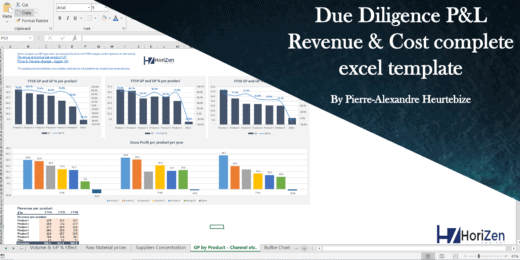
Due Diligence P&L – Exhaustive Revenue and Costs Analysis Template
Model for in depth understanding of high level profit and loss and revenue analysis. Big-4 like checklist of due diligence analyses. This Financial Du... read more

Online Clothing Store Financial Model Excel Template
Impress bankers and investors with a proven, solid Online Clothing Store Financial Projection Template. Five year online clothing store cash... read more

Poultry Farm Financial Model Excel Template
Shop Poultry Farm Budget Template. Excel template - robust and powerful. This is your solid foundation to plan your business model. Five-year ho... read more

Startup Company Financial Model – 5 Year Financial Forecast
Highly-sophisticated and user-friendly financial model for Startup Companies providing a 5-Year advanced financial forecast.
- Financial Model - Light Version – $119.00 Version 1
- Financial Model - Standard Version – $159.00 Version 1
- Financial Model - Premium Version – $219.00 Version 1

Clothing Store Financial Model Excel Template
Get Your Clothing Store Budget Template. Creates 5-year Pro-forma financial statements, and financial ratios in GAAP or IFRS formats on the fly. Five-... read more

Green Hydrogen (Electrolysis) Production Financial Model
This green hydrogen financial model template builds a multi-year financial plan to analyze the financial feasibility and profitability for the product... read more
- Full Excel Version – $119.00 Version 1.8
- PDF Version – $0.00 Version 1.8

Dental Practice Financial Model Excel Template
Check Dental Practice Financial Model. Fortunately, you can solve Cash Flow shortfalls with a bit of effort. A sophisticated 5 year dental p... read more

Mixed-Use Real Estate Model: Leverage / JV Options
A general real estate model to plan all assumptions for up to 7 'uses' for a given property. Includes development / acquisition, leverage if desired, ... read more
- EURO Currency Version – $75.00 Version 1
- Unit-based Version – $75.00 Version 4
- Square Foot-based Version – $75.00 Version 4

Poultry Project Financial Feasibility Model
This poultry financial model template in Excel provides a framework to determine the financial feasibility of a new poultry project for producing bro... read more
- Pro Excel Version – $99.95 Version 1
- Basic Excel Version – $79.95 Version 1
- PDF Demo Version – $0.00 Version 1


10 Year P&L, Balance Sheet, Cash Flow, and Break-even Analysis
This excel template is great for those wanting a professional-looking forecast 10 years of financial statements, those starting out as an entrepreneur... read more
- PDF Demo – $0.00
- Excel Model – $20.00

Spa Financial Model Excel Template
Download Spa Financial Projection Template. This well-tested, robust, and powerful template is your solid foundation to plan a success. Creates ... read more

Digital Marketing Agency Financial Model Excel Template
Check Our Digital Marketing Agency Financial Projection Template. Excel Template for your pitch deck to convince Investors. Digital Marketing Ag... read more

Start Up Solar Farm Excel Model and Valuation
Start Up Solar Farm Excel Model presents the business case of an investment in the construction of a solar farm and the sale of the energy generated f... read more
- Excel Model – $119.00
- Free PDF – $0.00

Nail Salon Financial Model Excel Template
Check Nail Salon Financial Model Template. Excel - well-tested, robust and powerful. Get you solid foundation to plan your business model. Five-year f... read more

Boutique Hotel Financial Model Excel Template
Check Our Boutique Hotel Financial Projection. Excel - well-tested, robust, and powerful. Get you a solid foundation to plan your business m... read more

Fintech Financial Model Excel Template
Try Fintech Financial Projection Template. Enhance your pitch decks and impress potential investors with a proven, strategy template. Five ... read more
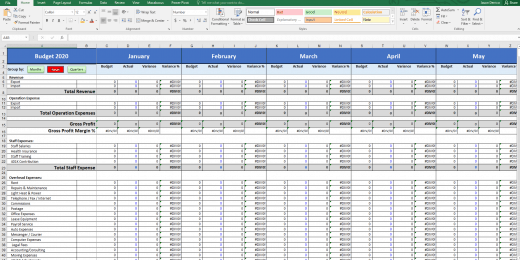
Budget vs. Actual (Logistic Company)
The Budget vs. Actual financial model is used to measure actual results against the budget projected for the financial period.
- PDF File – $0.00
- Full Version – $55.00

Restaurant Financial Model Excel Template
Get Your Restaurant Financial Model Template. Spend less time on Cash Flow forecasting and more time on your products. Restaurant Financial ... read more

Travel Agency Financial Model Excel Template
Shop Travel Agency Financial Projection Template. This well-tested, robust, and powerful template is your solid foundation to plan a success. A ... read more

Insurance Agency Financial Model Excel Template
Shop Insurance Agency Financial Plan. Fortunately, you can solve Cash Flow shortfalls with a bit of effort. Generates 5-year insurance agency ex... read more

Beauty Salon Financial Model Excel Template
Get Your Beauty Salon Financial Model Template. Creates 5-year financial projection and financial ratios in GAAP or IFRS formats on the fly. Creates 5... read more

Equipment Rental Cash Flow Model
Highly dynamic financial model that is specific to renting equipment out. High attention paid to the cash flows and timeliness of them so the user has... read more
- Version 2 – $75.00
- 10-Year Model – $75.00

Real Estate Brokerage Firm Financial Model Template
Financial model template for a high-level real estate brokerage firm that facilitates the buying and selling of real estate properties between buyers ... read more
- Real Estate Financial Model - Full Version – $44.95
- Real Estate Financial Model - PDF Demo – $0.00

Inventory Dashboard Model Template
!! Kindly use the latest Microsoft Excel Version before purchasing the model, otherwise, the dynamic dashboard will NOT work.!! Inventory Dashboard Mo... read more
- Free PDF Demo – $0.00
- Full Excel Model – $119.00

Medical Practice Financial Model Excel Template
Check Our Medical Practice Financial Projection. Simple-to-use yet very sophisticated planning tool. Get reliable results with minimal exper... read more

Payroll Budget Plan Excel Template
A professional template to budget payroll expenses
- Excel Template + PDF Guide – $20.00

Solar Panel Manufacturing Plant Business Plan Financial Model Excel Template
Get the Best Solar Panel Manufacturing Plant Financial Model. Spend less time on Cash Flow forecasting and more time on your products. The Solar Panel... read more

Open Pit Mine Financial Model
Allow a potential miner to see visually and numerically (annual basis) what their possible financial position would look like when starting up an open... read more
- Excel Model – $45.00 Version 4

Mergers & Acquisitions (M&A) Model
The Mergers & Acquisition (M&A) Model provides a projection for a company looking to potentially merge or acquire another company. This model runs... read more
- Full Excel Version – $75.00 Version 1

Pizzeria Financial Model Excel Template
Get Your Pizzeria Budget Template. Excel template - robust and powerful. This is your solid foundation to plan your business model. Five-year horizon ... read more

Coffee Farm Financial Feasibility Model Template
This coffee farm financial feasibility model template prepares a financial plan for your next coffee growing project! Figure out the expected incomes ... read more
- Standard version – $89.00 Version 1.2
- Pro version – $119.00 Version 1.2
- Free Demo PDFs – $0.00 Version 1.2

Resort Financial Model Excel Template
Order Resort Financial Model. Excel template - robust and powerful. This is your solid foundation to plan your business model. Five year res... read more
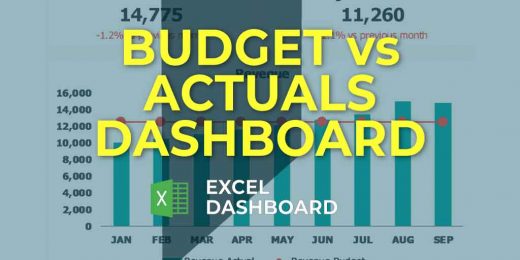
Budget vs Actual Excel Template
Create your very own budget vs actual analysis by trying out this Budget vs Actual Analysis Excel Template.
Leave a Reply Cancel reply
You must be logged in to post a comment.
Home > Finance > Accounting
How a Pro Forma Statement Can Help Your Small Business
We are committed to sharing unbiased reviews. Some of the links on our site are from our partners who compensate us. Read our editorial guidelines and advertising disclosure .
As a business owner, you know the importance of financial planning and forecasting.
Pro forma financial statements are powerful tools that can help you project future financial performance, assess potential investments, and evaluate the impact of business decisions.
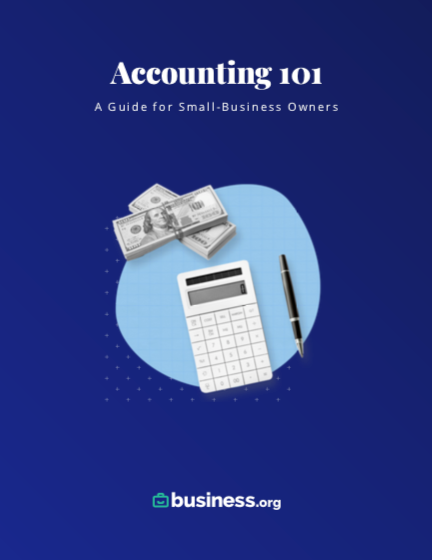
By signing up I agree to the Terms of Use and Privacy Policy .
What does pro forma mean?
Pro forma is a Latin term that means "as a matter of form" or "for the sake of form."
In business and accounting, it describes financial statements that are based on assumptions or estimates rather than actual historical data.
Maybe you’re considering taking out a small business loan or merging with a larger company. A pro forma statement projects the impact of those decisions, showing whether your company’s financial health is expected to improve, decline, or remain the same after the event takes place.
Pro forma statements can omit certain information. For example, a company may exclude one-time expenses, such as restructuring costs or a legal settlement, in order to present a more accurate picture of ongoing operations.
Pro forma statements, budgets, and invoices are typically used for planning, forecasting, or decision-making purposes.
What are pro forma financial statements?
Pro forma financial statements forecast estimated future financial performance rather than relying solely on historical data.
Typically, these statements include a pro forma income statement, balance sheet , and cash flow statement , all based on hypothetical scenarios and assumptions.
Pro forma statements are usually preliminary or illustrative. They’re meant to give you a glimpse into a company's potential performance rather than strict adherence to the accounting rulebook.
Companies engaging in mergers and acquisitions often prepare pro forma financial statements to offer a picture of their future finances. These statements play a crucial role in negotiations and valuation discussions.
Sharing a pro forma statement also helps you communicate your growth strategy to lenders and investors.
Critics of pro forma financial statements argue that companies use this freedom to cherry-pick what to include or exclude, molding the numbers to fit a desired narrative.
Pro forma invoices
Pro forma invoices are preliminary invoices sent to customers before the actual transaction takes place. Think of it as a "pre-invoice.” It outlines the products or services being offered, their quantities, prices, and other essential details
Pro forma invoices are the preferred method of doing international business, according to the U.S. International Trade Administration .
These invoices allow buyers to obtain necessary permits or secure financing before goods are shipped out.
Pro forma invoices also assist with customs clearance by providing necessary information to custom officials for the import and export process. It’s like a financial roadmap to ensure a smooth international trade journey.
While regular invoices are binding and indicate an actual sale, pro forma invoices are a prelude to the real deal. Pro forma invoices don't demand payment or initiate financial transactions.
You can find basic templates for creating pro forma invoices online, or you can create your own with a Microsoft Excel spreadsheet.
Many accounting software programs, such as Sage Accounting and FreshBooks , offer features and templates specifically designed for generating pro forma invoices.
With Sage , for example, you can select a pro forma template, input the information, save a copy for your records, and email it directly to the client. There’s also an option to convert it to a full invoice later.
Different billing and invoicing software also offers this feature. Companies like Zoho Books , for example, offer a pro forma template on their website you can download and use for free.
For easier financial management, try accounting software
14 days | Unlimited ($2.50/user/mo.) | ||||
30 days** | Unlimited ($10.00/user/mo.) | ||||
N/A | Unlimited | ||||
30 days | Unlimited | ||||
30 days* | Up to 25 | ||||
| 30 days | 1 | |||
| N/A | Unlimited | |||
| No but 90-day money back guarantee | N/A | |||
| N/A | $99.00/user/mo. |
Data as of 5/3/23. Offers and availability may vary by location and are subject to change. *Only available for businesses with an annual revenue beneath $50K USD **Current offer: 50% off for 3 mos. or 30-day free trial †Current offer: 50% off for three months or 30-day free trial ‡Current offer: 75% off for 3 mos. Available for new customers only
On a tight budget? Check out our picks for the best free accounting software .
Pro forma budgets
A pro forma budget is a projected financial plan that outlines anticipated revenue, expenses, and cash flows for a specific period.
Pro forma budgets can be useful for assessing the financial feasibility of new projects or projecting the impact of cost-cutting measures.
So, how is it different from a traditional budget?
A regular budget focuses on your current financial situation and sets spending limits based on historical data. It helps you manage day-to-day operations. A pro forma budget, on the other hand, takes things a step further by considering future events or changes.
Let’s say you're planning to launch a new product line. With a pro forma budget, you can estimate the revenue and expenses associated with your new venture. You might consider costs like research and development, manufacturing, marketing, and distribution.
By projecting the financial outcomes of your product launch, you can assess its viability and make adjustments before it goes live.
Downsides of pro forma statements
While pro forma statements serve a purpose, they can also be misleading. Excluding certain expenses or items can paint an overly optimistic — or even unrealistic — picture of a company's financial health.
Businesses have the freedom to use their own discretion when calculating pro forma earnings. They can include or exclude certain items based on what they believe truly represents their company's performance or future prospects.
Just remember, like any financial information, it's important to read between the lines and dig into the assumptions behind impressive pro forma numbers.
The U.S. Securities and Exchange Commission (SEC) requires companies to provide clear explanations on pro forma statements and reconcile pro forma figures to Generally Accepted Accounting Principles (GAAP).
Using pro forma projections to grossly misrepresent GAAP-based results and mislead investors is considered fraudulent and punishable by law under SEC regulations.
Rachel Christian is a Certified Educator in Personal Finance and a senior writer at The Penny Hoarder. She focuses on small businesses, retirement, investing and taxes.
Pro forma frequently asked questions (FAQs)
Businesses use pro forma statements to examine the potential impact of future events based on certain assumptions.
Pro forma statements allow companies to make informed decisions based on projections, attract investors, and assess the impact of mergers and acquisitions.
By adjusting for these events, businesses can gauge potential financial impact and make smarter strategic choices.
Pro forma statements are not bound by the same rigorous standards as audited financial statements. As a result, their accuracy heavily depends on the integrity of the company preparing them.
Pro forma statements rely on forward-looking information, which can be incredibly difficult to predict. Economic conditions, market dynamics and other external factors outside a company’s control can throw even the most well-researched pro forma statements off course.
That’s why you shouldn’t rely solely on pro forma financial statements.
Regular financial statements are prepared in accordance with Generally Accepted Accounting Principles and provide an accurate depiction of a company's historical financial performance.
Pro forma statements, on the other hand, are more like "what if" scenarios. They’re created to show how a company's financials might look under different situations or to exclude certain non-recurring costs.

With plans starting at $15 a month, FreshBooks is well-suited for freelancers, solopreneurs, and small-business owners alike.
- Track time and expenses
- Create custom invoices
- Accept online payments
Related reading
- The 7 Best Small-Business Accounting Apps of 2023
- The 9 Best Self-Employed Accounting Software of 2023
- Wave Accounting Review 2023
- How to Set Up Business Accounting Software for the First Time
- Accounting 101: A Guide for Small-Business Owners

5202 W Douglas Corrigan Way Salt Lake City, UT 84116
Accounting & Payroll
Point of Sale
Payment Processing
Inventory Management
Human Resources
Other Services
Best Small Business Loans
Best Inventory Management Software
Best Small Business Accounting Software
Best Payroll Software
Best Mobile Credit Card Readers
Best POS Systems
Best Tax Software
Stay updated on the latest products and services anytime anywhere.
By signing up, you agree to our Terms of Use and Privacy Policy .
Disclaimer: The information featured in this article is based on our best estimates of pricing, package details, contract stipulations, and service available at the time of writing. All information is subject to change. Pricing will vary based on various factors, including, but not limited to, the customer’s location, package chosen, added features and equipment, the purchaser’s credit score, etc. For the most accurate information, please ask your customer service representative. Clarify all fees and contract details before signing a contract or finalizing your purchase.
Our mission is to help consumers make informed purchase decisions. While we strive to keep our reviews as unbiased as possible, we do receive affiliate compensation through some of our links. This can affect which services appear on our site and where we rank them. Our affiliate compensation allows us to maintain an ad-free website and provide a free service to our readers. For more information, please see our Privacy Policy Page . |
© Business.org 2024 All Rights Reserved.
Trending Courses
Course Categories
Certification Programs
- Free Courses
Accounting Resources
- Free Practice Tests
- On Demand Webinars
Pro Forma Income Statement
Last Updated :
21 Aug, 2024
Blog Author :
Wallstreetmojo Team
Edited by :
Ashish Kumar Srivastav
Reviewed by :
Dheeraj Vaidya
Table Of Contents
What Is A Pro Forma Income Statement?
Pro Forma Income Statement (also known as pro forma profit and loss) means how the adjusted income statement will look when certain assumptions, like non-recurring items, restructuring costs, etc., are excluded or if a loss-making unit is discontinued.

When used in a business plan, it represents financial forecasts based on managers’ or analysts’ assumptions about the company. There is an analysis of past performance and future assumptions based on which the projection is made. It gives stakeholders a view of the entity's current and expected financial condition. Thus, it should be clear and accurate.
Table of contents
Pro forma income statement explained, limitations, recommended articles.
A pro forma income statement in business plan is the statement prepared by the business entity to prepare the projections of income and expenses, which they expect to have in the future by following certain assumptions such as competition level in the market, size of the market, and growth rate, etc.
Although it provide a better picture, it is prudent for the investor to dip deep and analyze what is included/excluded and why so? It also advised comparing the pro forma and actual statements to understand them better.
Let us look at the various types of the pro forma income statement in business plan.
#1 - Pro Forma of Historical Profit and Loss Statement
This happens when the business plans to make some retrospective changes in the income statement . For this purpose, the line items need to be adjusted so that the changes are reflected from the past years.
#2 - Pro Forma Projections of Income
Projections help in forecasting the future of the business based on its current financial condition. Thus, using the concept of conservatism, though consideration of certain important items. Below are the pro forma income statement sample of Alibaba. The projection of revenues is based on many assumptions, including growth rate, competition, market size, etc.

Below is a pro forma income statement sample . As noted below, Amazon removed its non-recurring charges, including restructuring costs and stock-based compensation, to correctly represent its Net Income .

source: Amazon SEC Filings
- Forecasting revenues are the most difficult part of any business plan. In a pro forma income statement for new business the assumptions have to be realistic and should be able to support the forecast. It is used to produce the Cash Flow Statements and Balance Sheets , all of which are important business plan components.
- It may be prepared in advance of a transaction to project the company's future status. For example, if a company is planning to acquire another company, it may prepare a pro forma income statement format to estimate what effect the acquisition would have on its finances.
- Pro forma profit and loss statements can also be used to calculate the financial ratios.
- If a company has a one-time expense, it may drastically reduce its net income in that particular year. This cost is irrelevant in subsequent years. Hence companies exclude such costs while making the pro forma profit and loss to give investors and analysts a better picture of the company’s financial position.
- For some companies, the pro forma profit and loss statements provide a clear and accurate view of their performance, given the nature of their business. Example: telephone and cable companies.
- One of the major drawbacks is that it is just a mere projection, the future of which is uncertain. The basis of any pro forma is the assumptions made. If the assumptions are inaccurate, it may lead to inaccurate planning and execution. Past data may not always help to paint the correct picture in a dynamic and ever-changing business environment.
- Since there are no set rules while making such a pro forma, companies tend to manipulate their financial earnings. Companies can exclude anything it believes that conceals their true financial performance .
- Some pro forma income statement format exclude unsold inventory from their statements, which, in a way, portrays inefficient management to produce inventory that cannot be sold.
- It does not mean that every firm manipulates its earnings . Hence while evaluating, investors and analysts should pay attention to what is and is not included while preparing the pro forma income statements.
- The pro forma income statement for new business may not provide the desired result because there are not enough data to create the statements, since the business has been operation for a short period.
This article has been a guide to what is a Pro Forma Income Statement. We explain it along with examples, its types, benefits and limitations. You may learn more about Accounting from the following articles –
- Pro Forma Financial Statement
- Pro Forma Cash Flow Statement
- Comparative Income Statement Meaning
- Partial Income Statement
- Gross Sales vs. Net Sales
Find the best business loan rates (2024)

Pro Forma Financial Statements: How They Help Businesses Plot a Course

TABLE OF CONTENTS

Pro forma financial statements are valuable tools managers can use to plan for the future, anticipate and control risks and acquire funding for their business. And they’re not just for big corporations. Small business owners can benefit from them as well.
What Does Pro Forma Mean?
The term pro forma is Latin and can be translated to mean “for the sake of form.” Companies use pro formas to evaluate what-if scenarios and how they could impact their business.
Furthermore, when management has to gauge the probability of success or failure and decide if a potential return is worth the risk, pro formas are a way to examine the effects of different outcomes.
What Are Pro Forma Financial Statements?
A pro forma financial statement offers projections of what management expects to happen under a particular set of circumstances and assumptions. Standard financial statements are based on a company’s historical performance. In contrast, the purpose of pro forma financial statements is to look to the future or to analyze hypothetical scenarios of what could be. They do not include one-time items and do not conform to Generally Accepted Accounting Principles (GAAP).
Businesses can develop pro forma income statements, balance sheets, revenue projections, estimates of costs and expenses and expectations of cash flow , such as the result of a merger or the introduction of a new product.
Adjustments for Nonrecurring Items
Suppose a company has recently gone through a substantial restructuring program. Stores or plants were closed; employees were laid off and benefits paid; departments were combined. All of these events had one-time, or nonrecurring, costs.
Under standard Generally Accepted Accounting Principles, these nonrecurring restructuring costs would get posted on the company’s income statement, substantially reducing profits or maybe even showing losses.
However, management could prepare a set of pro forma statements to remove these extraordinary items and show the results of the company’s normal business operations.
This would be helpful to lenders and partners who might otherwise be alarmed at such a negative performance. The more positive presentation from the pro formas could restore confidence that the restructuring was a correct decision and the company would continue to operate profitably.
Keep in mind, it is illegal to use pro forma financials to mislead investors.
When Are Pro Forma Statements Used?
Managers can use pro forma statements for a variety of reasons to illustrate the effects of executive decisions or expected changes in business.
Secure Funding
As businesses grow, they often need to secure additional funding . If outside funds are needed, pro forma statements can help present the expected future results to lenders and other investors.
Let’s suppose Blue Widget Corporation has introduced a new model widget. Sales are skyrocketing, putting a strain on the company’s cash flow. Management prepares projections for the next several years of the expected revenue increase and the rise in costs of operations. These projections detail how much money the company will need to borrow and how the loan will be paid back.
Pro formas can help a company and its lenders determine the most appropriate type of financing.
Forecasts for Results of a Merger or Acquisition
Acquiring another corporation or merging operations can be complicated. When presenting these ideas to other partners, lenders or to a board of directors, pro forma projections can clarify things.
Managers have to make difficult decisions and may have many questions: Which offices and plants will be kept and which ones will be closed? Will departments be consolidated and employees laid off? How will new product lines affect revenues?
These questions can be answered with the preparation of pro forma financial statements.

Analyze Risks
What if Blue Widget Corporation wanted to introduce a new product line that would cost $1 million in new plant expansion and equipment and another million in marketing and promotion? What would be the effects on the financial health of the company if the project failed?
Pro forma projections could shed some light on the best-case and worst-case scenarios.
If the project is successful, the company could reap the benefits of profits and positive cash flows . But if not, the losses might deplete the company’s capital base and create financial hardships. Pro formas can reveal the company’s capacity to absorb a worst-case situation and be able to continue operating.
Pro Forma Examples
There are several types of instances when pro forma statements can be used. Here are pro forma financial statement examples:
Pro Forma Income Statement
Income statements indicate the profitability of a business. This is done by taking the difference between revenue, or sales and expenses, or the costs involved in doing business. On a pro forma income statement , revenue is calculated based on events that could increase or decrease sales. When creating your pro forma income statement, it’s important to use realistic assumptions to estimate your revenue projections.
Keep in mind, expenses can be fixed or variable, and they are calculated as a percentage of sales. You can calculate a base percentage of sales by averaging sales over a certain time frame, and then use that percentage to estimate your projections.
Pro Forma Statement of Cash Flow
The statement of cash flow indicates the amount of money that goes in and out of a business. This includes activities specific to operating, financing and investing. A pro forma statement of cash flow can be helpful in determining when there might be a shortage of cash, which could help determine whether cutting expenditures or taking on a loan could help. It could also help determine if a surplus of cash is projected.
Pro forma cash flow statements cover short-, medium- and long-term time periods.
The short-term method projects cash flow over several future weeks and is considered highly accurate. It takes into account cash payments for existing accounts payable and cash receipts from invoices that are outstanding.
Pro forma cash flow for the medium-term refers to estimating revenues for items that haven’t been billed as well as expenses needed to support the revenue. You can do this by referencing your order backlog for several future months, which are translated into cash receipts.
Though not considered very accurate, the long-term method takes into account budgeted revenues, which are translated into cash receipts. It also considers expenses, which equate to payments.
Pro Forma Balance Sheet
A company’s balance sheet shows a company’s financial position and it’s made up of assets, liabilities and equity. When creating a pro forma balance sheet, you might consider if any assets will be purchased, any investments will be sold or any debt will be paid.
In the business lending world, lenders will look at a company’s pro forma balance sheet to determine the debt-to-equity ratio for additional lending. If it’s too high, borrowing may not be available.
How to Prepare Pro Forma Financial Statements
To prepare a pro forma statement, you can use a financial statement template or pro forma sample spreadsheets , like these from Smartsheet.
When building pro forma financial statements, be sure to use realistic, conservative figures.
To prepare your pro forma income statement, you’ll need to determine your estimated revenue projections.
Then estimate all of your costs and liabilities, such as loans, rent, payroll, taxes, etc.
After this, use your costs and revenue projections to find out what your future net income might be.
You can then determine the net effect on cash based on the hypothetical scenario.
It’s important to note that the U.S. Securities and Exchange Commission has guidelines to govern the preparation of pro forma financial statements for public companies.
Pro Forma Modeling With Ratios
One tool that lenders use to evaluate the performance and financial health of a company is the calculation of financial ratios for various scenarios of revenues and expenses. Lenders use ratios to gauge a company’s liquidity, profit performance and debt-to-equity leverage.
Lenders want to feel comfortable that a business has sufficient working capital and liquidity to support its operations. For example, they will look at projections of changes in the current ratio, current assets divided by current liabilities, under different economic conditions to make sure that enough liquidity is being maintained.
Will the company be as profitable in the future as in past years? How profitable is the company compared to others in the same industry? Pro formas will show management’s expectations.
Prudent financial management requires a balance between the amount of debt a company owes compared to its equity base.
Company management should look at their pro forma financials to make sure their ratios comply with lenders’ guidelines.
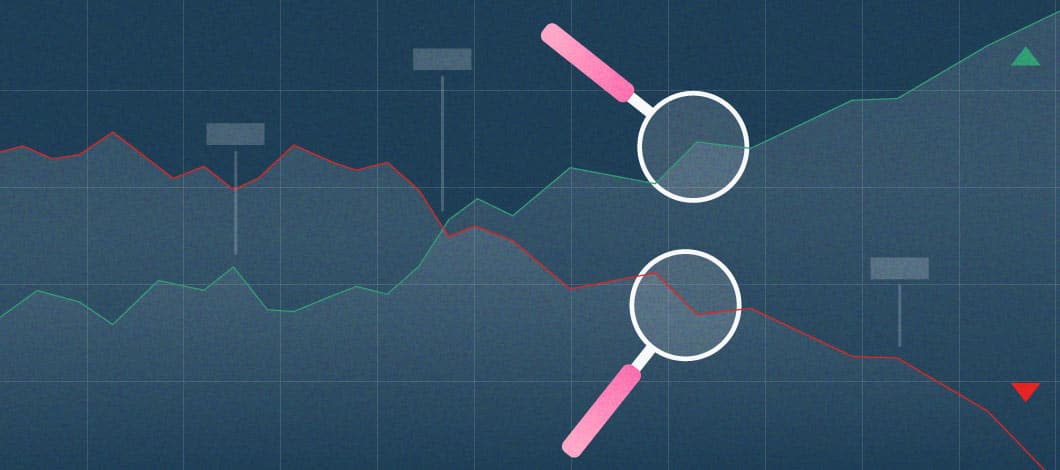
Issues With Pro-Forma Financial Statements
While pro forma financials are useful for management to evaluate the consequences of various alternatives, they can sometimes present more optimistic pictures of future results. GAAP requirements are often omitted from pro forma statements because they result in more negative reporting.
For example, GAAP requires deductions for such expenses as depreciation, amortization , restructuring expenses, one-time costs, stock payouts and employee stock options. Management might not feel that some of these expenses affect cash flow or are not part of normal operating costs, however.
Litigation is another area of difference between GAAP and pro forma financials. Occasionally, a company may receive an adverse judgment in a lawsuit. GAAP would require that this expense be reported on the company’s income statement, but management would not consider this to be a recurring expense and may elect to prepare pro forma statements that reflect normal operating results.
However, ongoing litigation might be a regularly occurring cost in some businesses, such as medical devices, and should be reported as a normal cost of doing business.
Pro Forma Statements and Budgets
The preparation of pro forma statements in various economic environments is useful for management to examine the consequences of rises in expenses or economic downturns. With the best guesses of future results, managers can prepare budgets for all departments to deal with the expected conditions.
The opposite is also true. Optimistic pro forma financials help managers prepare for increases in sales and profits. They may need to increase purchases of inventory, hire additional staff, lease more warehouse space and secure additional lending to finance the rise in current assets.
Management’s responsibility is to never get caught by surprise, anticipate changes and always be prepared for upcoming conditions. Pro forma financial statements are essential tools to meet those obligations.
They Are Essential ‘What If’ Modeling Tools
Pro forma statements are versatile. Managers can use them to play with various what-if scenarios. This might be the introduction of a new product, the acquisition of another company, the purchase of new equipment or the closing of a money-losing division. The objective is to examine various alternatives and determine the best course for the business.
- About the Author
- Latest Posts
Why Is the Federal Reserve Raising Interest Rates (and What to Expect)?
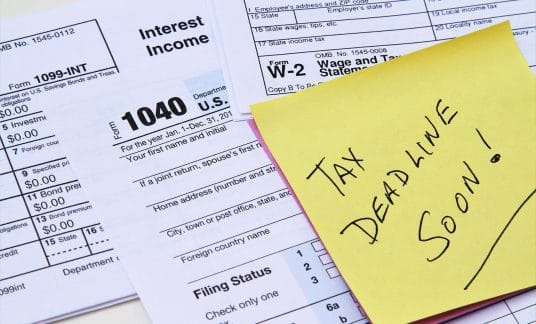
When Are Small Business Taxes Due?

48 Ecommerce Statistics to Know This Year

13 Best Industries to Invest in for 2024
On a similar note..., you may also like..., explore our most popular tools.

You’re subscribed!

No products in the cart.
Building Pro Forma Financial Statements – A Step-by-Step Guide
Welcome to the world of pro forma analysis, a term that might sound as daunting as learning a new language but, in reality, is a powerful tool in the arsenal of any business owner or financial enthusiast. At its core, a pro forma analysis involves creating financial statements that project a company’s future financial performance based on certain assumptions and scenarios. Think of it as the financial crystal ball that allows businesses to anticipate outcomes, plan for various futures, and make decisions today that will set them up for success tomorrow.
I remember the first time I was introduced to a pro forma analysis. It was during my early days in the finance sector, fresh out of college, with enthusiasm to match my inexperience. The document was laid out in front of me, filled with numbers, projections, and terms that seemed as cryptic as hieroglyphics. I recall thinking, “Is this finance, or have I accidentally stumbled into an archaeology lecture?”
In this guide, I aim to be the mentor I had (and sometimes wished I had) during those early days, breaking down pro forma analysis into digestible, manageable parts. So, let’s embark on this journey together, turning the seemingly ancient script of pro forma analysis into a clear roadmap toward your business’s financial future .
Key Takeaways
- Pro forma financial statements are essential tools for forecasting and planning the financial future of your business, offering a detailed look at potential revenues, expenses, and cash flows .
- Accurate pro forma analysis requires a blend of historical data, market research, and conservative projections, ensuring that optimism is balanced with realism to avoid overestimating success.
- Regularly updating and reviewing your pro forma statements can help you navigate through business decisions more effectively, allowing you to adjust strategies in response to internal changes or external market conditions.
- Learning from mistakes and adopting a continuous improvement approach is key; each error provides valuable lessons that can refine your forecasting techniques and improve your business’s financial health.
What Is A Pro Forma?

At its heart, pro forma analysis is a financial tool that businesses use to forecast future financial performance.
Imagine you’re planning a road trip across the country. You wouldn’t just hop in the car and drive off without mapping your route, would you? Similarly, in business, you can’t steer towards success without a clear plan. This is where pro forma analysis comes into play; it’s like the GPS for your business, guiding you through the financial landscapes of the future.
Now, why is this so important? For starters, pro forma analysis helps you make educated guesses about your company’s future revenue, expenses, and overall financial health. It’s like looking into a crystal ball, except instead of vague predictions, you get detailed forecasts based on solid assumptions and data.
One of the key purposes of pro forma analysis is forecasting financial performance. This isn’t just about predicting how much money you’ll make; it’s about understanding how various factors like market trends, new product launches, or changes in pricing could impact your finances. By playing out different “what if” scenarios, you can prepare for the future with confidence, making strategic decisions that propel your business forward.
Another significant benefit is its ability to attract investors. Imagine trying to convince someone to invest in a journey without showing them the map or the destination. Pro forma statements serve as that map, providing potential investors with a clear vision of where your business is headed and the financial milestones you expect to hit along the way. In fact, the Securities and Exchange Commission under part 210 requires a pro forma statement under certain circumstances.
Gathering Necessary Information
Embarking on the journey of creating a pro forma analysis can feel akin to preparing for a grand culinary adventure. Just as a chef gathers all the necessary ingredients before beginning to cook, you too must assemble the right mix of data to craft your financial forecast. The key ingredients? Historical financial data and market research.
Essential Data:
- Historical Financial Data : This forms the backbone of your analysis. You’ll need your business’s income statements , balance sheets, and cash flow statements from at least the past two to three years. Think of this as the base stock of your financial soup, providing depth and flavor (or in this case, context and credibility) to your projections.
- Market Research : To spice things up and tailor your forecast to reality, incorporate market research. Understand industry trends, customer demand, and competitive landscape. This helps in adjusting your projections to reflect potential market shifts.
- Cost Structures and Pricing Strategies : Knowing how your costs behave and how you price your offerings is crucial. It’s like understanding the seasoning – too much or too little can drastically alter the outcome.
- Investment and Financing Plans : If you’re planning significant investments or expect changes in your financing (like taking out a loan), these should be included. They’re the garnish that can change the dish’s presentation and appeal.
Where and How to Gather This Data:
- Historical Financials : Start with your own accounting software or financial records to understand the company’s historical health. If you’re meticulous with bookkeeping, you’ve got a treasure trove waiting to be analyzed.
- Market Research : Dive into industry reports, surveys, and databases. Online platforms like Statista or IBISWorld can be gold mines. Don’t overlook the value of talking directly to customers or conducting surveys for fresh insights.
- Public Records and Reports : For competitor analysis and industry trends, public company filings and industry association reports are invaluable resources. They’re like secret recipes shared in plain sight.
Personal Treasure Hunt Story:
When I first ventured into the realm of business budgeting for my startup, I felt like a novice treasure hunter without a map. My quest for data led me down various paths, from scouring through forgotten files on my computer to diving deep into the depths of online research databases.
I remember one late night, fueled by coffee and determination, I stumbled upon a comprehensive industry report that was the final piece of the puzzle I needed. It was a eureka moment, akin to finding a hidden treasure chest.
Pro Forma Financial Statements
Let’s break down the main components of a pro forma analysis into something more digestible – think of it as separating your ingredients before baking a cake.
Pro Forma Income Statement
First up, we have the pro forma income statement, also known as the profit and loss statement . This is essentially your business’s scorecard over a specific period. It tells you how much revenue you’re bringing in (sales of products or services), subtracts the costs associated with making that money (like materials and labor ), and shows what’s left over, which we hope is a profit.
Pro Forma Balance Sheet
Next on our list of financial statements is the pro forma balance sheet . If the income statement was about the flow of the game, the balance sheet is the snapshot at halftime. It shows everything your company owns (assets) and owes (liabilities), plus equity , at a specific point in time.
Pro Forma Cash Flow Statement
Last but certainly not least, we have the pro forma cash flow statement. This document is like the hydration strategy for your marathon; it tracks the flow of cash in and the cash disbursements out of your business. It helps ensure you don’t run out of liquid assets (cash) by showing when you might need a financial water station. Breaking it down, it covers operating activities (daily business operations), investing activities (buying and selling assets), and financing activities (loans and investments).
Free Excel Template: Pro Forma Financial Statements
Make sure to download a copy of our free Excel template to follow along with the examples and build your own pro forma!
Creating a Pro Forma Income Statement
Crafting pro forma income statements might initially seem like you’re trying to assemble a piece of furniture with instructions in another language. But fear not! I’ll guide you through this process with clear steps. Let’s break it down together, shall we?
Step 1: Project Your Revenues

The first step is akin to predicting how popular your lemonade stand will be at the neighborhood block party. You’ll need to consider factors such as past sales data, market trends, and any upcoming products or services. If you’re just starting, look at industry benchmarks or conduct market research to make educated guesses. Remember, optimism is good, but realism pays the bills. Aim for a balance between hope and practicality.
Step 2: Estimate Your Costs of Goods Sold (COGS)

Now, think about what it costs to squeeze those lemons and stir in that sugar. COGS includes the direct costs attributable to the production of the goods sold in your business. This can range from raw materials to labor directly tied to service delivery. A pro tip here is to always err on the side of caution; it’s better to be pleasantly surprised than caught off guard.
Step 3: Calculate Gross Margin

Subtract your COGS from your projected revenues to find your gross margin. This figure is like the pot of gold at the end of the rainbow, showing you what’s left after covering the direct costs of your products or services. It’s a crucial indicator of your business’s financial health and efficiency.
Step 4: Outline Operating Expenses

Operating expenses are the costs associated with running your business that aren’t directly tied to making your product or service. Think of these as the essentials needed to keep the lights on and the doors open—rent, utilities, marketing, salaries for non-production staff, and so on. Keeping track of these expenses helps ensure your business operates smoothly without financial hiccups.
Step 5: Forecast Net Income

Finally, subtract your operating expenses from your gross margin to arrive at your net income. This give your pro forma earnings and is the moment of truth, revealing whether your business is on track to make a profit or if adjustments are needed. It’s like the final score of a game, showing you where you stand after all the plays have been made.
Practical Advice:
- Use Conservative Estimates : It’s tempting to assume best-case scenarios, but it’s wise to lean towards conservatism in your projections. Think of it as packing an umbrella for a sunny day—better safe than sorry.
- Consider Different Scenarios : Life is full of surprises, and so is business. Create a few different versions of your income statement based on various scenarios (e.g., an increase in material costs or a dip in market demand). It’s like having a plan B (and C) in your back pocket.
Example From My Experience
I once worked with a café owner who was looking to expand their business. We used local population data and identified coffee consumption trends to project potential sales growth. By considering factors like the increase in remote workers seeking café spots and the popularity of seasonal beverages, we crafted a realistic revenue projection.
The exercise was eye-opening. Not only did it help refine the café’s strategy, but it also prepared the owner for potential challenges ahead. And yes, the pumpkin spice latte season was indeed a hit!
Crafting Your Pro Forma Balance Sheet
Embarking on the journey to create a pro forma balance sheet can feel a bit like setting up a sophisticated piece of furniture with an array of parts spread before you. You know it’s going to look fantastic once assembled, but first, you’ve got to figure out where everything goes. Let’s dive in, ensuring that by the end, you’ll not only have all the pieces in place but also understand exactly what they represent.
Understanding the Basics

Pro forma balance sheets are essentially a snapshot of your business’s financial health at a future point in time. It outlines three key components: assets, liabilities, and equity.
- Assets : Think of assets as everything your business owns that has value. This includes cash in the bank, inventory, equipment, and even the office coffee machine that keeps everyone perky and productive.
- Liabilities : These are your financial obligations; what you owe others. Whether it’s loans, unpaid bills, or that IOU note from when you borrowed cash to cover a surprise expense, they all count here.
- Equity : Equity is what’s left over when you subtract liabilities from assets. It’s the ‘true value’ of your business to its owners. Imagine filling a jar with layers of sand (assets) and then pouring water (liabilities) into it. The space not filled by water represents your equity.
Projecting with Precision
When projecting your assets, consider both your current resources and those you plan to acquire. Remember, accuracy is key. Overestimating assets can lead to overly optimistic equity calculations, akin to thinking you can run a marathon without training. Underestimating, however, might deter potential investors or lenders.
For liabilities, factor in existing debts and anticipated future borrowings. This foresight is crucial for maintaining a realistic view of your financial obligations and ensuring you don’t find yourself in hot water down the line.
A Lesson I Learned The Hard Way
Speaking of equipment, let me share a little tale from my own vault of “oops” moments. Early in my finance journey, I was tasked with creating a pro forma balance sheet for a small bakery. In my eagerness, I meticulously accounted for every ingredient, from flour to yeast, but forgot to include the new industrial oven the bakery was planning to purchase.
This wasn’t just any oven; it was the heart of the bakery’s expansion plan, significantly impacting both assets and liabilities. The oversight led to a considerable underestimation of future liabilities (since the oven was to be financed) and, by extension, equity. Needless to say, I had to redo the entire analysis, a humbling reminder of the importance of double-checking your work and considering all aspects of your business operations.
Preparing a Pro Forma Cash Flow Statement
Ah, the pro forma cash flow statement, the unsung hero of financial projections. It’s like the pulse check for your business, ensuring you don’t end up gasping for air (financially speaking). Let’s dive into how you can forecast cash inflows and outflows with the precision of a skilled gardener ensuring their plants thrive.

Forecasting Cash Inflows
Cash inflows are essentially the lifeblood of your business. These come from sales, returns on investments, loans, and any other sources that inject cash into your business. To forecast these, start by looking at your sales trends. Are there certain times of the year when you make the lion’s share of your sales? Factor in new product launches or seasonal promotions you’re planning. Also, consider the payment terms you’ve negotiated with clients – not all income might be as prompt as we’d wish.
Imagine you’re planning how much water your garden needs. You’d consider the rain forecast (seasonal trends), whether you’re planting more thirsty plants (new products), and how well your soil retains moisture (cash on hand).
Forecasting Cash Outflows
Next up, cash outflows, which include expenses like rent, salaries, supplier payments, and any loan repayments. This step requires you to be as meticulous as a chef preparing a Michelin-star meal. Break down your expenses into fixed (rent, salaries) and variable (materials, utilities) categories. Remember, some payments don’t occur monthly but quarterly or annually, so factor these into your timeline accurately.
It’s similar to knowing when to water your garden and when to add fertilizer or pesticide. Some plants need constant attention (fixed costs), while others may only need seasonal care (variable costs).
Case Study From My Experience
I recall a time when I was helping a friend forecast the cash flow for their startup. In our enthusiasm, we planned for significant marketing spend without accounting for the delayed income from their payment terms. Halfway through the season, it was clear we had “overwatered” their operations. We had to quickly adjust our “gardening strategy,” securing a short-term loan to cover the gap. It was a lesson in the importance of balancing our financial ecosystem carefully.
Analyzing Your Pro Forma Financial Statements
Imagine your pro forma statements as a detailed map of the terrain ahead. Just as a hiker uses a map to decide whether to cross a river at its narrowest point or take a bridge, you use your pro forma financial statement to navigate through business decisions.
For example, if your cash flow statement predicts a cash surplus, you might decide it’s the perfect time to invest in that new piece of equipment. Conversely, a forecasted tight spot might suggest delaying expansion plans in favor of shoring up reserves.
Common Pitfalls When Creating Pro Forma Statements
- Over-Optimism : It’s easy to fall into the trap of rose-colored forecasts. Always ground your projections in reality and remember that hope is not a strategy. It’s like expecting to win a marathon without training, based solely on the belief that you’re a fast runner.
- Ignoring Market Trends : Not keeping an eye on the market is like ignoring weather warnings on a hiking trip. Stay informed about industry shifts to ensure your projections remain relevant and realistic.
- Forgetting to Update Your Statements : Pro forma statements are not set-it-and-forget-it artifacts. They’re more like living documents that require regular updates to reflect both internal changes and external market conditions.
Practical Application – Case Study
Let’s roll up our sleeves and dive into a case study that brings the mystical art of pro forma analysis down to earth. Imagine we’re looking at “Bea’s Boutique,” a small but spirited clothing store nestled in the heart of a bustling neighborhood.
The Scenario
Bea’s Boutique has been the go-to spot for fashion-forward attire for three years. As the boutique gears up for its fourth year, Bea decides it’s time to expand her offerings and possibly renovate the space to attract more foot traffic. She knows this will require a significant investment and wonders if the numbers add up in favor of her vision.
Step 1: Setting the Stage with Historical Data
Bea starts by gathering her sales data, costs, and cash flow statements from the past three years. It’s a bit like detective work, sifting through files and receipts, but it gives her a solid foundation. She notes a steady increase in sales each year and identifies seasonal trends that impact her business.
Step 2: Market Research and Forecasting
Next, Bea conducts market research. She surveys her customers, chats with other local business owners, and keeps an eye on upcoming fashion trends. This helps her anticipate an increase in sales with the introduction of new product lines and a renovated space. Bea projects a 20% increase in sales for the next year, keeping her estimates conservative to stay grounded.
Step 3: Crunching the Numbers
Armed with her historical data and market research, Bea crafts her pro forma income statement. She factors in the cost of renovations, additional inventory purchases, and potential increases in staffing. For her cash flow projections, she considers the timing of her investment and the gradual increase in sales. It’s a balancing act, ensuring she has enough cash on hand to cover expenses during the renovation phase.
Step 4: The Moment of Truth
With her pro forma statements prepared, Bea takes a deep breath and reviews the numbers. The pro forma financial information shows a tight first six months post-renovation, with cash reserves taking a dip. However, as the increased sales begin to kick in, the future looks promising, with a return to healthy cash flow levels and profitability.
Lessons Learned
- Start with Solid Groundwork : Gathering comprehensive historical data was crucial for Bea. It gave her a clear picture of where the business stood and how it had grown over time.
- Research is Key : Understanding the market and her customers helped Bea make informed decisions about her expansion plans and set realistic sales projections.
- Conservatism Pays Off : By keeping her projections conservative, Bea avoided the trap of overestimating her success and underestimating her expenses.
- Prepare for the Lean Times : Recognizing that her cash flow would be tight initially, Bea planned accordingly, ensuring she had a buffer to cover expenses during the slower months.
Practical Tips for Your Business
- Don’t Skip the Prep : Spend the time needed to gather your data and understand your market. It’s the foundation of accurate forecasting.
- Stay Grounded : It’s easy to get carried away by optimism. Keep your estimates realistic to avoid unpleasant surprises down the line.
- Plan for All Seasons : Every business has its ups and downs. Make sure your financial plans account for the lean times, not just the peaks.
Bea’s journey through pro forma analysis not only illuminated the path for her boutique’s expansion but also provided a blueprint for managing future growth. By approaching the process with diligence, realism, and a touch of optimism, she was able to make informed decisions that aligned with her vision for Bea’s Boutique. Just like Bea, you can apply these steps and lessons to navigate your business’s financial future with confidence.
Frequently Asked Questions
Do pro forma financial statements have to meet generally accepted accounting principles.
While it is not a requirement for pro forma financial statements to meet Generally Accepted Accounting Principles (GAAP), it is generally recommended to adhere to these principles for accuracy and consistency.
What Is A Pro Forma Invoice?
Pro forma invoices are a commercial invoice that outlines the anticipated costs and terms of a transaction or sale. It is typically used in international trade to provide an estimated cost for goods or services before they are delivered.
Have any questions on building pro forma financial statements? Are there other topics you would like us to cover? Leave a comment below and let us know! And make sure to subscribe to our Newsletter to receive exclusive financial news right to your inbox.
Related Posts
- The Ultimate Guide to 50+ Financial Modeling Resources
- The Easy Guide To Calculating MACRS Depreciation In Excel
- Your Flux Analysis Step-By-Step Survival Guide
- How To Do Account Reconciliation Without Pulling Your Hair Out
- Taking Vertical Analysis To The Next Level
- Your Unconventional Guide To Managing Working Capital
FP&A Leader | Digital Finance Advocate | Small Business Founder
Mike Dion brings a wealth of knowledge in business finance to his writing, drawing on his background as a Senior FP&A Leader. Over more than a decade of finance experience, Mike has added tens of millions of dollars to businesses from the Fortune 100 to startups and from Entertainment to Telecom. Mike received his Bachelor of Science in Finance and a Master of International Business from the University of Florida, laying a solid foundation for his career in finance and accounting. His work, featured in leading finance publications such as Seeking Alpha, serves as a resource for industry professionals seeking to navigate the complexities of corporate finance, small business finance, and finance software with ease.
Leave a Reply Cancel reply
Your email address will not be published. Required fields are marked *
To provide the best experiences, we and our partners use technologies like cookies to store and/or access device information. Consenting to these technologies will allow us and our partners to process personal data such as browsing behavior or unique IDs on this site and show (non-) personalized ads. Not consenting or withdrawing consent, may adversely affect certain features and functions.
Click below to consent to the above or make granular choices. Your choices will be applied to this site only. You can change your settings at any time, including withdrawing your consent, by using the toggles on the Cookie Policy, or by clicking on the manage consent button at the bottom of the screen.
“As a matter of” or “For the sake of form”
What does Pro Forma Mean?
Pro forma is Latin for “as a matter of” or “for the sake of form.” It is used primarily in reference to the presentation of information in a formal way, assuming or forecasting pieces of information that may be unavailable.

In most cases, pro forma documentation is used to present a reasonable representation of what an anticipated occurrence will look like, often a cash expense for shipments. Pro forma statements show the underlying assumptions about the shipment and what the documentation will look like if the assumptions are proven true.
Pro Forma Income Statements
Pro forma statements are useful with regard to tracking future financial direction and occurrences, often including some historical numbers to help account for what the projected outcomes should look like. In the event that the projected numbers show that profits are likely to drop, the pro forma statement allows a company to see the need for changes in its operations to prevent decreased profitability. The changes can include cutting costs or increasing the price of goods and services.
Pro forma income statements are important because of the information they can offer a company. If, for example, it is preparing to produce new goods, the financial statements can help forecast if producing the new goods will cause expenses to increase. This enables the company to accommodate any potential for profit/loss by changing production strategy , materials, or even the rate at, or timing of, the production of the goods.
Letters of Intent
Pro forma documents, in any form, are essentially like letters of intent , expressing what an invoice or transaction is anticipated to look like after completion. The documents are often used to express interest in business transactions or reveal the intended purpose and outcome of the transaction.
Any documents that deal with a company and its earnings must follow the Generally Accepted Accounting Principles (GAAP) , established by the Securities Exchange Commission (SEC). For small businesses, application for a Small Business Administration loan often requires the production of a pro forma financial document. Regardless of the arena in which a pro forma document is used, it is an important tool for forecasting outcomes and ensuring that the desired outcomes are met.
Additional Resources
CFI offers the Financial Modeling & Valuation Analyst (FMVA)™ certification program for those looking to take their careers to the next level. To keep learning and advancing your career, the following CFI resources will be helpful:
- Bill of Lading
- Confidential Information Memorandum (CIM)
- Source Documents
- Three Financial Statements
- See all accounting resources
Accounting Crash Courses
Learn accounting fundamentals and how to read financial statements with CFI’s online accounting classes . These courses will give you the confidence to perform world-class financial analyst work. Start now!
Boost your confidence and master accounting skills effortlessly with CFI’s expert-led courses! Choose CFI for unparalleled industry expertise and hands-on learning that prepares you for real-world success.
- Share this article
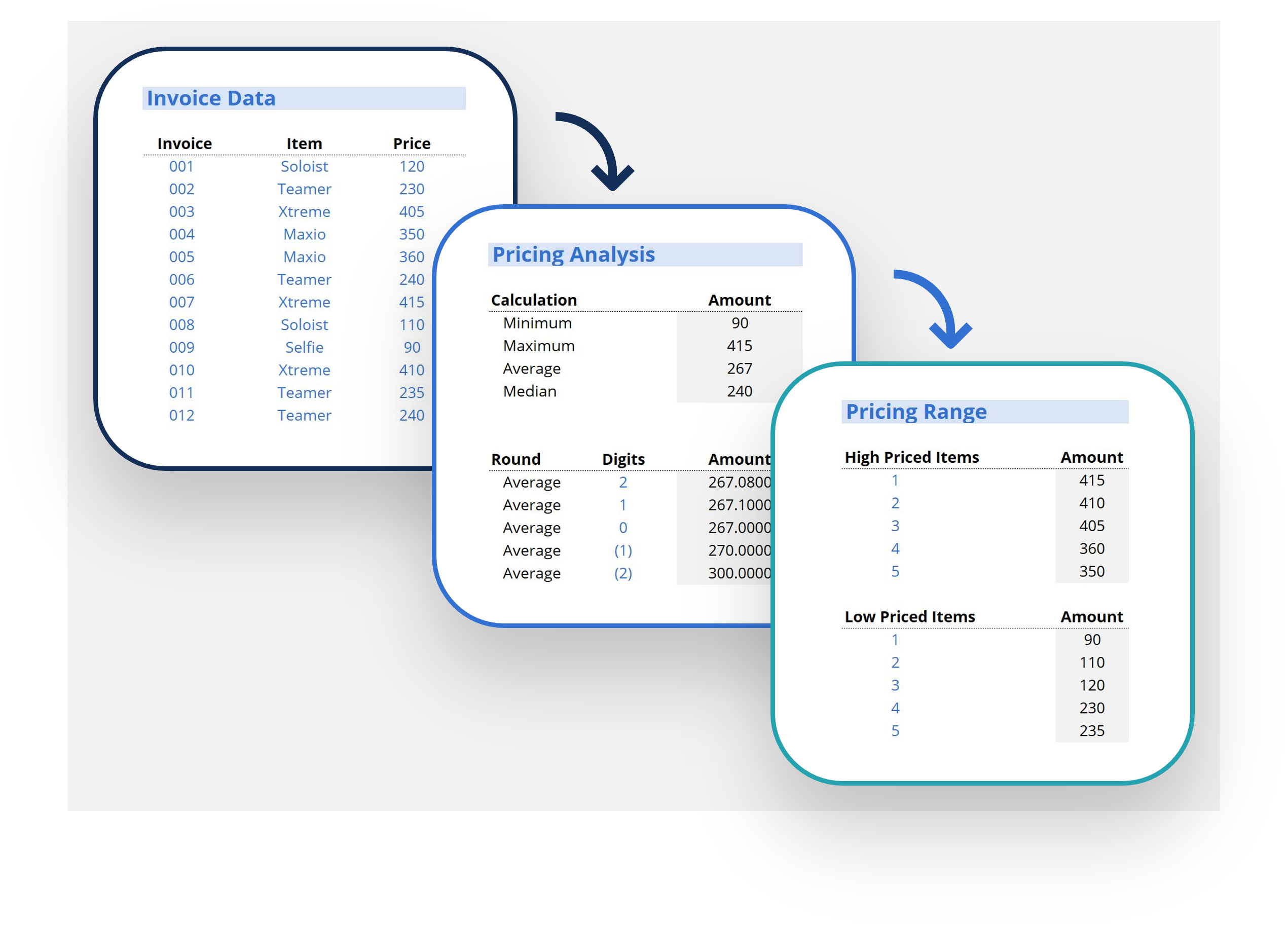
Create a free account to unlock this Template
Access and download collection of free Templates to help power your productivity and performance.
Already have an account? Log in
Supercharge your skills with Premium Templates
Take your learning and productivity to the next level with our Premium Templates.
Upgrading to a paid membership gives you access to our extensive collection of plug-and-play Templates designed to power your performance—as well as CFI's full course catalog and accredited Certification Programs.
Already have a Self-Study or Full-Immersion membership? Log in
Access Exclusive Templates
Gain unlimited access to more than 250 productivity Templates, CFI's full course catalog and accredited Certification Programs, hundreds of resources, expert reviews and support, the chance to work with real-world finance and research tools, and more.
Already have a Full-Immersion membership? Log in
- Search Search Please fill out this field.
What Is Pro Forma?
:max_bytes(150000):strip_icc():format(webp)/ScreenShot2020-03-23at2.04.43PM-59de96b153e540c498f1f1da8ce5c965.png)
- Definition/Examples of Pro Forma Financials
How Pro Forma Financial Statements Work
Types of pro forma statements, what it means for individual investors.
Svitlana Hulko / Getty Images
A pro forma financial statement is a projection showing numbers that do not reflect the actual results from a company’s history.
Key Takeaways
- Pro forma financial statements illustrate how a company’s financial position might change in the future.
- Projections about the future are not required to follow the strictest accounting standards, but companies must avoid committing fraud when creating pro formas.
- Because it’s impossible to predict the future, pro forma financial statements should only be considered an estimate.
Definition and Examples of Pro Forma Financials
Pro forma financial statements project how a company might perform in the future if the business takes an assumed course of action. It may include a best-case or worst-case scenario.
For example, the company might merge with or purchase another business, and the outcome could affect both cash flow and profits. Alternatively, the organization might need to make a major equipment purchase, and it’s important to know the financial impact of that transaction. In both cases, a pro forma could detail the expected results.
- Alternate name : Pro forma financial statement
While pro forma often refers to assumptions about future events, it can also refer to financial reports with irregular transactions removed. For example, if a company experienced significant restructuring charges in a given period, a pro forma might show how the company would have performed if those charges never occurred.
When deciding whether or not to invest in a company or a project, it’s reasonable to wonder how the future will unfold. There’s no way to predict the future with certainty, but you can analyze multiple “what if” scenarios to understand the potential outcomes. Pro forma financial statements enable investors to do that with available information.
Companies in the U.S. follow Generally Accepted Accounting Principles (GAAP) as a best practice. While GAAP standards set guidelines on reporting information accurately and transparently, sometimes it’s useful to include or exclude information. In particular, you might want to know how an anticipated change may affect a company’s earnings. For example, if an energy company is planning to build a new power plant, investors may wonder how that project will affect the company’s profits. Pro forma exercises provide a preview of expected outcomes.
While pro forma financial statements project the future, there is no guarantee that those predictions are accurate. Unexpected events, bad assumptions, and other factors can lead to dramatically different results.
Unknown Future
A pro forma financial statement is supposed to include reasonably accurate information. However, companies that create these documents have some leeway in their assumptions. They might be overly optimistic or omit important information investors need to know about.
Companies are generally prohibited from creating misleading or fraudulent pro forma financial statements. Still, there may be some gray areas, so use caution when relying on future projections.
Some of the most commonly used financial statements for pro forma are the income statement, the cash flow statement, and the balance sheet.
Pro forma financial statements might show the expected impact of any projects in the pipeline. For example, they may assume a company plans to build a new facility to produce more goods for customers.
A pro forma income statement would show how the company’s revenues and expenses might change and ultimately affect company profits. Income statements would show how much it would cost a company to pursue the project and how much revenues might improve after completion.
A pro forma cash flow statement could detail any payments involved in a hypothetical project. For example, the company might have to pay for land, materials, and fees to contractors who build the facility. Later, after the project is completed, the cash flow statement might assume increased payments from customers.
The pro forma balance sheet might change if the new facility adds to the company’s property, plant, and equipment entries. And if the company uses debt to fund the project, there might also be a substantial loan balance on the liabilities side of the balance sheet.
Pro forma financial statements provide predictions on how the future might unfold for companies you’re investing in. With that information, you can conduct ratio analyses using hypothetical numbers and gain insight into how projects might affect the value of your investment.
While it’s helpful to know what a company’s management has planned, it’s important to view these projections with skepticism. Nobody can predict the future, and managers might (even with the best intentions) use overly optimistic assumptions in their pro formas. So consider the possibility of less-optimistic outcomes as well.
Securities and Exchange Commission. " Cautionary Advice Regarding the Use of 'Pro Forma' Financial Information in Earnings Releases ." Accessed Aug. 16, 2021.
What is a Business Plan? Definition, Tips, and Templates
Updated: June 28, 2024
Published: August 04, 2020
Years ago, I had an idea to launch a line of region-specific board games. I knew there was a market for games that celebrated local culture and heritage. I was so excited about the concept and couldn't wait to get started.

But my idea never took off. Why? Because I didn‘t have a plan. I lacked direction, missed opportunities, and ultimately, the venture never got off the ground.

And that’s exactly why a business plan is important. It cements your vision, gives you clarity, and outlines your next step.
In this post, I‘ll explain what a business plan is, the reasons why you’d need one, identify different types of business plans, and what you should include in yours.
Table of Contents
What is a business plan?
What is a business plan used for.
- Business Plan Template [Download Now]
Purposes of a Business Plan
What does a business plan need to include, types of business plans.
.webp)
Free Business Plan Template
The essential document for starting a business -- custom built for your needs.
- Outline your idea.
- Pitch to investors.
- Secure funding.
- Get to work!
Download Free
All fields are required.
You're all set!
Click this link to access this resource at any time.
A business plan is a comprehensive document that outlines a company's goals, strategies, and financial projections. It provides a detailed description of the business, including its products or services, target market, competitive landscape, and marketing and sales strategies. The plan also includes a financial section that forecasts revenue, expenses, and cash flow, as well as a funding request if the business is seeking investment.
The business plan is an undeniably critical component to getting any company off the ground. It's key to securing financing, documenting your business model, outlining your financial projections, and turning that nugget of a business idea into a reality.
The purpose of a business plan is three-fold: It summarizes the organization’s strategy in order to execute it long term, secures financing from investors, and helps forecast future business demands.
Business Plan Template [ Download Now ]

Working on your business plan? Try using our Business Plan Template . Pre-filled with the sections a great business plan needs, the template will give aspiring entrepreneurs a feel for what a business plan is, what should be in it, and how it can be used to establish and grow a business from the ground up.
In an era where 48% of businesses survive half a decade on, having a clear, defined, and well-thought-out business plan is a crucial first step for setting up a business for long-term success.
Here’s why I think a business plan is important:
1. Securing Financing From Investors
Since its contents revolve around how businesses succeed, break-even, and turn a profit, a business plan is used as a tool for sourcing capital. This document is an entrepreneur's way of showing potential investors or lenders how their capital will be put to work and how it will help the business thrive.
I’ve seen that all banks, investors, and venture capital firms will want to see a business plan before handing over their money. Therefore, these investors need to know if — and when — they‘ll be making their money back (and then some).
Additionally, they’ll want to read about the process and strategy for how the business will reach those financial goals, which is where the context provided by sales, marketing, and operations plans come into play.
2. Documenting a Company's Strategy and Goals
I think a business plan should leave no stone unturned.
Business plans can span dozens or even hundreds of pages, affording their drafters the opportunity to explain what a business' goals are and how the business will achieve them.
To show potential investors that they've addressed every question and thought through every possible scenario, entrepreneurs should thoroughly explain their marketing, sales, and operations strategies — from acquiring a physical location for the business to explaining a tactical approach for marketing penetration.
These explanations should ultimately lead to a business' break-even point supported by a sales forecast and financial projections, with the business plan writer being able to speak to the why behind anything outlined in the plan.
3. Legitimizing a Business Idea
I’ve seen that everyone‘s got a great idea for a company — until they put pen to paper and realize that it’s not exactly feasible.
A business plan is an aspiring entrepreneur's way to prove that a business idea is actually worth pursuing.
As entrepreneurs document their go-to-market process, capital needs, and expected return on investment, entrepreneurs likely come across a few hiccups that will make them second guess their strategies and metrics — and that's exactly what the business plan is for.
It ensures you have everything in order before bringing their business idea to the world and reassures the readers that whoever wrote the plan is serious about the idea, having put hours into thinking of the business idea, fleshing out growth tactics, and calculating financial projections.
4. Getting an A in Your Business Class
Speaking from personal experience, there‘s a chance you’re here to get business plan ideas for your Business 101 class project.
If that's the case, might I suggest checking out this post on How to Write a Business Plan , which provides a section-by-section guide on creating your plan?
5. Identifying Potential Problems
Business plans act as early warning systems that identify potential problems before they escalate into major obstacles.
How? When you conduct thorough market research, analyze competitor strategies, and evaluate financial projections, your plan pinpoints vulnerabilities and risks. This allows you to develop contingency plans and risk mitigation strategies.
This helps you prevent costly mistakes and shows investors and lenders you’re well-prepared and have considered various scenarios.
6. Attracts and Retains Talent
A well-articulated plan outlines your company's vision, mission, and values, showcasing a clear direction and purpose. People who want meaningful work that aligns with their ambitions will love this.
Also, it shows the company's potential for growth and stability. This instills confidence in employees and assures them of a secure future and opportunities for career advancement.
When you show growth potential and highlight a positive work culture, your business plan becomes a magnet for top talent.
7. Provides a Roadmap
A business plan provides a detailed roadmap for your company's future. It outlines your objectives, strategies, and the specific actions you need to achieve your goals.
When you define your path forward, a business plan helps you stay focused and on track, even when you face challenges or distractions. It’s a great reference tool that allows you to make smart decisions that align with your overall vision.
This way, having a comprehensive roadmap in the form of a business plan provides direction and clarity at every stage of your business journey.
8. Serves as a Marketing Tool
A business plan is not only an internal guide but also serves as a powerful marketing tool. Your business plan can showcase your company‘s strengths, unique value proposition, and growth potential when you’re looking for investors, partnerships, or new clients.
It provides a professional and polished overview of your business, which shows your commitment and strategic thinking to potential stakeholders.
Your business plan helps you attract the right people by clearly articulating your target market, competitive advantages, and financial projections. In summary, it acts as a persuasive sales pitch.
- Business Plan Subtitle
- Executive Summary
- Company Description
- The Business Opportunity
- Competitive Analysis
- Target Market
- Marketing Plan
- Financial Summary
- Funding Requirements
1. Business Plan Subtitle
Every great business plan starts with a captivating title and subtitle. You’ll want to make it clear that the document is, in fact, a business plan, but the subtitle can help tell the story of your business in just a short sentence.
2. Executive Summary
Although this is the last part of the business plan that you’ll write, it’s the first section (and maybe the only section) that stakeholders will read.
The executive summary of a business plan sets the stage for the rest of the document. It includes your company’s mission or vision statement, value proposition, and long-term goals.
3. Company Description
This brief part of your business plan will detail your business name, years in operation, key offerings, and positioning statement.
You might even add core values or a short history of the company. The company description’s role in a business plan is to introduce your business to the reader in a compelling and concise way.
4. The Business Opportunity
The business opportunity should convince investors that your organization meets the needs of the market in a way that no other company can.
This section explains the specific problem your business solves within the marketplace and how it solves them. It will include your value proposition as well as some high-level information about your target market.

5. Competitive Analysis
Just about every industry has more than one player in the market. Even if your business owns the majority of the market share in your industry or your business concept is the first of its kind, you still have competition.
In the competitive analysis section, you’ll take an objective look at the industry landscape to determine where your business fits. A SWOT analysis is an organized way to format this section.
6. Target Market
Who are the core customers of your business and why? The target market portion of your business plan outlines this in detail. The target market should explain the demographics, psychographics, behavioristics, and geographics of the ideal customer.
7. Marketing Plan
Marketing is expansive, and it’ll be tempting to cover every type of marketing possible, but a brief overview of how you’ll market your unique value proposition to your target audience, followed by a tactical plan, will suffice.
Think broadly and narrow down from there: Will you focus on a slow-and-steady play where you make an upfront investment in organic customer acquisition? Or will you generate lots of quick customers using a pay-to-play advertising strategy?
This kind of information should guide the marketing plan section of your business plan.
8. Financial Summary
Money doesn’t grow on trees. Even the most digital, sustainable businesses have expenses. Outlining a financial summary of where your business is currently and where you’d like it to be in the future will substantiate this section.
Consider including any monetary information that will give potential investors a glimpse into the financial health of your business. Assets, liabilities, expenses, debt, investments, revenue, and more are all useful additions here.
So, you’ve outlined some great goals, the business opportunity is valid, and the industry is ready for what you have to offer. Who’s responsible for turning all this high-level talk into results?
The “team” section of your business plan answers that question by providing an overview of the roles responsible for each goal.
Don’t worry if you don’t have every team member on board yet. Knowing what roles to hire for is helpful as you seek funding from investors.
10. Funding Requirements
Remember that one of the goals of a business plan is to secure funding from investors, so you’ll need to include funding requirements you’d like them to fulfill.
Considering that global funding fell 61% from 2021 to 2023 , it’s very important to be clear in this section. Include the amount your business needs, for what reasons, and for how long.
- Startup Business Plan
- Feasibility Business Plan
- Internal Business Plan
- Strategic Business Plan
- Business Acquisition Plan
- Business Repositioning Plan
- Expansion or Growth Business Plan
There’s no one size fits all business plan as there are several types of businesses in the market today. From startups with just one founder to historic household names that need to stay competitive, every type of business needs a business plan that’s tailored to its needs. Below are a few of the most common types of business plans.
For even more examples, check out these sample business plans to help you write your own .
1. Startup Business Plan

As one of the most common types of business plans, a startup business plan is for new business ideas. This plan lays the foundation for the eventual success of a business.
I think the biggest challenge with the startup business plan is that it's written completely from scratch. Startup business plans often reference existing industry data. They also explain unique business strategies and go-to-market plans.
Because startup business plans expand on an original idea, the contents will vary by the top priority goals.
For example, say a startup is looking for funding. If capital is a priority, this business plan might focus more on financial projections than marketing or company culture.
Eric Heckstall , the founder and CEO of EDH Signature Inc ., which offers premier grooming products, also suggests keeping your startup business plan short.
“The traditional business plan can be 40+ pages, which is too large of a document to really be useful, can be difficult for staff to understand, and have to dig for information which most people won’t do,” Heckstall says.
Conversely, a one-to-two-page business plan improves clarity and focus. Heckstall says this format “is easy to use on a day-to-day basis, teams as well as potential investors can understand the purpose and direction of the company, and can easily be incorporated into team meetings.”
2. Feasibility Business Plan

This type of business plan focuses on a single essential aspect of the business — the product or service. It may be part of a startup business plan or a standalone plan for an existing organization. This comprehensive plan may include:
- A detailed product description.
- Market analysis.
- Technology needs.
- Production needs.
- Financial sources.
- Production operations.
Startups can fail because of a lack of market need and mistimed products. Plus, nearly half of entrepreneurs , founders, CEOs, and COOs report that price sensitivity and evolving market conditions are the number one prospect and customer challenges they face right now.
Some businesses will complete a feasibility study to explore ideas and narrow product plans to the best choice. They conduct these studies before completing the feasibility business plan. Then, the feasibility plan centers on that one product or service.
Zach Dannett , co-founder at rug company Tumble highlights how some business owners take a very idealistic approach too. And forget barriers to entry like regulatory issues in the process.
He adds how considering this aspect in their business plan helped.
Before launching the team, Dannett first took time to understand regulatory requirements in our industry, checking to make sure we needed to secure any certifications or licenses.
Then, “we reviewed financial requirements, which would cover initial investments, operational costs, and potential expenses. We then conducted thorough market research to understand our market, how saturated this market is, and identify major competitors with significant market share,” Dannett says
3. Internal Business Plan

Internal business plans help leaders communicate company goals, strategy, and performance. This helps the business align and work toward objectives more effectively.
Besides the typical elements in a startup business plan, an internal business plan may also include:
- Department-specific budgets.
- Target demographic analysis.
- Market size and share of voice analysis.
- Action plans.
- Sustainability plans.
Most external-facing business plans focus on raising capital and support for a business. But, an internal business plan helps keep the business mission consistent in the face of change.
You can also reduce your workload by using a free business template that helps you get a headstart on what to include.
4. Strategic Business Plan

Strategic business plans focus on long-term objectives for your business. They usually cover the first three to five years of operations. This is different from the typical startup business plan which focuses on the first one to three years. The audience for this plan is also primarily internal stakeholders.
These types of business plans may include:
- Relevant data and analysis.
- Assessments of company resources.
- Vision and mission statements.
It's important to remember that, while many businesses create a strategic plan before launching, some business owners just jump in.
David Sides , marketing specialist at The Gori Law , highlights how it’s important not to create this plan in isolation and involve key stakeholders from across the organization in the planning process.
“We make a point of bringing together attorneys, paralegals, and support staff to discuss our long-term goals and how we can work together to achieve them. This not only helps ensure buy-in and alignment, but it also allows you to tap into a wider range of perspectives and ideas,” Sides says.
This way, the strategic business plan can add value by outlining how your business plans to reach specific goals and considering a holistic perspective from the most important stakeholders. This type of planning can also help a business anticipate future challenges.
5. Business Acquisition Plan

Investors use business plans to acquire existing businesses, too — not just new businesses.
I recommend including costs, schedules, or management requirements. This data will come from an acquisition strategy.
A business plan for an existing company will explain:
- How an acquisition will change its operating model.
- What will stay the same under new ownership.
- Why things will change or stay the same.
- Acquisition planning documentation.
- Timelines for acquisition.
Ilia Tretiakov , owner and lead strategist, at So Good Digital , a marketing agency suggests adding a Day Zero Plan. This is a thorough plan outlining the steps you will take the moment the acquisition is completed.
It consists of stakeholder communication plans, critical system integration, quick operational adjustments, and cultural alignment initiatives.
Here’s why Ilia believes it’s important.
“A Day Zero Plan establishes the framework for the integration process and guarantees a seamless transition. This comprehensive strategy goes above and beyond the typical post-acquisition integration plan, taking care of urgent issues and laying the groundwork for long-term success,” Tretiakov says,
Apart from this, I believe the business plan should speak to the current state of the business and why it's up for sale.
For example, if someone is purchasing a failing business, the business plan should explain why the business is being purchased. It should also include:
- What the new owner will do to turn the business around.
- Historic business metrics.
- Sales projections after the acquisition.
- Justification for those projections.
6. Business Repositioning Plan

When a business wants to avoid acquisition, reposition its brand, or try something new, CEOs or owners will develop a business repositioning plan.
This plan will:
- Acknowledge the current state of the company.
- State a vision for the future of the company.
- Explain why the business needs to reposition itself.
- Outline a process for how the company will adjust.
Companies planning for a business reposition often do so — proactively or retroactively — due to a shift in market trends and customer needs.
For example, shoe brand AllBirds plans to refocus its brand on core customers and shift its go-to-market strategy. These decisions are a reaction to lackluster sales following product changes and other missteps.
7. Expansion or Growth Business Plan
When your business is ready to expand, a growth business plan creates a useful structure for reaching specific targets.
For example, a successful business expanding into another location can use a growth business plan. This is because it may also mean the business needs to focus on a new target market or generate more capital.
This type of plan usually covers the next year or two of growth. It often references current sales, revenue, and successes. It may also include:
- SWOT analysis.
- Growth opportunity studies.
- Financial goals and plans.
- Marketing plans.
- Capability planning.
These types of business plans will vary by business, but they can help you quickly rally around new priorities to drive growth.
Getting Started With Your Business Plan
At the end of the day, a business plan is simply an explanation of a business idea and why it will be successful. The more detail and thought you put into it, the more successful your plan — and the business it outlines — will be.
I personally recommend using the feasibility business plan template. It helps me assess the viability of my business idea before diving in head-first.
By completing a feasibility plan, I feel more confident and prepared to tackle the full business plan. Plus, it saves me time and effort in the long run by ensuring I'm pursuing an idea with real potential.
When writing your business plan, you’ll benefit from extensive research, feedback from your team or board of directors, and a solid template to organize your thoughts. If you need one of these, download HubSpot's Free Business Plan Template below to get started.
Editor's note: This post was originally published in August 2020 and has been updated for comprehensiveness.

Don't forget to share this post!
Related articles.

The Best AI Tools for Ecommerce & How They'll Boost Your Business

18 of My Favorite Sample Business Plans & Examples For Your Inspiration

23 of My Favorite Free Marketing Newsletters
![what is a business plan proforma The 8 Best Free Flowchart Templates [+ Examples]](https://www.hubspot.com/hubfs/free-flowchart-template-1-20240716-6679104-1.webp)
The 8 Best Free Flowchart Templates [+ Examples]
![what is a business plan proforma 7 Gantt Chart Examples You'll Want to Copy [+ 5 Steps to Make One]](https://www.hubspot.com/hubfs/gantt-chart-1-20240625-3861486-1.webp)
7 Gantt Chart Examples You'll Want to Copy [+ 5 Steps to Make One]
![what is a business plan proforma How to Write an Executive Summary Execs Can't Ignore [+ 5 Top Examples]](https://www.hubspot.com/hubfs/executive-summary-example_5.webp)
How to Write an Executive Summary Execs Can't Ignore [+ 5 Top Examples]
20 Free & Paid Small Business Tools for Any Budget

Maximizing Your Social Media Strategy: The Top Aggregator Tools to Use

The Content Aggregator Guide for 2024
2 Essential Templates For Starting Your Business
Marketing software that helps you drive revenue, save time and resources, and measure and optimize your investments — all on one easy-to-use platform
- Search Search Please fill out this field.
- Corporate Finance
- Financial statements: Balance, income, cash flow, and equity
Pro-Forma Forecast: What it is, How it Works, Example
:max_bytes(150000):strip_icc():format(webp)/wk_headshot_aug_2018_02__william_kenton-5bfc261446e0fb005118afc9.jpg)
Charlene Rhinehart is a CPA , CFE, chair of an Illinois CPA Society committee, and has a degree in accounting and finance from DePaul University.
:max_bytes(150000):strip_icc():format(webp)/CharleneRhinehartHeadshot-CharleneRhinehart-ca4b769506e94a92bc29e4acc6f0f9a5.jpg)
Investopedia / Dennis Madamba
What Is a Pro-Forma Forecast?
A pro-forma forecast is a financial forecast based on pro-forma income statements, balance sheets, and cash flow statements. Pro-forma forecasts are usually created from pro-forma financial statements and are forecasted using basic forecasting procedures. When making these forecasts, revenues will usually provide the initial groundwork for the forecast, and expenses and other items are calculated as a percentage of future sales.
Key Takeaways
- A pro-forma forecast is a financial forecast based on pro-forma financial statements.
- The pro-forma forecast is intended to show the improved financial condition of a company if a beneficial change takes place.
- Pro-forma forecasts do not have to abide by generally accepted accounting principles (GAAP) rules.
- As pro-forma forecasts are hypothetical in nature, they can deviate from actual results, sometimes significantly.
Understanding a Pro-Forma Forecast
Pro-forma financials used in the pro-forma forecast will usually reflect the predicted state of the business after a large or important transaction has taken place. The inclusion of anticipated future events in the pro-forma financial statements allows the company a unique opportunity to sculpt the presentation of the company's financial situation in a way that normally wouldn't be allowed under generally accepted accounting principles (GAAP) rules.
Often, events depicted in the pro-forma financial statements have yet to occur, so the actual financial picture of the company may be very different from the picture presented. Forecasts made from these financial statements may or may not contain an even higher degree of deviation from the actual state of the company.
A pro-forma forecast, similar to any sort of pro-forma report, is not required to abide by GAAP. As a result, they often reflect the best-case scenario, which the firm would like to portray to investors. It takes a skilled analyst to unpack the marketing from the actual numbers. Of course, the analyst can always just use the audited financial statements in their analysis as opposed to pro-forma statements and forecasts; however, these forecasts can be a valuable clue as to how the company intends to increase its value and what type of growth they are aiming for.
Example of a Pro-Forma Forecast
For example, XYZ Company is a publicly-traded maker of widget presses. After many years of research and development (R&D), they have applied for a patent on a new type of widget press technology. If they are granted the patent, they will be the only company that can use this new technology for 10 years. This new technology will allow XYZ Company to manufacture widget presses at half their current cost and several times more quickly. This could potentially make them the preferred provider in the space and help them gain market share.
To demonstrate this potential good fortune on the company's financial statements, XYZ Company may draw up pro-forma financial statements that show the predicted effects of lower costs and increased sales on the company's financial situation. Pro-forma forecasts made off of the assumption that this patent will be granted might show larger than normal yearly sales increases as XYZ Company steals market share from its less technologically advanced and more expensive competitors. Of course, if the patent isn't granted, all of this would be highly inaccurate.
:max_bytes(150000):strip_icc():format(webp)/footnote-5bfc377c46e0fb0026048f87.jpg)
- Terms of Service
- Editorial Policy
- Privacy Policy
| You might be using an unsupported or outdated browser. To get the best possible experience please use the latest version of Chrome, Firefox, Safari, or Microsoft Edge to view this website. |
How To Write A Business Plan (2024 Guide)

Updated: Apr 17, 2024, 11:59am

Table of Contents
Brainstorm an executive summary, create a company description, brainstorm your business goals, describe your services or products, conduct market research, create financial plans, bottom line, frequently asked questions.
Every business starts with a vision, which is distilled and communicated through a business plan. In addition to your high-level hopes and dreams, a strong business plan outlines short-term and long-term goals, budget and whatever else you might need to get started. In this guide, we’ll walk you through how to write a business plan that you can stick to and help guide your operations as you get started.
Featured Partners
ZenBusiness
$0 + State Fees
Varies By State & Package

On ZenBusiness' Website
Northwest Registered Agent
$39 + State Fees

On Northwest Registered Agent's Website
Tailor Brands
$0 + state fee + up to $50 Amazon gift card
Varies by State & Package

On Tailor Brands' Website
$0 + State Fee
On Formations' Website
Drafting the Summary
An executive summary is an extremely important first step in your business. You have to be able to put the basic facts of your business in an elevator pitch-style sentence to grab investors’ attention and keep their interest. This should communicate your business’s name, what the products or services you’re selling are and what marketplace you’re entering.
Ask for Help
When drafting the executive summary, you should have a few different options. Enlist a few thought partners to review your executive summary possibilities to determine which one is best.
After you have the executive summary in place, you can work on the company description, which contains more specific information. In the description, you’ll need to include your business’s registered name , your business address and any key employees involved in the business.
The business description should also include the structure of your business, such as sole proprietorship , limited liability company (LLC) , partnership or corporation. This is the time to specify how much of an ownership stake everyone has in the company. Finally, include a section that outlines the history of the company and how it has evolved over time.
Wherever you are on the business journey, you return to your goals and assess where you are in meeting your in-progress targets and setting new goals to work toward.
Numbers-based Goals
Goals can cover a variety of sections of your business. Financial and profit goals are a given for when you’re establishing your business, but there are other goals to take into account as well with regard to brand awareness and growth. For example, you might want to hit a certain number of followers across social channels or raise your engagement rates.
Another goal could be to attract new investors or find grants if you’re a nonprofit business. If you’re looking to grow, you’ll want to set revenue targets to make that happen as well.
Intangible Goals
Goals unrelated to traceable numbers are important as well. These can include seeing your business’s advertisement reach the general public or receiving a terrific client review. These goals are important for the direction you take your business and the direction you want it to go in the future.
The business plan should have a section that explains the services or products that you’re offering. This is the part where you can also describe how they fit in the current market or are providing something necessary or entirely new. If you have any patents or trademarks, this is where you can include those too.
If you have any visual aids, they should be included here as well. This would also be a good place to include pricing strategy and explain your materials.
This is the part of the business plan where you can explain your expertise and different approach in greater depth. Show how what you’re offering is vital to the market and fills an important gap.
You can also situate your business in your industry and compare it to other ones and how you have a competitive advantage in the marketplace.
Other than financial goals, you want to have a budget and set your planned weekly, monthly and annual spending. There are several different costs to consider, such as operational costs.
Business Operations Costs
Rent for your business is the first big cost to factor into your budget. If your business is remote, the cost that replaces rent will be the software that maintains your virtual operations.
Marketing and sales costs should be next on your list. Devoting money to making sure people know about your business is as important as making sure it functions.
Other Costs
Although you can’t anticipate disasters, there are likely to be unanticipated costs that come up at some point in your business’s existence. It’s important to factor these possible costs into your financial plans so you’re not caught totally unaware.
Business plans are important for businesses of all sizes so that you can define where your business is and where you want it to go. Growing your business requires a vision, and giving yourself a roadmap in the form of a business plan will set you up for success.
How do I write a simple business plan?
When you’re working on a business plan, make sure you have as much information as possible so that you can simplify it to the most relevant information. A simple business plan still needs all of the parts included in this article, but you can be very clear and direct.
What are some common mistakes in a business plan?
The most common mistakes in a business plan are common writing issues like grammar errors or misspellings. It’s important to be clear in your sentence structure and proofread your business plan before sending it to any investors or partners.
What basic items should be included in a business plan?
When writing out a business plan, you want to make sure that you cover everything related to your concept for the business, an analysis of the industry―including potential customers and an overview of the market for your goods or services―how you plan to execute your vision for the business, how you plan to grow the business if it becomes successful and all financial data around the business, including current cash on hand, potential investors and budget plans for the next few years.
- Best VPN Services
- Best Project Management Software
- Best Web Hosting Services
- Best Antivirus Software
- Best LLC Services
- Best POS Systems
- Best Business VOIP Services
- Best Credit Card Processing Companies
- Best CRM Software for Small Business
- Best Fleet Management Software
- Best Business Credit Cards
- Best Business Loans
- Best Business Software
- Best Business Apps
- Best Free Software For Business
- How to Start a Business
- How To Make A Small Business Website
- How To Trademark A Name
- What Is An LLC?
- How To Set Up An LLC In 7 Steps
- What is Project Management?
- How To Write An Effective Business Proposal

What Is SNMP? Simple Network Management Protocol Explained
What Is A Single-Member LLC? Definition, Pros And Cons
What Is Penetration Testing? Definition & Best Practices
What Is Network Access Control (NAC)?
What Is Network Segmentation?

How To Start A Business In Louisiana (2024 Guide)
Julia is a writer in New York and started covering tech and business during the pandemic. She also covers books and the publishing industry.
Pro Forma Financial Statements: What They Are and Why You Need Them

So your business is chugging right along, and you’ve had great financial results for years. You have no problem proving to a potential investor or lender that your company is doing well. But…you’ve got big things in the works. Maybe you’re selling off part of the company, or acquiring another. Now you need an accounting tool that will help you see how the numbers will change with this transition.
But generally accepted accounting principles (known as GAAP) only look at historical financial statements and don’t help you predict the future.
Short of having a crystal ball, pro forma financial statements can help you predict things like net income and gross profit in the future. Using these financial statements, you can plan for the future and lower your risk, as well as attract investors or get approved for financing.
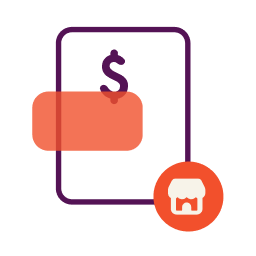
Start your business credit journey
Build business credit, monitor credit health, and accelerate growth — all with Nav Prime.
What are Pro Forma Financial Statements?
Pro forma financial statements essentially forecast the future. Standard accounting statements like the balance sheet look at historical financial information, but pro forma documents look forward to help you predict future income through different types of accounting statements. A pro forma small business statement may include projected revenue, estimated expenses, and cash flow for three to five years.
Types of Pro Forma Statements
- Full-year pro forma projection
- Historical with acquisition pro forma projection
- Financing or investment pro forma projection
- Risk analysis pro forma projection
There’s no single pro forma income statement. In fact, there are several pro forma financial statements, and you may want to use more than one to get a full financial picture of your business.
Full-Year Pro Forma Projection
This pro forma projection includes a business’s year-to-date results as well as forecasted income and expenses for the rest of the year to provide a full year view. This pro forma projection is useful to investors and lenders, who want reassurance that your business is slated for profitability.
Historical with Acquisition Pro Forma Projection
If you plan to acquire another business, this is the right pro forma statement for you. It combines your business’s accounting results with that of the business you want to acquire, subtracting acquisition costs and synergies, and therefore shows a rough sketch of how the acquisition will blend into your balance sheet.

Get the credit your business deserves
Join 250,000+ small business owners who built business credit history with Nav Prime — without the big bank barriers.
Financing or Investment Pro Forma Projection
If you plan to seek funding from investors or small business loans , you may be asked for revenue projections. This statement specifically deals with how your company’s results will change if you receive an infusion of capital. You may want to create financial projections for different investment amounts to cover your bases.
Risk Analysis Pro Forma Projection
Whenever you’re engaged in financial decision-making, you need to know best- and worst-case scenarios. That’s where pro forma risk analysis comes in handy. By creating pro forma reports for a variety of scenarios, you can see the expected results of how a decision will have an impact on your bottom line and make your decisions accordingly.
Three Most Important Pro Forma Financial Statements
In addition to the pro forma financial statements listed above, there are others that you will find useful in your company, even if you’re not planning a major change like taking on investments or acquiring another company.
- Pro forma income statements
- Pro forma balance sheets
- Pro forma cash flow statements
Pro Forma Income Statements
Also known as a profit and loss statement or P&L, this accounting document shows sales transactions and expenses, as well as cost of goods sold (COGS)/cost of services sold and projected net income and profit.
Pro Forma Balance Sheets
The pro forma balance sheet looks at a forecast after a change or proposed transaction, like financing, adding a line of credit, a big capital investment, or acquisition. It includes current assets and total liabilities, as well as accounts receivable, cash and cash equivalents, accounts payable, and inventories.
Pro Forma Cash Flow Statements
Another of the pro forma reports you should know about is the cash flow statement. It looks at the likely amount of cash flowing into and out of the business over a future period, based on different scenarios.
Why Create Pro Forma Statements?
So if you’re already using GAAP financial statements and financial reports, why would you go to the trouble of creating pro forma financial information? There are several situations where having a pro forma income statement or other report can come in handy.

Access better funding options with a solution you can’t get anywhere else
Improve your business’s financial health profile, unlock better financing options, and get funded — only at Nav.
Seeking Financing
Whether you’re applying for an SBA loan or looking to bring investors on, the individuals you want to work with want reassurance that your business is a good investment. Looking back at historical financial statements is helpful, but if you’re planning big changes, the past may not be an accurate portrayal of what the future holds.
Lenders and investors want reasonable assurance that their investment will not only be paid back, but that they will see a positive return on it. Pro forma financial information can help them assess that likelihood.
Planning for the Future
While we can never know what the future holds, we can make some educated forecasts about what it might look like with pro forma income statements. Looking at a few scenarios ranging from worst case to best, you can see what the impact of these changes might be and use this information to guide your decisions.
Anticipating Changes
If you are considering acquiring another company or pivoting the direction your business is headed, you’ll want to understand how that will impact your income. Creating a pro forma cash flow statement can help you determine how quickly you will become liquid after this transaction, and you can also determine how many more liabilities it will create.
Nav’s Final Word: Pro Forma Financial Statements
Yes, creating pro forma statements requires more work, but it pays off in showing you exactly what your future net income, liabilities, and cash on hand would be under certain circumstances.
Pro forma projections aren’t written in stone. Certainly, conditions will change, and that will impact your balance sheet. But these accounting tools can provide you (and your investors) peace of mind in knowing that a financial move is likely to pay off over time.
To create pro forma financial statements, you can enlist the help of a certified public accountant (CPA) or use a template.
Nav can help you find business financing, small business loans, or business credit cards you’re most likely to qualify for, using data like your business credit scores and annual revenue. Sign up for a Nav account to see your options.
Frequently Asked Questions About Small Business Pro Forma Statements
What is the difference between an income statement and a pro forma income statement?
The word “pro forma” means “as a matter of form” in Latin. A pro forma income statement is a type of income statement that serves as a financial forecast, using financial modeling based on past financial reports and your future business plans.
What are two items that are excluded from pro forma income?
Pro forma income statements may not include expenses that aren’t recurring or expenses that aren’t considered normal to the company’s operations. This can include charges for restructuring, write-offs or paydowns for intangible assets, or expenses that the company uses equity to pay with. Because these aren’t part of regular operating income, they don’t factor into the future that your pro forma income statements are projecting.
What are examples of pro forma financial statements?
Common pro forma financial statements include: – Pro forma income statements – Pro forma balance sheets – Pro forma cash flow statements Each of these can be used for the following purposes: – Full-year pro forma projection – Historical with acquisition pro forma projection – Financing or investment pro forma projection – Risk analysis pro forma projection
Is a pro forma the same as a P&L?
A P&L (or profit and loss statement) is the same as an income statement, but they are not the same as a pro forma financial statement. You can have a pro forma P&L just as you would a pro forma income statement. Business owners use pro forma income statements to make projections on their financial position in the future and help them make better business decisions.
This article was originally written on June 2, 2020 and updated on October 7, 2022.
Rate This Article
This article currently has 15 ratings with an average of 4.5 stars.

Susan Guillory
Susan Guillory is an intuitive business coach and content magic maker. She’s written several business books and has been published on sites including Forbes, AllBusiness, and SoFi. She writes about business and personal credit, financial strategies, loans, and credit cards.
Have at it! We'd love to hear from you and encourage a lively discussion among our users. Please help us keep our site clean and protect yourself. Refrain from posting overtly promotional content, and avoid disclosing personal information such as bank account or phone numbers. Reviews Disclosure: The responses below are not provided or commissioned by the credit card, financing and service companies that appear on this site. Responses have not been reviewed, approved or otherwise endorsed by the credit card, financing and service companies and it is not their responsibility to ensure all posts and/or questions are answered.
Leave a Reply Cancel reply
Your email address will not be published. Required fields are marked *
Save my name and email in this browser for the next time I comment.
2 min read — Published 6 months ago
How to Make a Pro-forma Income Statement
More than just a financial exercise, it can become your roadmap for how to approach hypothetical scenarios.

Key Takeaways
- Pro forma income statement allows startups to create a hypothetical projection of your income and expenses.
- The foundation of a pro forma income statement focuses on various assumptions to make accurate quarterly or annual projections of revenue and expenses.
- In creating pro forma income statements, it is advisable to create a revenue model that helps you model out different scenarios with different assumptions. Always sense check assumptions and overall outcomes to make sure your numbers make sense.
- Pro forma income statement is an effective way to get ready for unforeseeable business hurdles, increased taxes, growth plans, and acquisitions.
- A pro forma income statement is an effective way to gain the attention of potential investors, convince them on your growth plans and seek funding.
Introduction
Today, pro forma financial statements have become essential tools for startup founders. It is an effective way to plan ahead of time and predict, control, and analyze risks associated related to business funds.
Contrary to misguided perception, pro forma financial statements are not reserved for big corporations. In fact, small startups can use pro forma financial statements to understand their current financial value and make calculated future predictions.
Without further ado, let’s take a look at what is a pro forma income statement and how you can get one made for your startup.
What is a pro forma income statement?
As a startup founder, you need to think of a pro forma income statement as a hypothetical report on specific scenarios.
Pro forma statements essentially revolve around the “ what if ” formula for founders of a startup. Whether you “might” lose an account or make an acquisition, pro forma financial statements allow a glimpse into the future.
Ultimately, it involves financial projections and assumptions that allow you to make calculated and logical business decisions. For decades, the proforma income statement has been a useful tool for startup founders, investors, and key decision-makers to examine the future financial health of the business.
Pro forma income statement, however, gains a different meaning under the scope of public companies. In any case, whether you want to purchase new equipment, undertake a new debt, or acquire another establishment, you will need to draft a pro forma income statement to determine the cause-and-effect of the decision.
In comparison, conventional financial statements paint the financial situation of the past, whereas a pro forma financial statement, including an income statement, showcases the future financial health of the startup.
Why do you need a pro forma income statement?
You can use a pro forma income statement to review the projected operational business costs against the current fiscal budget. You can use this benchmark data to figure out whether or not you will expect high expenses in the first quarter as opposed to the second quarter of the year.
You can also use the benchmark data of the pro forma income statement to find out whether or not you will have above-average sales growth in a given year. Similarly, you can use the data to review and decide whether or not you should spend more on your marketing campaigns in the fall months.
When fundraising, pro forma statements are useful in giving investors a sense of your revenue growth potential.
Key considerations for a startup
Often, founders are surprised how much pro forma income statement can be advantageous to their startup operations in the foreseeable future. At its core, you have to think of a pro forma income statement as a strategic planning tool to move forward in the right direction.
Pro-forma Income Statement Considerations
When it comes to the pro-forma income statement, there are several uses, benefits, and subjective considerations you need to know.
Potential Investors Will Likely Ask For This
One of the main reasons to make a pro forma income statement is to capture the attention of potential investors. You can draw the attention of potential investors by announcing your future earnings.
It is an effective way to secure funding and achieve growth in a short time. You can use the same method to secure more funding later on. Pro forma income statement also helps a startup to avail the most suitable financing option from investors.
Ability to Analyze Risks
You can use pro forma income statement projections to establish best and worst case financial scenarios. This helps you realize the range of outcomes your startup can realistically expect in terms of your income.
Positive and ambitious scenarios may paint a rosy picture. On the other hand, you can also get projections that would deplete your startup’s capital and create financial challenges.
Your goal should be to observe and analyze the cost-benefit ratio of each situation and prepare accordingly based on your plan. As you track metrics along the way, you'll be able to course correct and remodel what the future looks like.
For instance, if you want to roll out a new product in the market that would cost you $1 million of equipment and marketing costs, you can add in assumptions on product growth - conservative and ambitious to analyze how the range of outcomes plays on your startups financial health. This will help you figure out the underlying sensitivities (e.g. maybe customer churn is a huge factor that needs preventative measures).
Potential Limitations
While a pro forma income statement serves as an insightful way to learn about hypothetical financial scenarios, it is vital to take into account that projections are based on educated “assumptions.”
The key is not to confuse assumptions with facts and projected figures with accurate calculations. In fact, take each pro forma income statement figure with a grain of salt. You have to assume that there is a real possibility that the projected figure may not be accurate.
It is better to be cautious and assess the projected pro forma income statement calculations along with the rest of the financial documents to get more accurate and updated projections.
Changing Rules
The SEC (Securities and Exchange Commission) has the reputation to consistently update and change its strict rules and regulations on pro forma financial statements. However, SEC rules apply specifically to public companies.
Unlike historical financial statements, you should be aware of the fact that there is no regulation in place on the pro forma income statement and balance sheet. However, to entice investors through optimistic projections, make sure not to stray away from standard accounting practices.
Steps to make a pro forma income statement for a startup
Technically, a pro forma income statement is not so different from a traditional income statement that includes past performance and financial health of the company. But as mentioned earlier, a pro forma income statement projects the future financial health rather than the past.
The projections serve as windows of opportunities for startup founders to increase the production capacity and drive growth in a startup. You can pay close attention to the possible fluctuations in costs in advance.
Once you understand the purpose, importance, and practicality of making pro forma income statements, you can draft them. When you make a pro forma income statement, make sure you are as detailed as possible throughout the process.
Here’s a quick step-by-step approach to create and calculate various aspects of the pro forma income statement:
Step #1 Create baseline
Your first step to producing a pro forma income statement starts by focusing on the current and previous fiscal years. Create a baseline of your income statement as your current state (if you don't change anything) assumptions.
The idea here is to understand how you grow and your baseline revenue and cost growth rates.
Step #2 Add in your assumptions
Your next step is to determine your assumptions for the next 3-5 years. You will do so by looking at two factors:
- Internal factors - Taking your current year (or trailing 12 months) as a baseline, understand current and future drivers of revenue. Do you plan on upping your salesforce? Do you plan on investing in additional marketing channels? How would these drivers impact your revenue? What's the lead time for these factors to show an impact on your revenue? For instance, if you plan to ramp up the sales team, you need to factor in the ramping time before this shows an impact on your revenue.
- External factors - Factor in market, competition, and/or regulatory changes that might impact your product's growth. For instance, GDPR preparedness can impact your timeline on when you would expand to Europe. Alternatively, market reports can help you understand growing trends in customer demand - e.g. the adoption of cloud-based SaaS products over traditional on-premise software can give your company an edge if you play in this field.
It usually helps to build out a revenue model where you can add in your assumptions and sense check numbers to see if they make sense before you plug into your income statement. This way, you can do step #4 (pressure test the numbers and really question your assumptions and your ability to achieve them) before you plug into your financial statements. This will save you time in iterating on your financial statements.
Step #3 Plug into the income statement
As you figure out your growth assumptions, identify the underlying costs and revenue impact it may have on your business. You will need to add both sides into your projected income statement.
Keep in mind the segregation of costs that you'll need to plug in - i.e. cost of sales? salaries of salesforce? marketing expenses? These will have to be rightfully plugged into the right areas.
Here's a good template you can use to format and create your 3-year pro-forma income statement.

Step #4 Pressure test assumptions
The last step is usually the most important. Your assumptions are only as good as your baseline information that feeds them. Make sure your revenue, expenses, and growth numbers make sense and are error-free. If certain initiatives you had planned haven't given you the returns you expected, it's unlikely they will in the future unless something has changed.
Have multiple team members review your model and your assumptions. Creating different scenarios - conservative, likely, and ambitious can help you understand the range of outcomes and help you set targets and plan for stable, sensible progress.
Here's a simpler example of a pro-forma income statement:

Templates & guides
- Understanding the basics of an income statement
- Understanding the importance of proforma statements
- Downloadable Excel templates for proforma statements
- Revenue models for startups
About the author

Kristin Bass
Kristin Bass has helped over 100 companies navigate the confusing world of state compliance. Prior to her role as the CEO of AbstractOps, she worked as an Operations Analyst at FIS Global. She holds an MBA from East Carolina University and has a deep love for animals, especially her two labrador retrievers.
Share this post
Subscribe to Kristin's newsletter
I share actionable tips for founders, HR leaders, and accounting operators looking to calm the anxiety of state payroll and entity compliance.
Don't worry, we'll never share your email with anyone else
Read more like this

How Peter Tamed the 'Anger' of Payroll Tax Compliance

Commenda x AbstractOps Empower Growth for Global Companies

Rollfi and AbstractOps Streamline Payroll and Entity Compliance
© 2024 AbstractOps
Follow Kristin on LinkedIn
Start AbstractOps Product Demo
The top 5 misconceptions about state compliance
How much does state compliance help cost
Why we added AI at no additional charge
Sam Altman tells OpenAI staff there's no plan for him to receive a 'giant equity stake' in company

At an all-hands meeting Thursday, OpenAI CEO Sam Altman denied that there are plans for him to receive a “giant equity stake” in the company, calling that information “just not true,” according to a person who was in attendance.
Altman and finance chief Sarah Friar both said at the meeting, conducted by video, that investors have raised concerns about Altman not having equity in the high-valued artificial intelligence company that he co-founded almost nine years ago, said the person, who asked not to be named because the gathering was only for employees.
Regarding his potentially attaining an equity stake, Altman said, “There are no current plans here,” the person said.
OpenAI Chairman Bret Taylor told CNBC in a statement that while the board has talked about the matter, no specific figures are on the table.
“The board has had discussions about whether it would be beneficial to the company and our mission to have Sam be compensated with equity, but no specific figures have been discussed nor have any decisions been made,” Taylor said.
The meeting late Thursday followed the board’s decision to consider restructuring the company to a for-profit business , according to a separate person with knowledge of the matter. Should the change occur, the nonprofit segment would remain as a separate entity, said the person, who asked not to be named because no plan has been finalized.
While directors consider OpenAI’s future, key executives continue to walk out the door.
On Wednesday, three execs announced their departures. OpenAI Chief Technology Officer Mira Murati, who briefly served as interim CEO, said she would be leaving after 6½ years. Later in the day, research chief Bob McGrew and Barret Zoph, a research vice president, said they were leaving the company.
In an interview Thursday at Italian Tech Week, Altman said, “I think this will be hopefully a great transition for everyone involved and I hope OpenAI will be stronger for it, as we are for all of our transitions.”
Altman said the departures were not related to the company’s potential restructuring, contrary to some media reports.
“Most of the stuff I saw was also just totally wrong,” Altman said at the event in Turin, Italy. “But we have been thinking about that, our board has, for almost a year independently, as we think about what it takes to get to our next stage. But I think this is just about people being ready for new chapters of their lives and a new generation of leadership.”
Murati wrote in a memo to the company that she’s “stepping away because I want to create the time and space to do my own exploration.” She said her focus will be on ensuring a “smooth transition.”
Before Thursday’s moves, OpenAI co-founder Ilya Sutskever and former safety leader Jan Leike announced their departures in May. Co-founder John Schulman said last month that he was leaving to join rival Anthropic.
OpenAI, which is backed by Microsoft , is currently pursuing a funding round that would value the company at more than $150 billion, people familiar with the matter told CNBC. Thrive Capital is leading the round and plans to invest $1 billion, and Tiger Global is planning to join as well.
While OpenAI has been in hypergrowth mode since the launch of ChatGPT in late 2022, it’s been simultaneously riddled with controversy and executive departures , with some current and former employees concerned that the company is growing too quickly to operate safely.
Altman was ousted in November, before being quickly reinstated. Almost all of OpenAI’s employees signed an open letter saying they would leave in response to the board’s action. Days later, Altman was back at the company and Murati moved from interim CEO back to the role of CTO.
More from CNBC:
- Oil alliance OPEC+ zeroes in on group compliance after postponing output hike
- Why analysts are calling Cava the next Chipotle
- Extra legroom, assigned seats: Inside Southwest’s plan for its future

COMMENTS
Business Plan Pro Forma Template and Example. The following is an example of a pro forma business plan: Executive Summary. In this pro forma business plan, we forecasted our company's sales, expenses, and capital expenditures over the next three years. We also estimated our funding requirements and outlined our plans for growth.
Pro forma means "for the sake of form" or "as a matter of form." When it appears in financial statements, it indicates that a method of calculating financial results using certain ...
In the online course Financial Accounting, pro forma financial statements are defined as "financial statements forecasted for future periods. They may also be referred to as a financial forecast or financial projection.". The course notes that these projections can be used "as a depiction of what the financial statements for the business ...
Traditional business plans use some combination of these nine sections. Executive summary. Briefly tell your reader what your company is and why it will be successful. Include your mission statement, your product or service, and basic information about your company's leadership team, employees, and location.
In this pro forma business plan, we forecast our company's sales, expenses, capital expenditures, and funding needs over the next five years. Our projections show positive net income, a strong financial position with increasing equity, and healthy cash flow, underscoring our business's viability and long-term potential. ...
Pro forma financial statements help businesses make informed decisions by evaluating hypothetical scenarios. Components of pro forma statements include income statements, balance sheets, and statements of cash flow. These statements are essential tools for strategic planning and assessing the impact of various business decisions.
Pro forma financial statements are used in a business plan to present the best-case, expected, and worst-case scenarios for a proposed transaction. With pro forma statements, businesses can better make assumptions on what decisions are best for the company, such as labor increases, production increases, or even expansion.
Pro forma statements help business owners play out the future outcome of their decisions. The next time you consider taking on new debt, create pro forma statements to see the impact on future income.
The pro forma shows the projected cash flow, net revenues, or taxes expected. The business plan will include pro forma financial statements that show the effect of the proposed change, project, or new business. Some banks require pro forma statements to verify cash flow prior to issuing a line of credit.
Pro forma definition. According to Merriam-Webster, "pro forma" means: Made or carried out in a perfunctory manner or as a formality. Based on financial assumptions or projections. Pro forma is actually a Latin term meaning "for form" (or today we might say "for the sake of form, as a matter of form"). When it comes to accounting ...
4 Main Types of Pro Forma Statements. There are four main types of pro forma statements that you can use to manage your cash flows and the financial health of your business. Pro forma balance sheets: This is similar to a traditional balance sheet as it shows the accounts receivable, your cash flow statements, and other pertinent financial ...
Mastering the pro forma business plan is a pivotal step to ensure your business thrives. Fine-tuning your business model involves scrutinizing every aspect, from costs to revenue, to pave the way for financial success. Let's delve into effective strategies to optimize costs and maximize revenue, ...
A pro forma statement projects the impact of those decisions, showing whether your company's financial health is expected to improve, decline, or remain the same after the event takes place. Pro forma statements can omit certain information. For example, a company may exclude one-time expenses, such as restructuring costs or a legal ...
Pro Forma Income Statement Explained. A pro forma income statement in business plan is the statement prepared by the business entity to prepare the projections of income and expenses, which they expect to have in the future by following certain assumptions such as competition level in the market, size of the market, and growth rate, etc.
A pro forma financial statement offers projections of what management expects to happen under a particular set of circumstances and assumptions. Standard financial statements are based on a company's historical performance. In contrast, the purpose of pro forma financial statements is to look to the future or to analyze hypothetical scenarios ...
Pro Forma Cash Flow Statement. Free Excel Template: Pro Forma Financial Statements. Creating a Pro Forma Income Statement. Step 1: Project Your Revenues. Step 2: Estimate Your Costs of Goods Sold (COGS) Step 3: Calculate Gross Margin. Step 4: Outline Operating Expenses. Step 5: Forecast Net Income.
Pro forma is Latin for "as a matter of" or "for the sake of form.". It is used primarily in reference to the presentation of information in a formal way, assuming or forecasting pieces of information that may be unavailable. In most cases, pro forma documentation is used to present a reasonable representation of what an anticipated ...
Pro forma financial statements project how a company might perform in the future if the business takes an assumed course of action. It may include a best-case or worst-case scenario. It may include a best-case or worst-case scenario.
A business plan is a document detailing a company's business activities and strategies for achieving its goals. Startup companies use business plans to launch their venture and to attract outside ...
A business plan is a comprehensive document that outlines a company's goals, strategies, and financial projections. It provides a detailed description of the business, including its products or services, target market, competitive landscape, and marketing and sales strategies.
Example of a Pro-Forma Forecast. For example, XYZ Company is a publicly-traded maker of widget presses. After many years of research and development (R&D), they have applied for a patent on a new ...
The business plan should have a section that explains the services or products that you're offering. This is the part where you can also describe how they fit in the current market or are ...
A pro forma small business statement may include projected revenue, estimated expenses, and cash flow for three to five years. ... Historical with Acquisition Pro Forma Projection. If you plan to acquire another business, this is the right pro forma statement for you. It combines your business's accounting results with that of the business ...
Pro forma income statement is an effective way to get ready for unforeseeable business hurdles, increased taxes, growth plans, and acquisitions. A pro forma income statement is an effective way to gain the attention of potential investors, convince them on your growth plans and seek funding. Introduction
The meeting late Thursday followed the board's decision to consider restructuring the company to a for-profit business, according to a separate person with knowledge of the matter. Should the ...